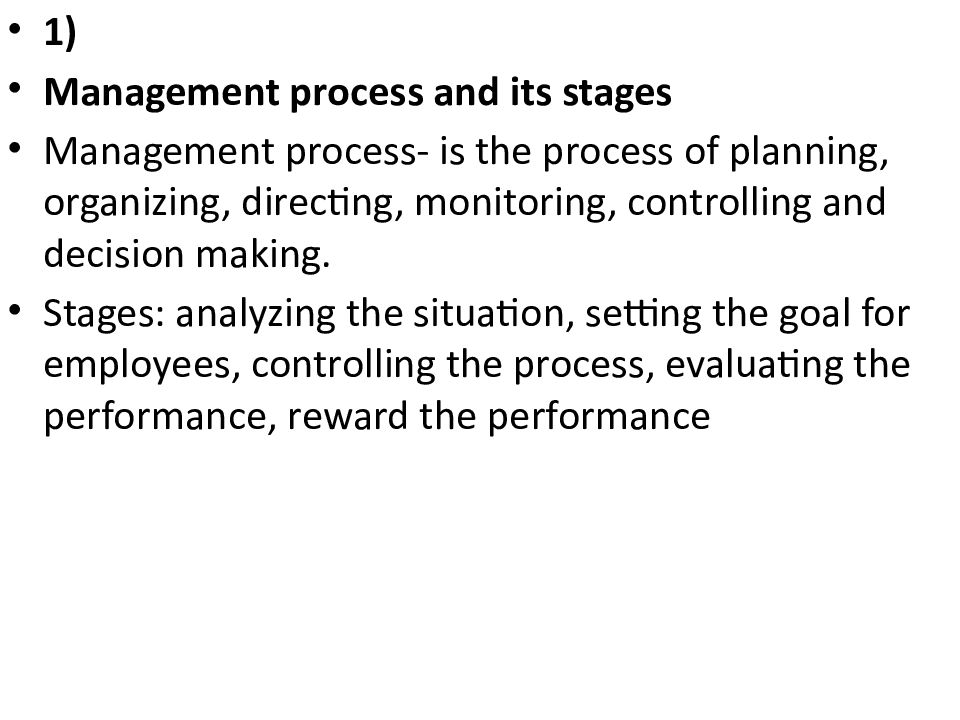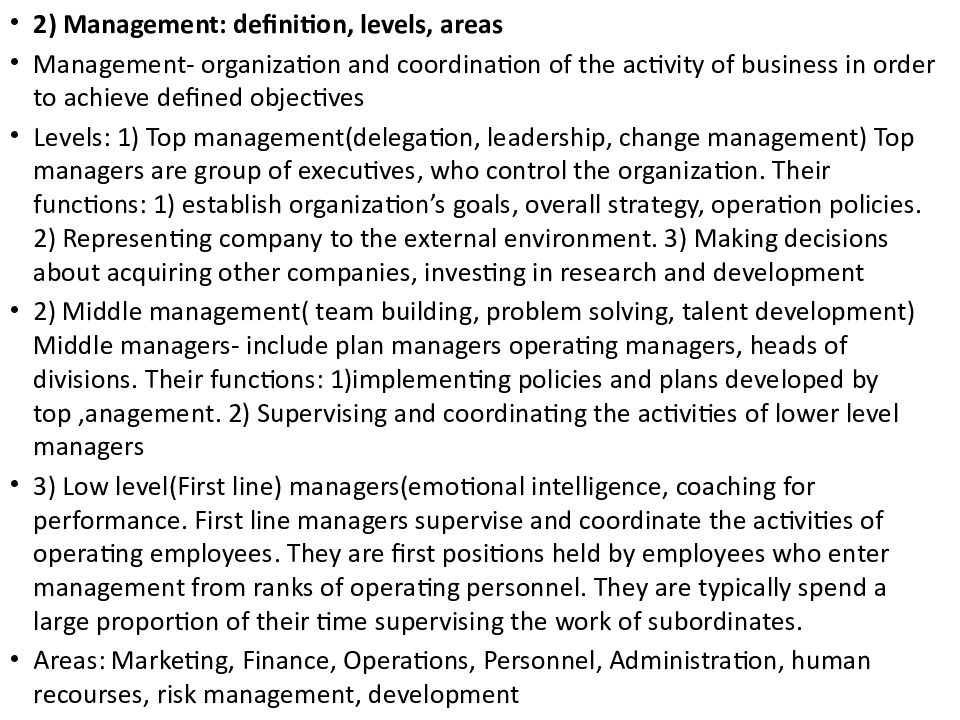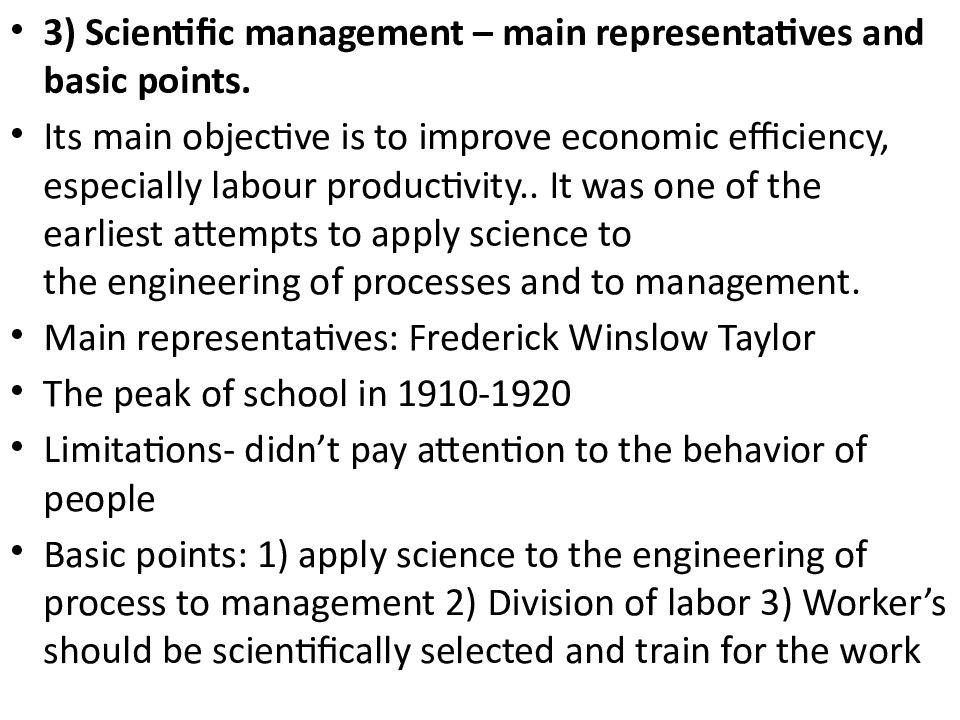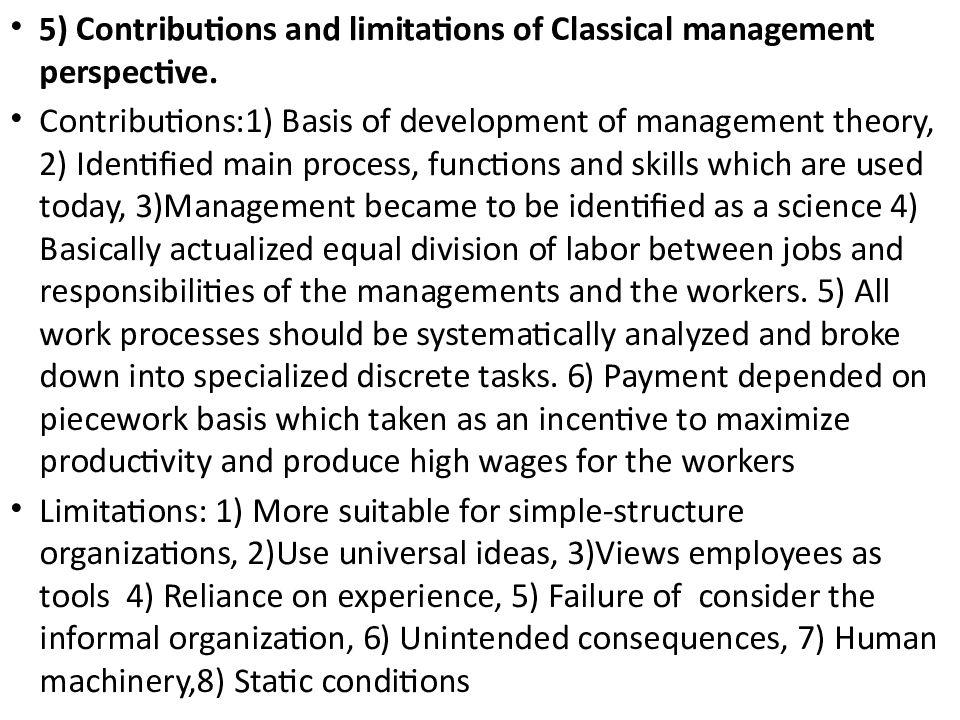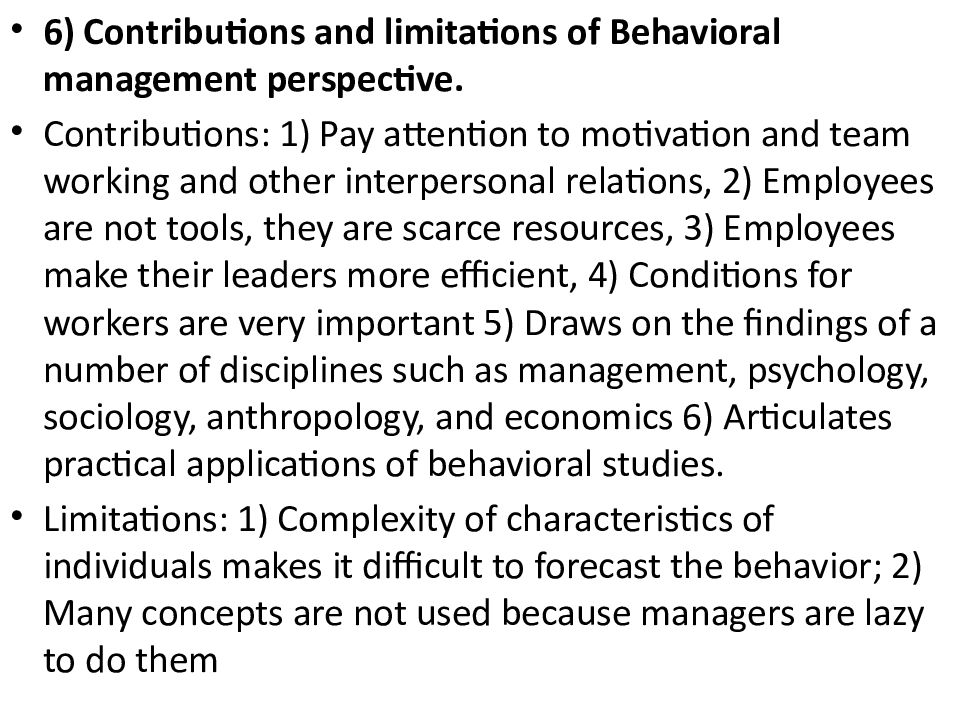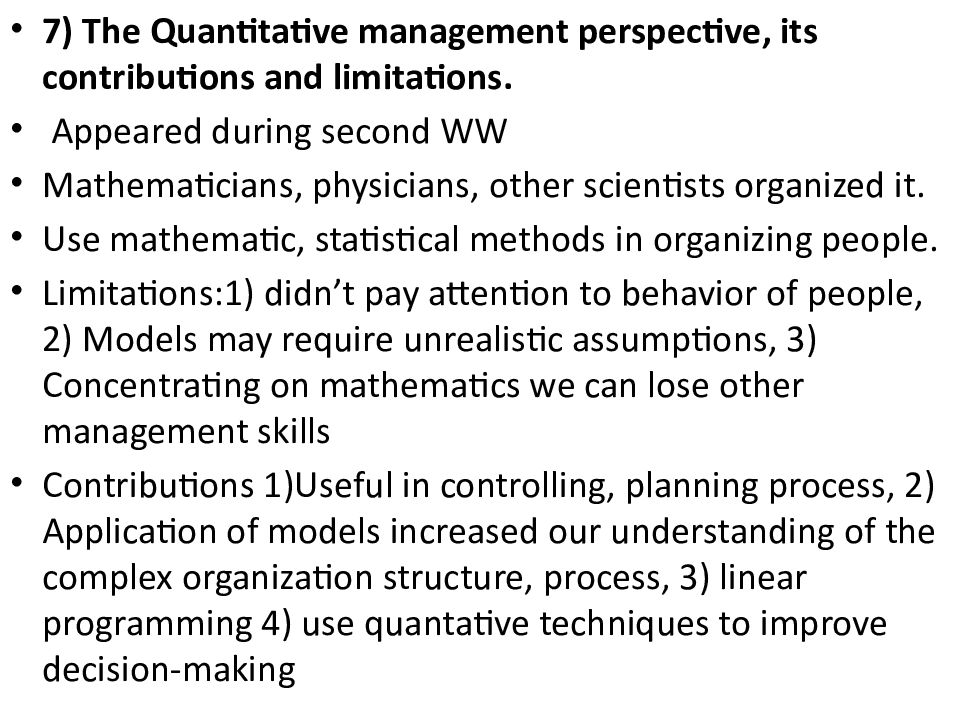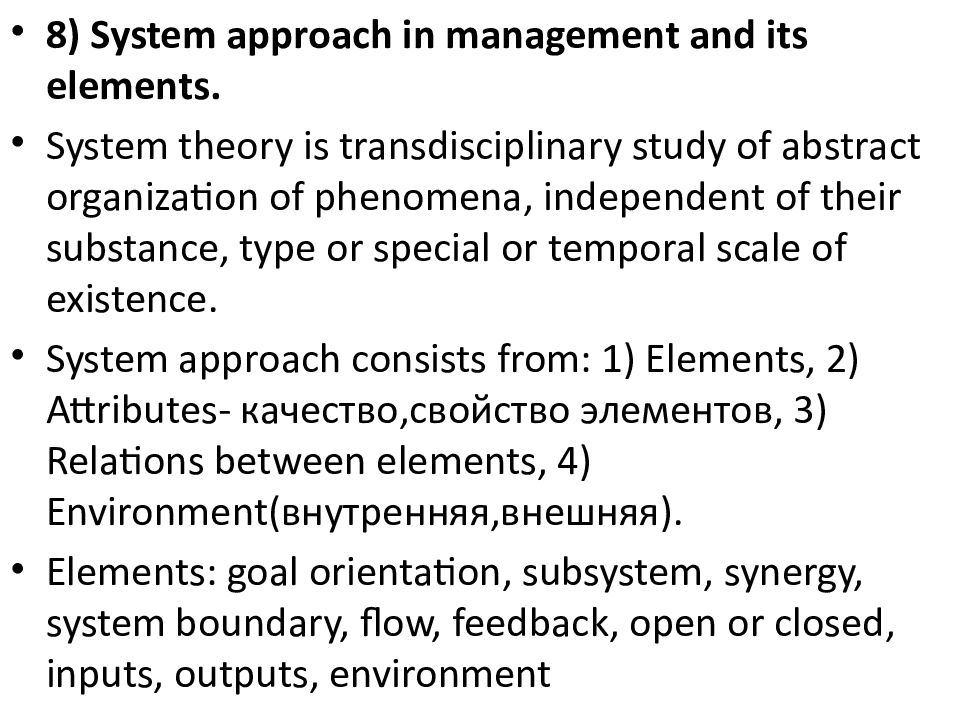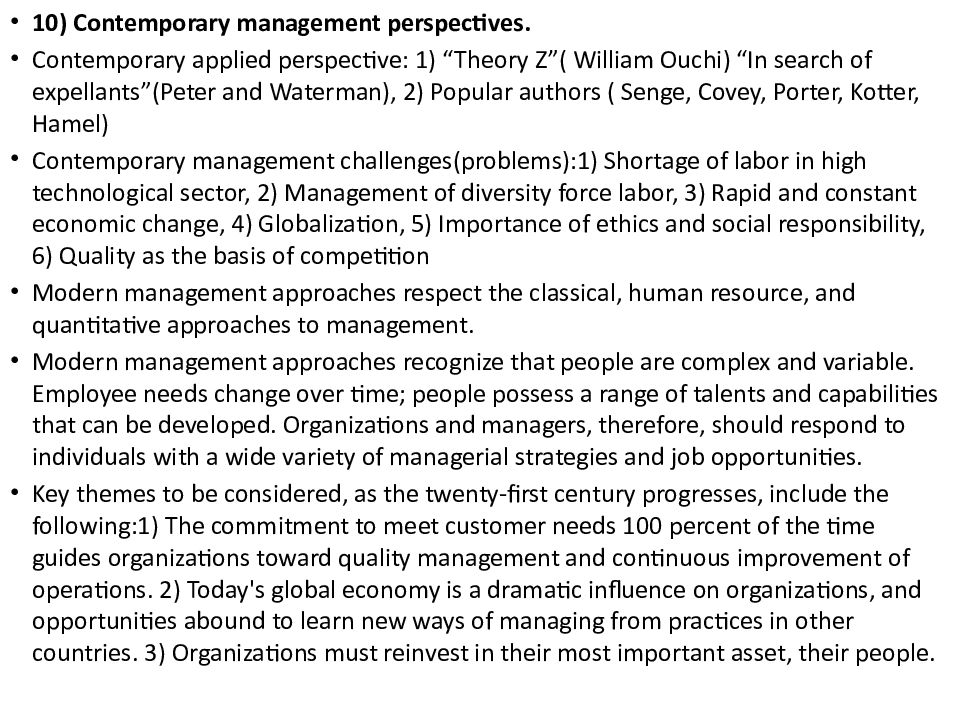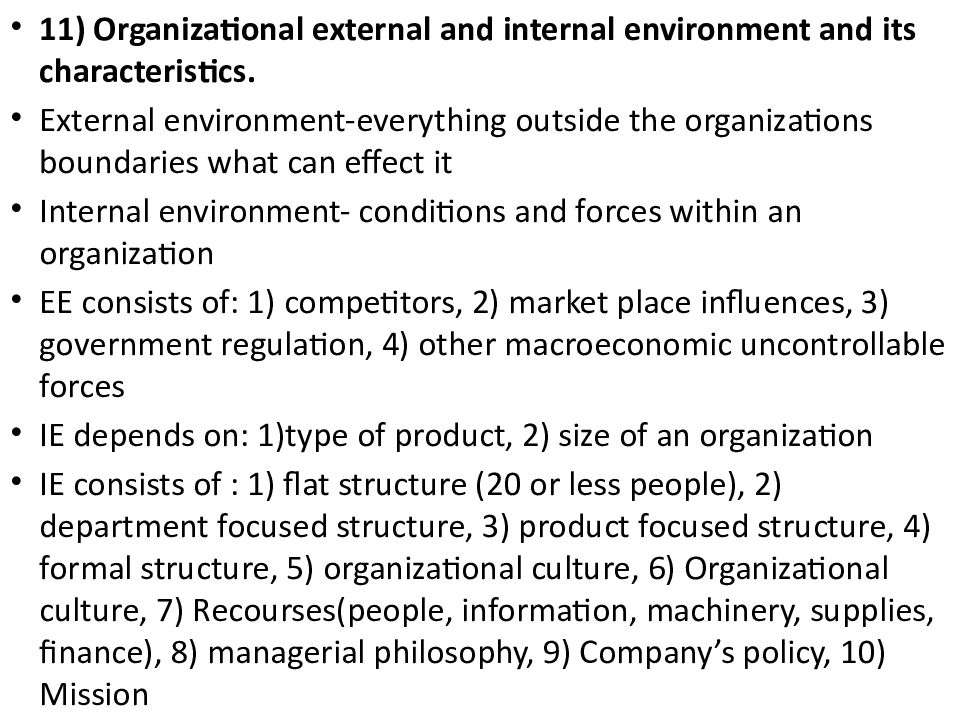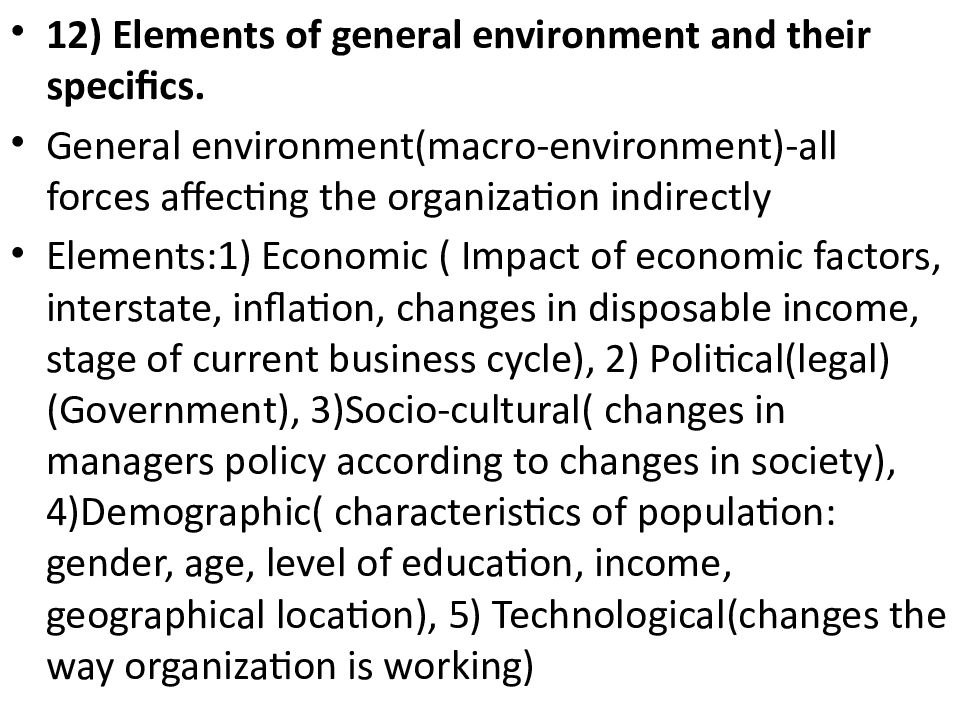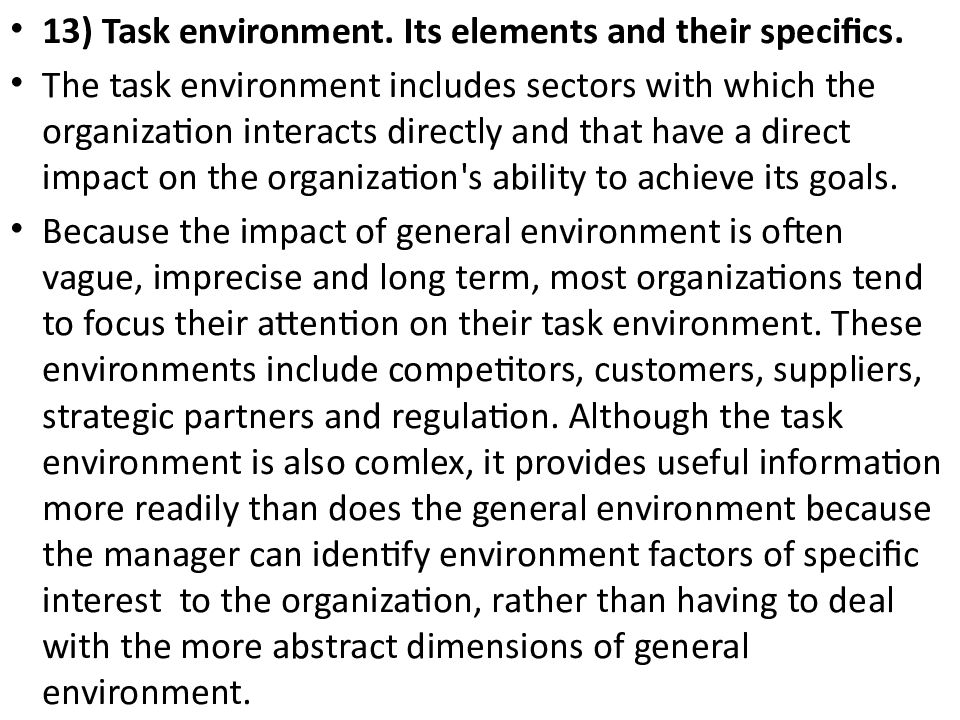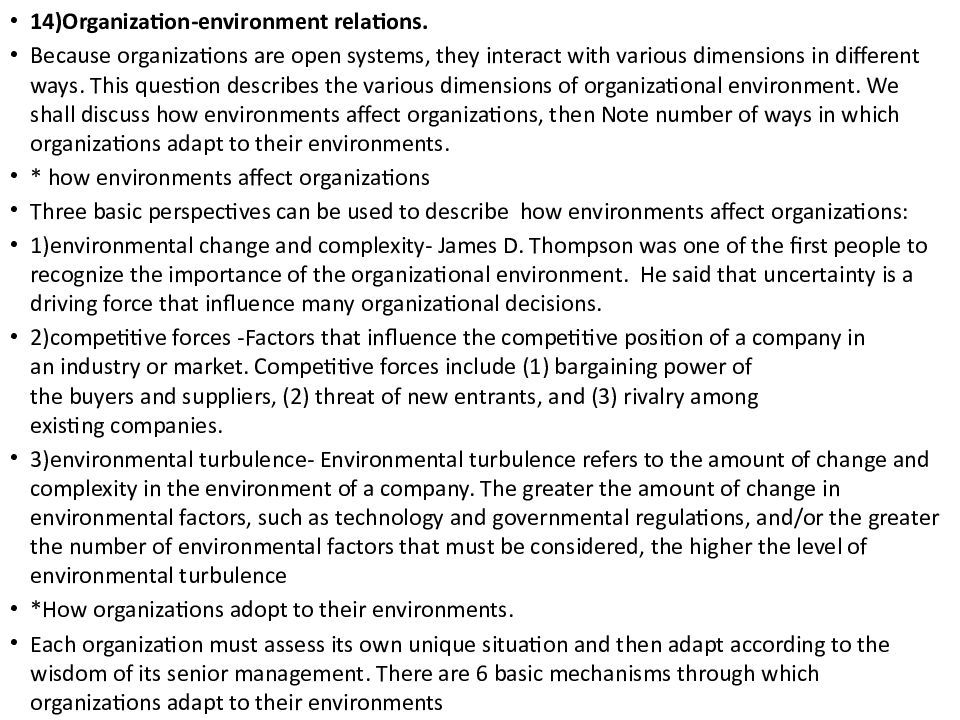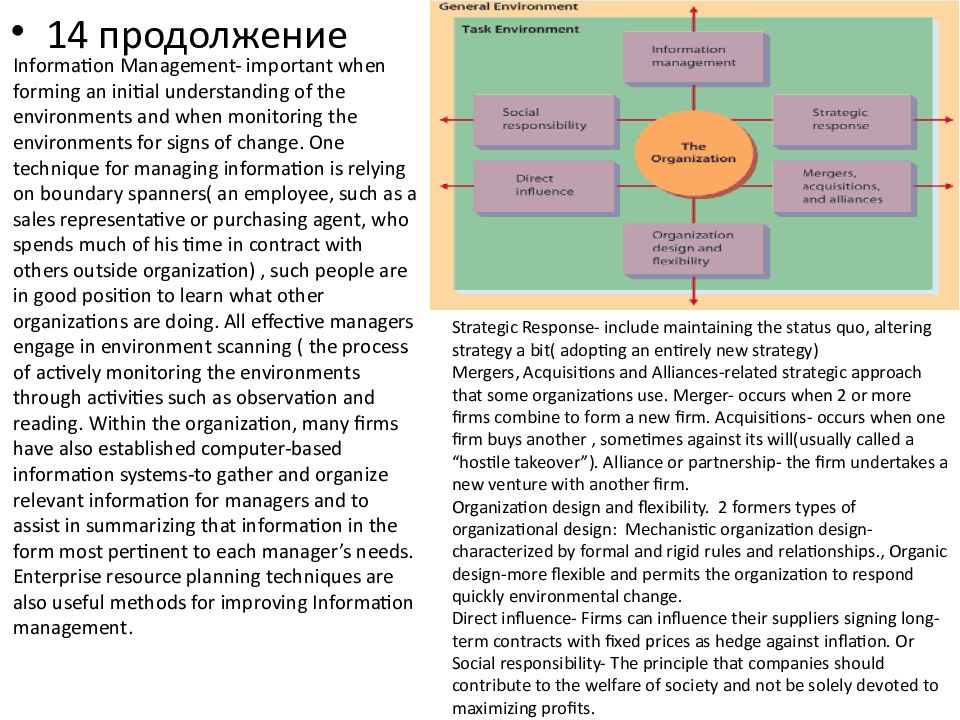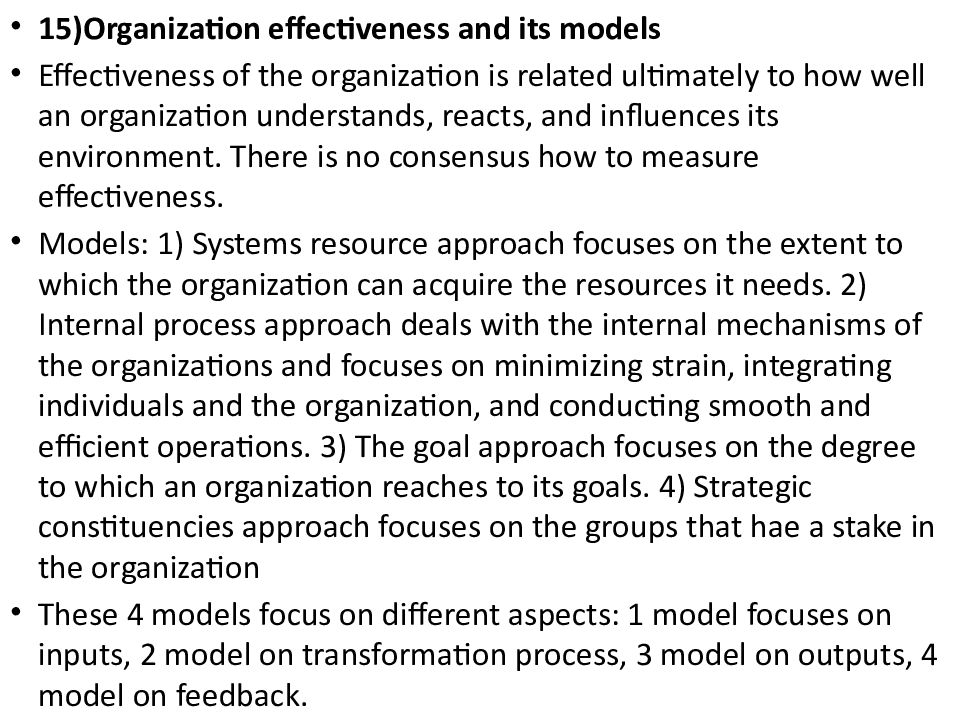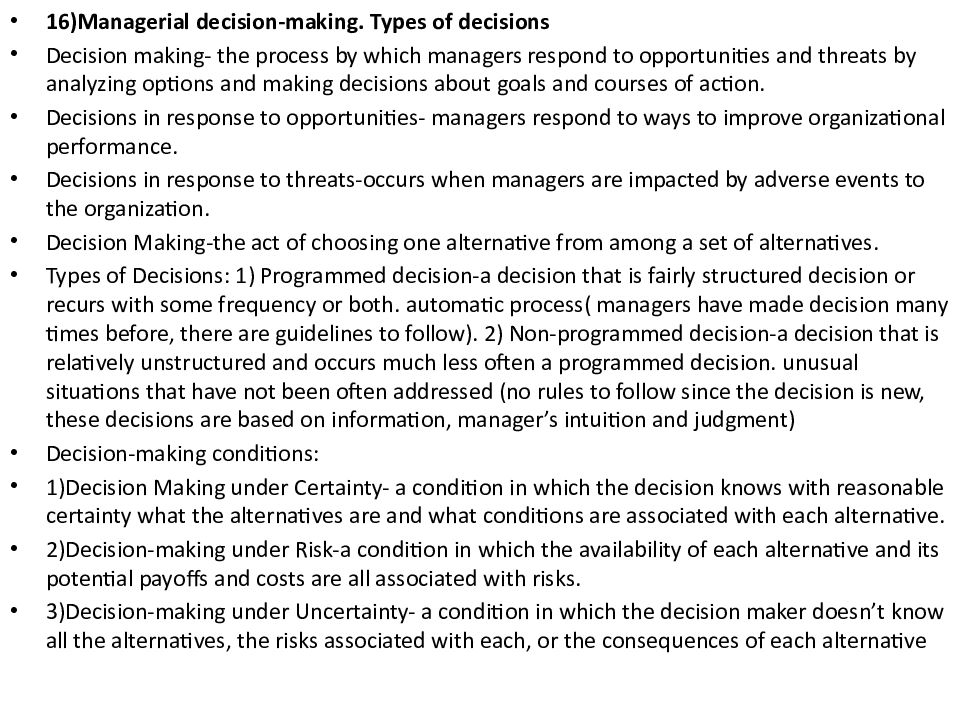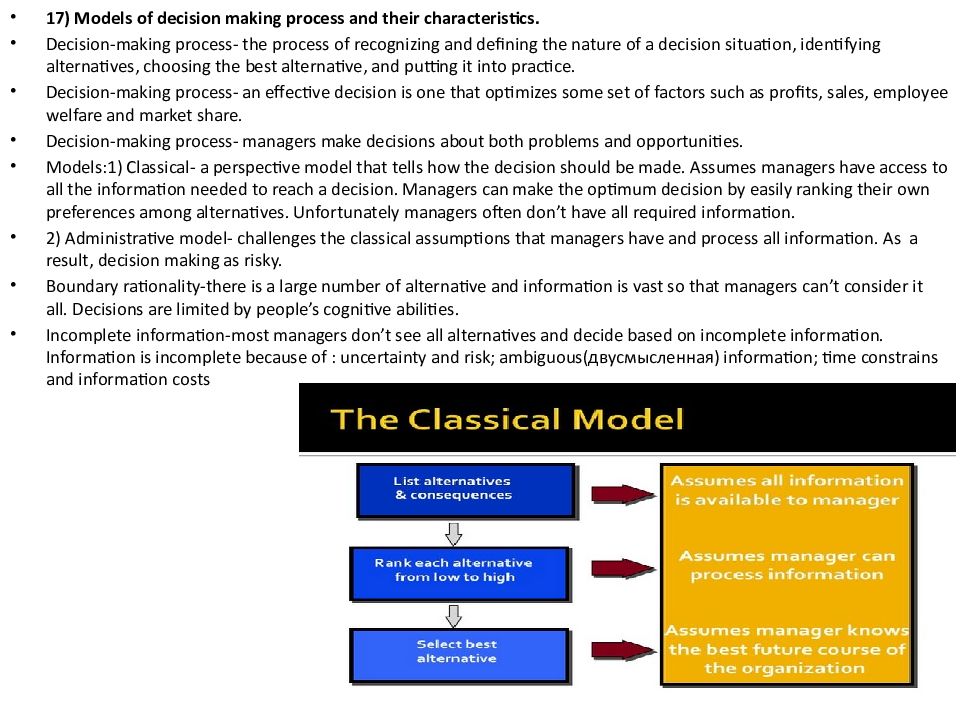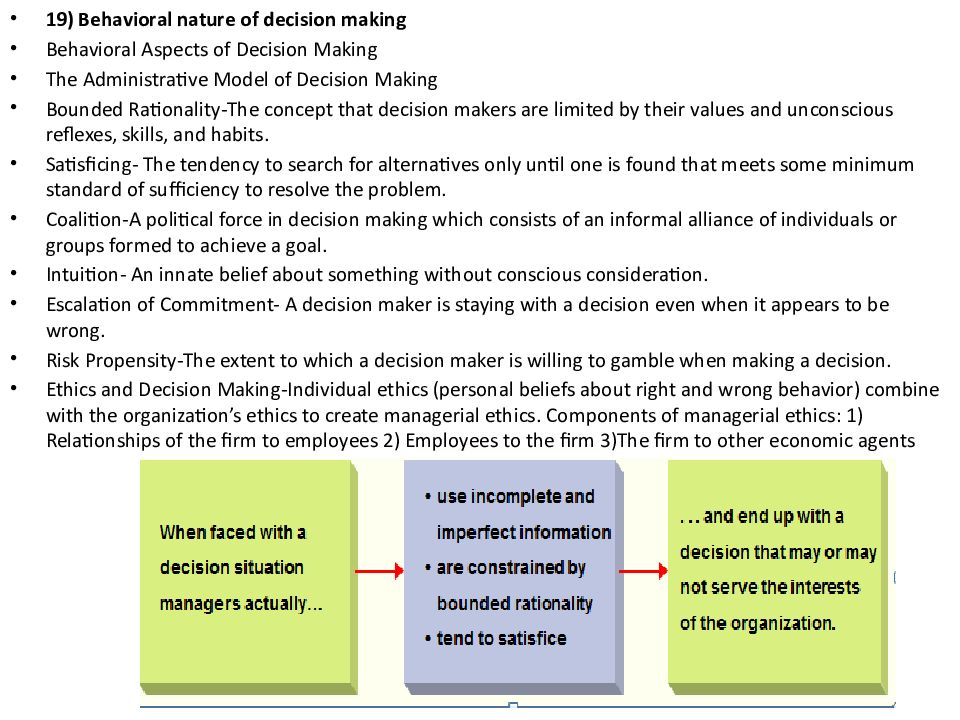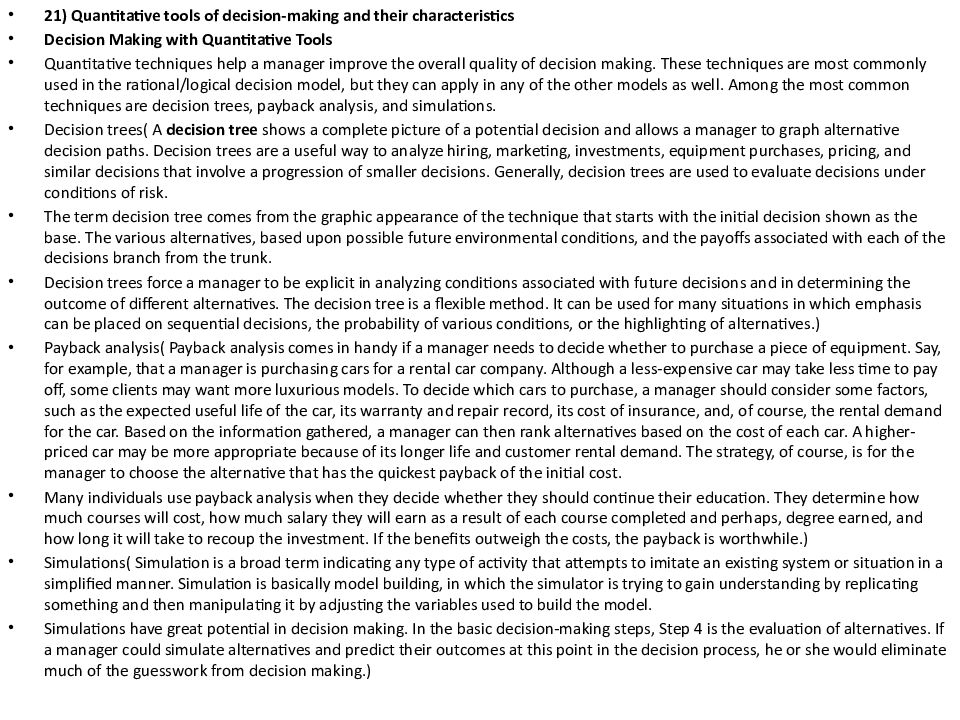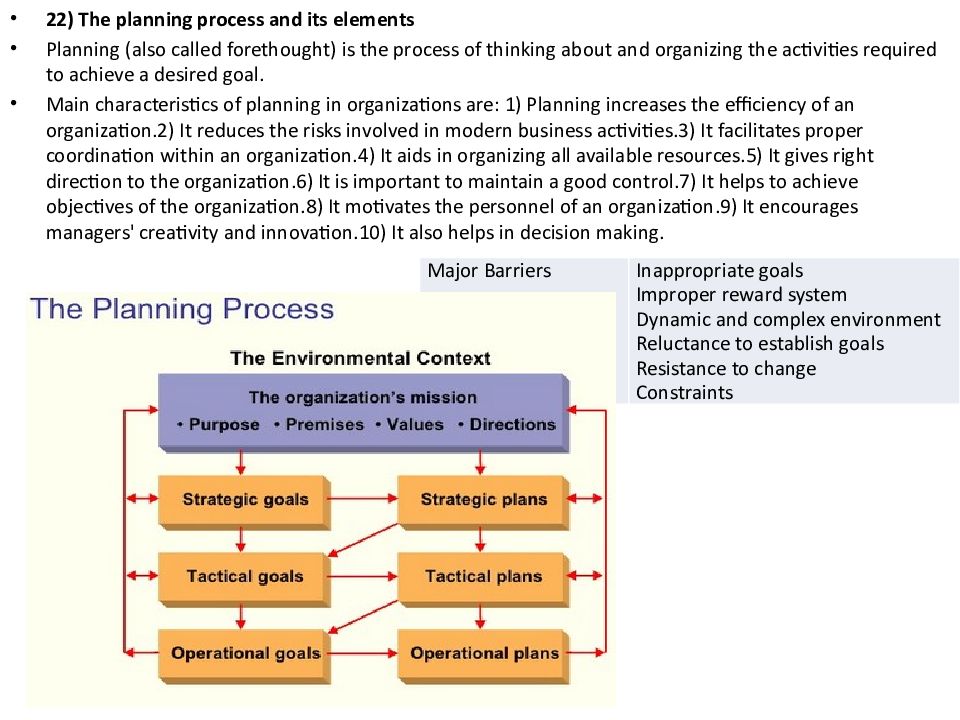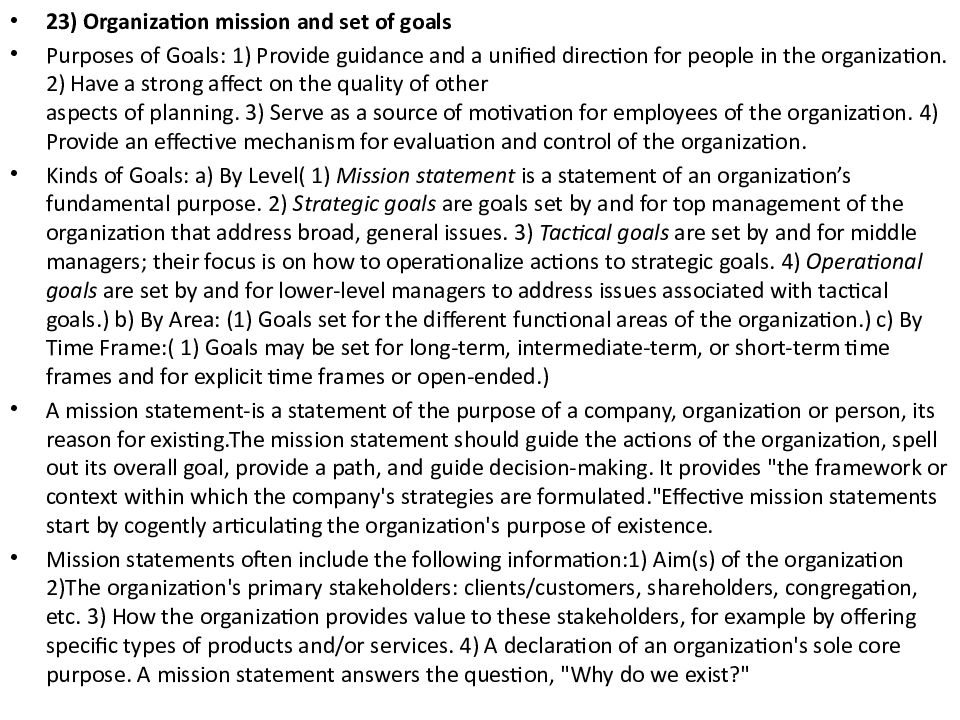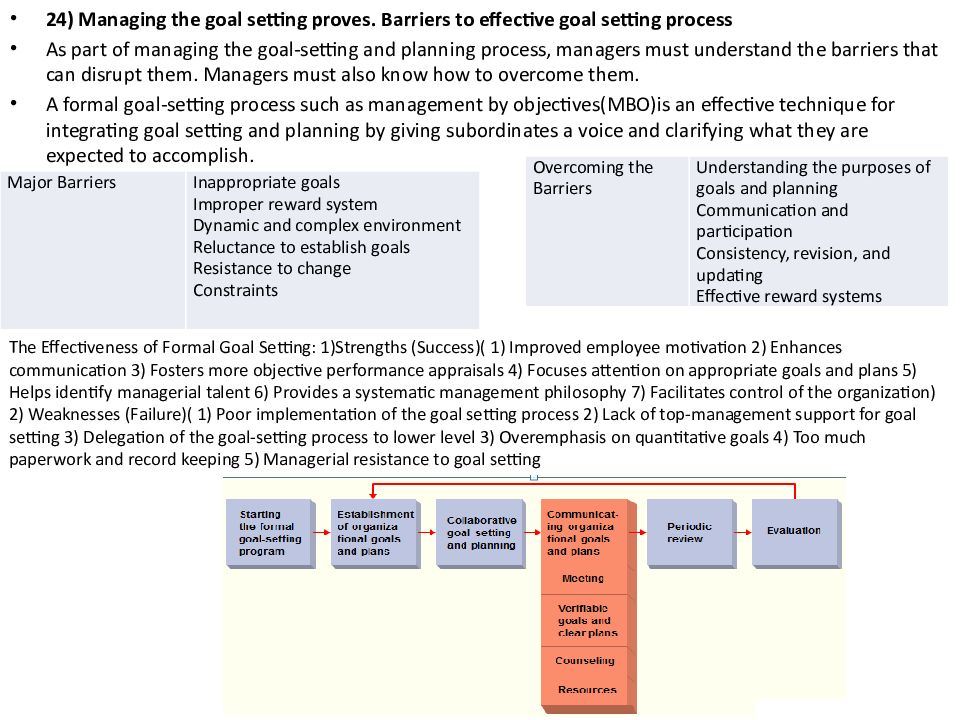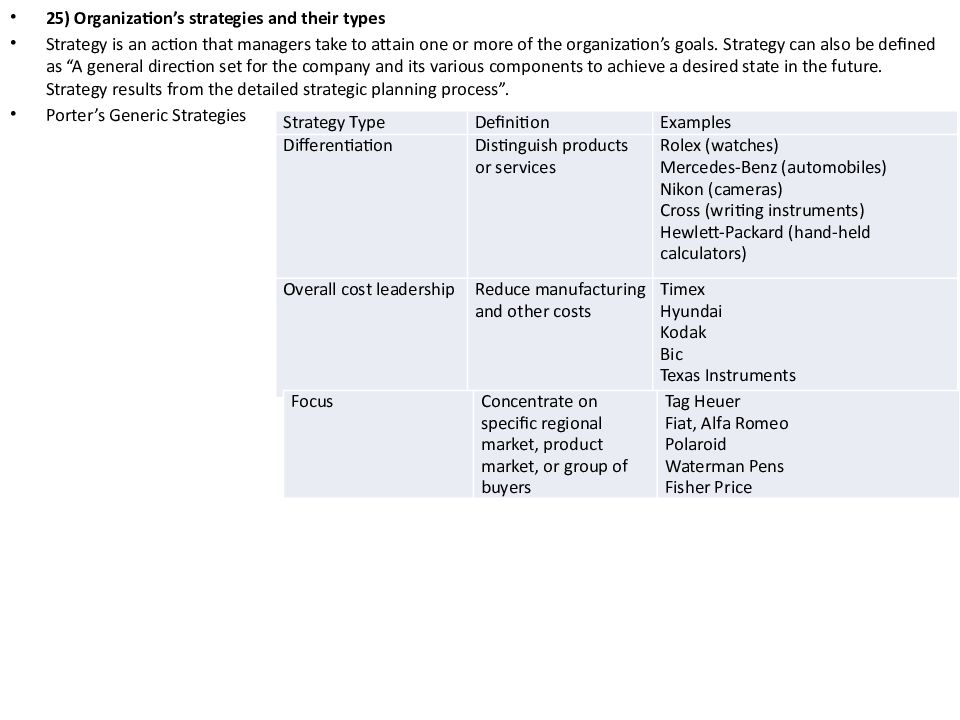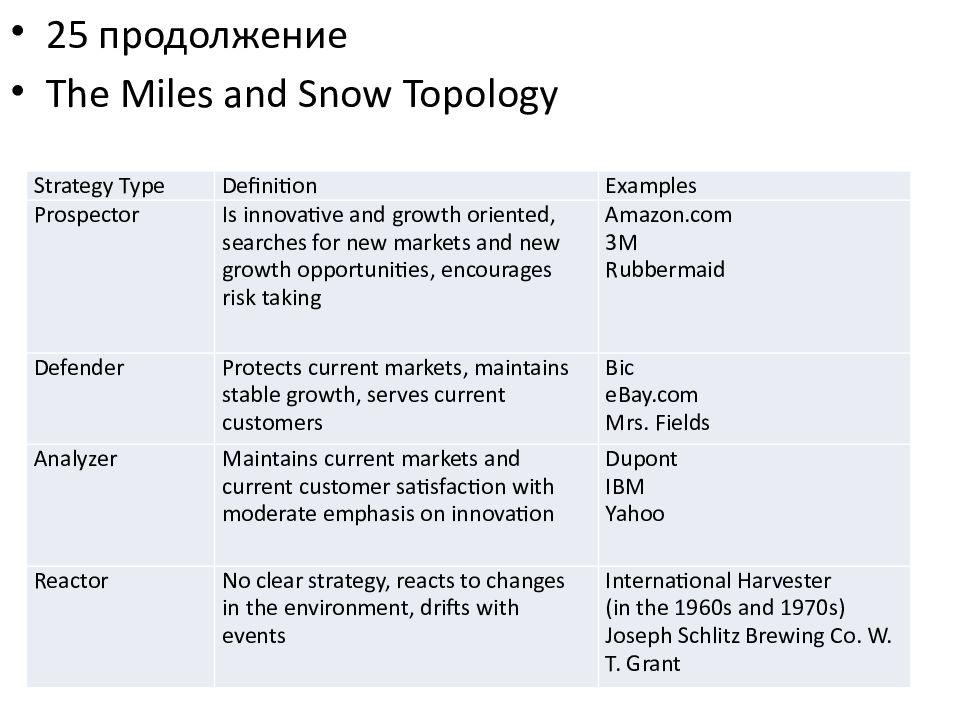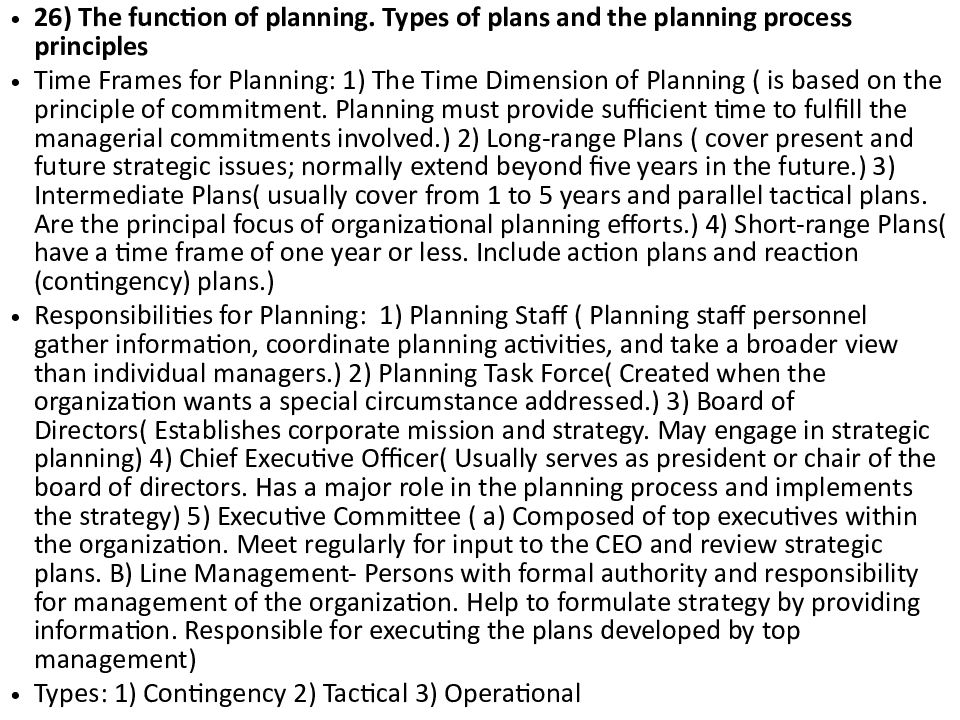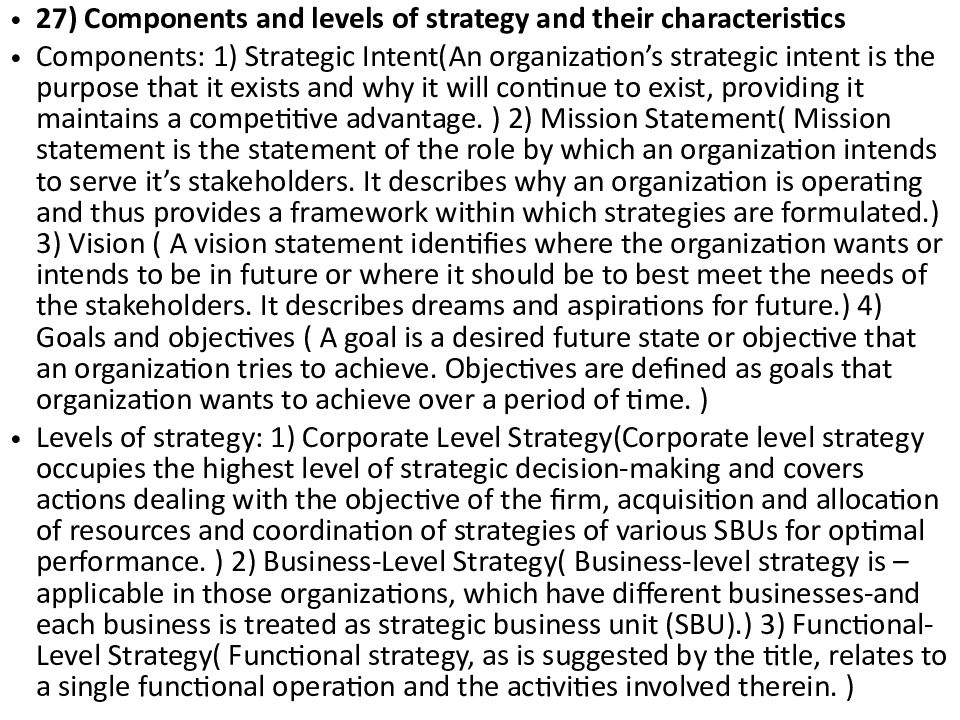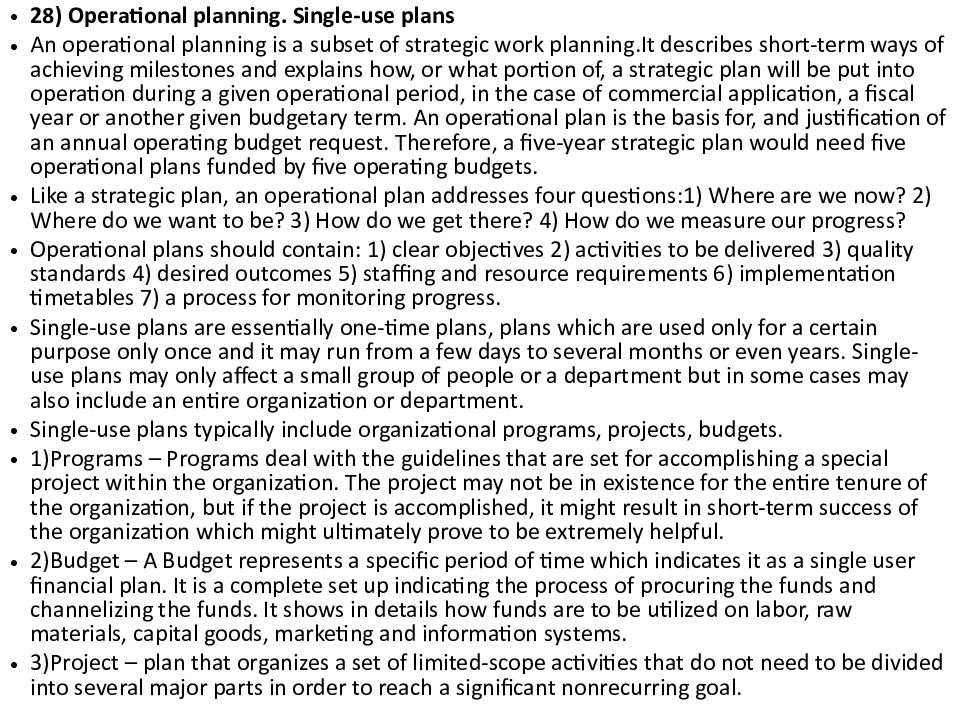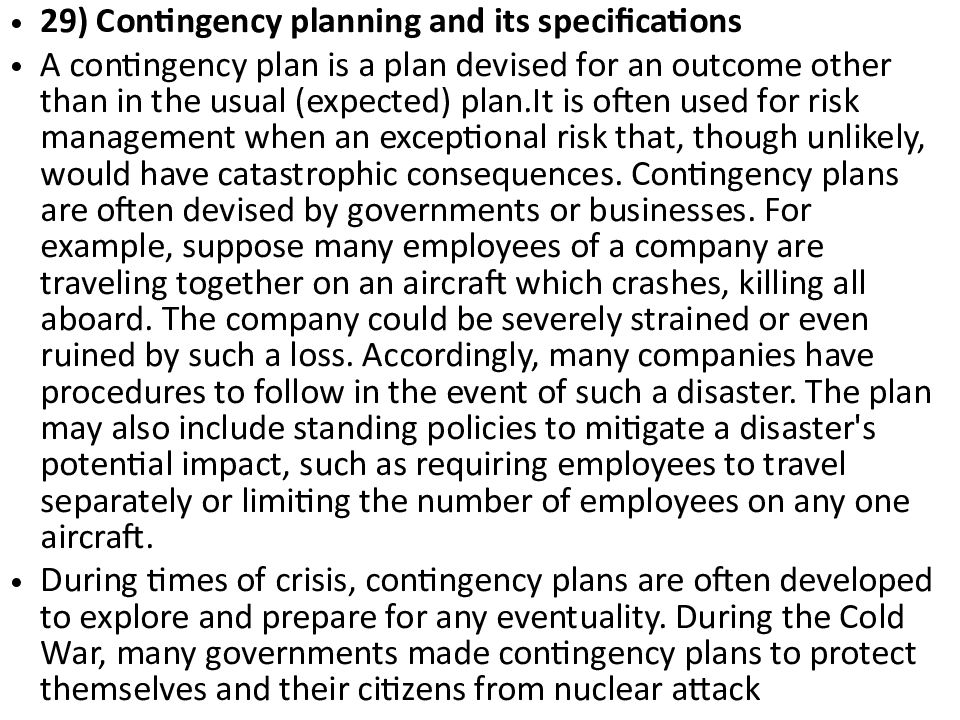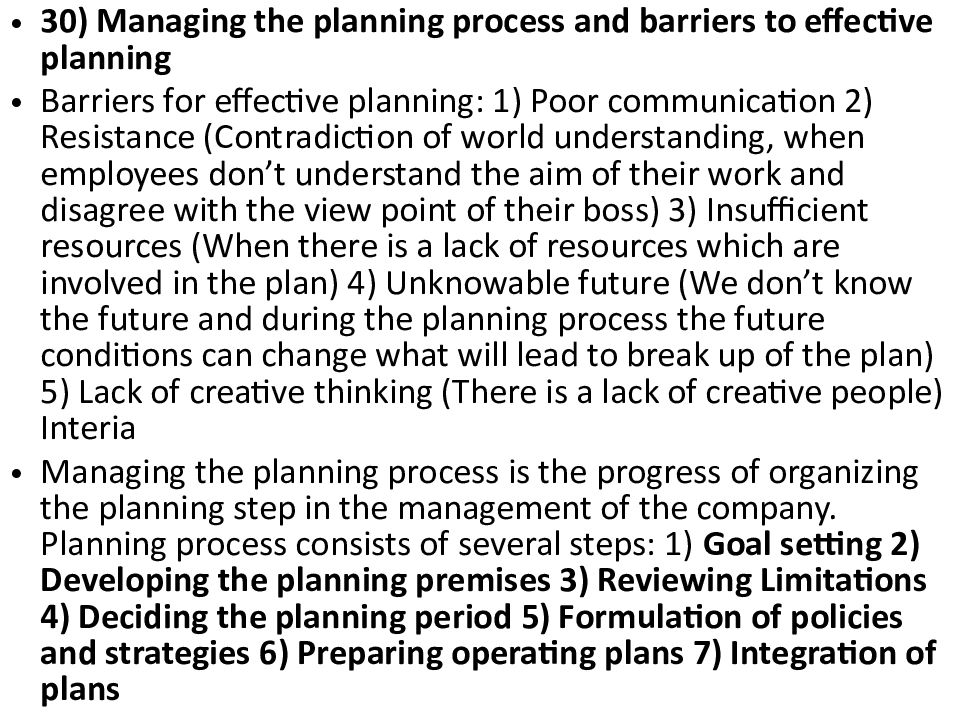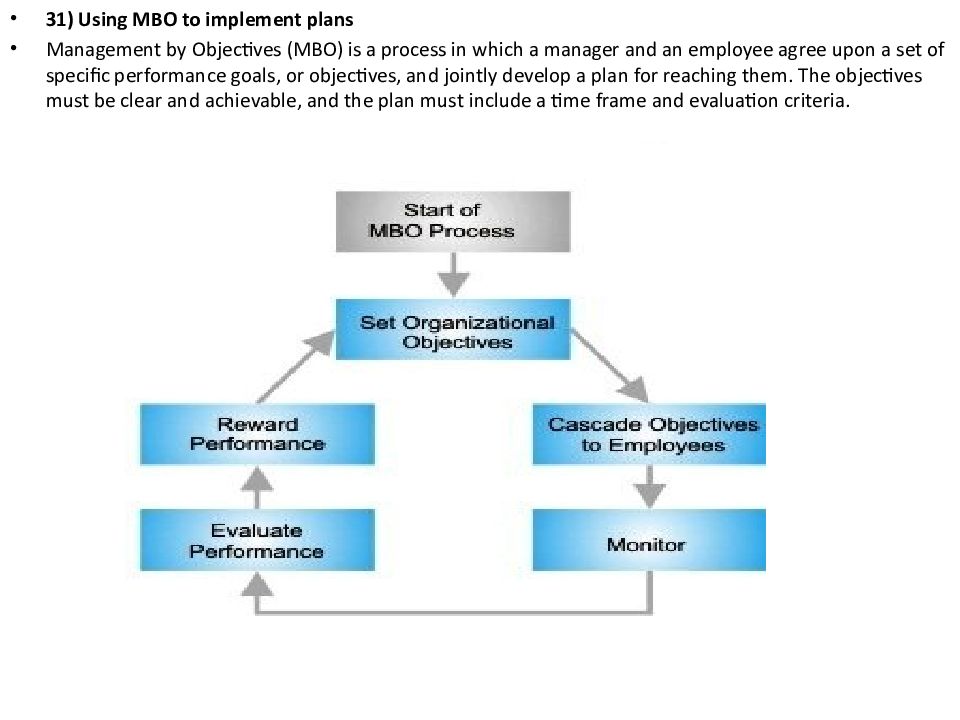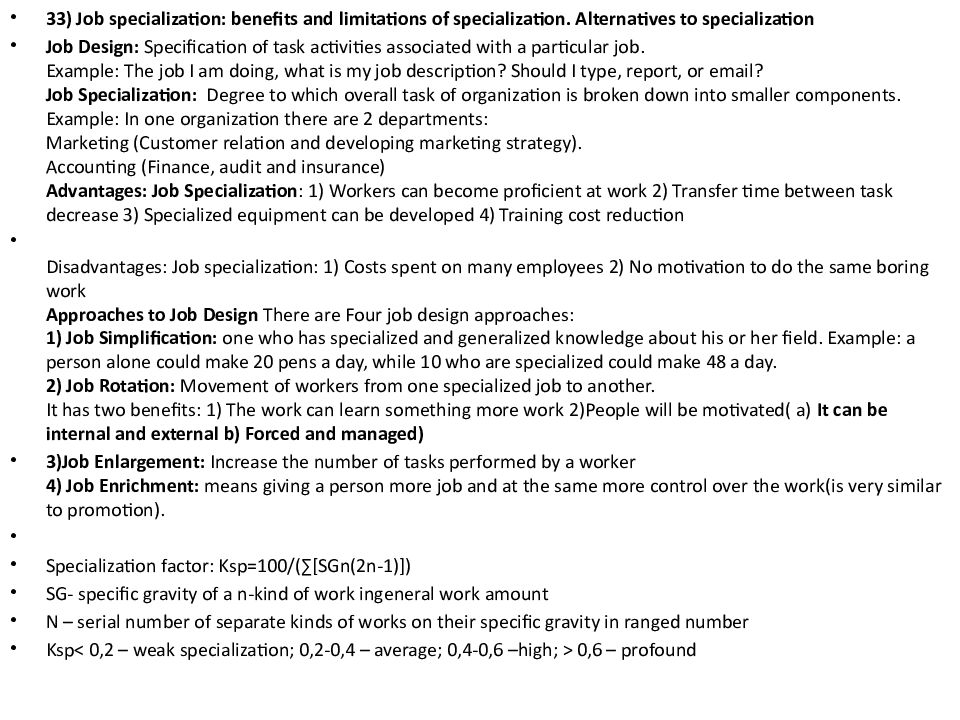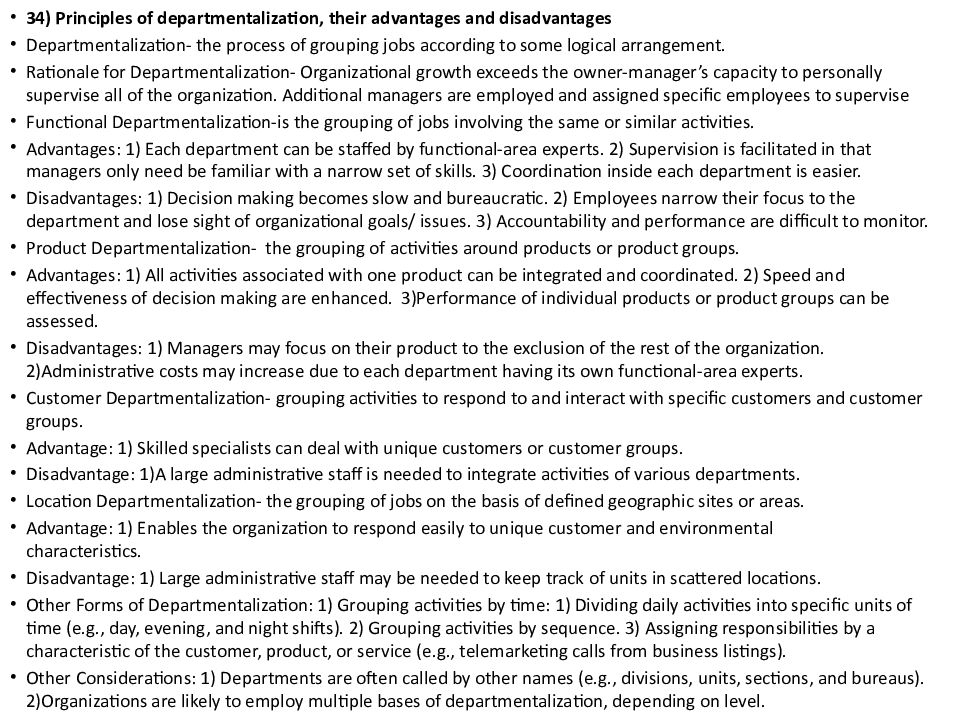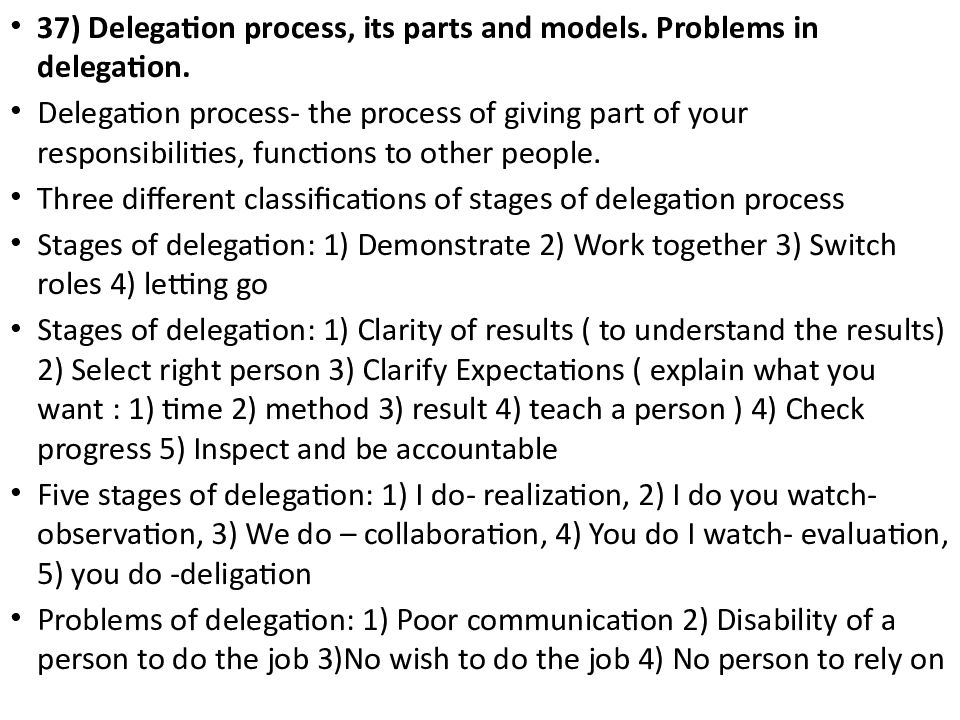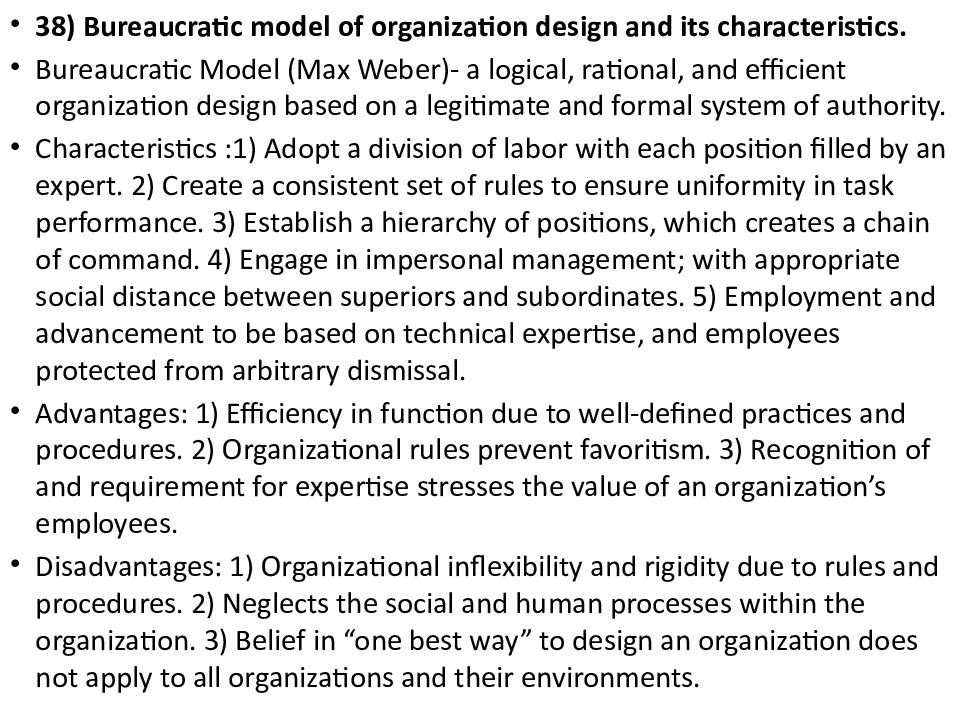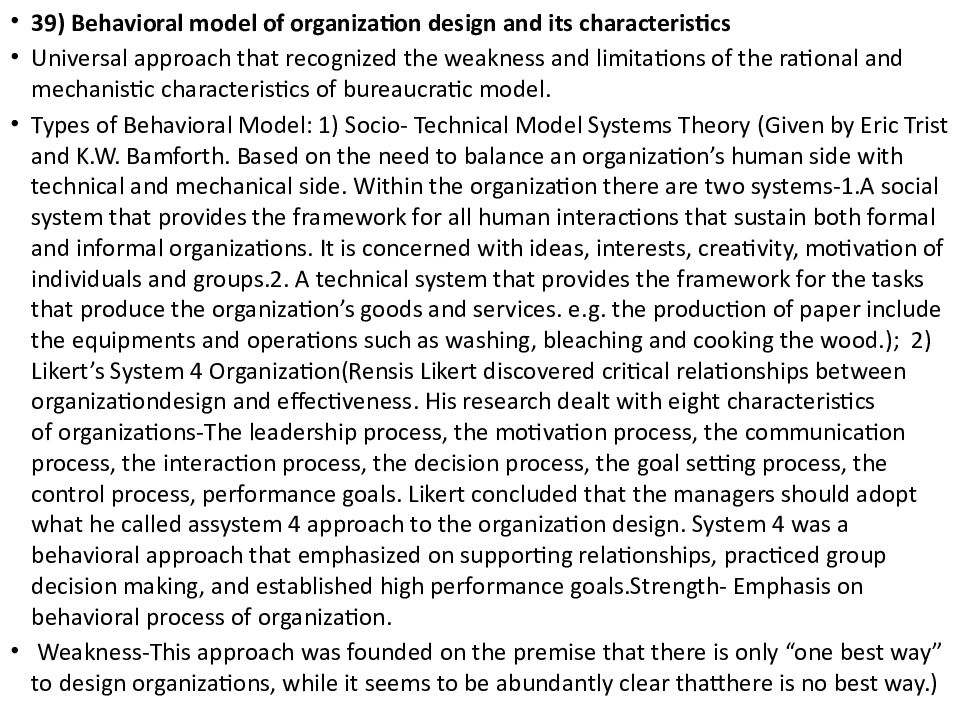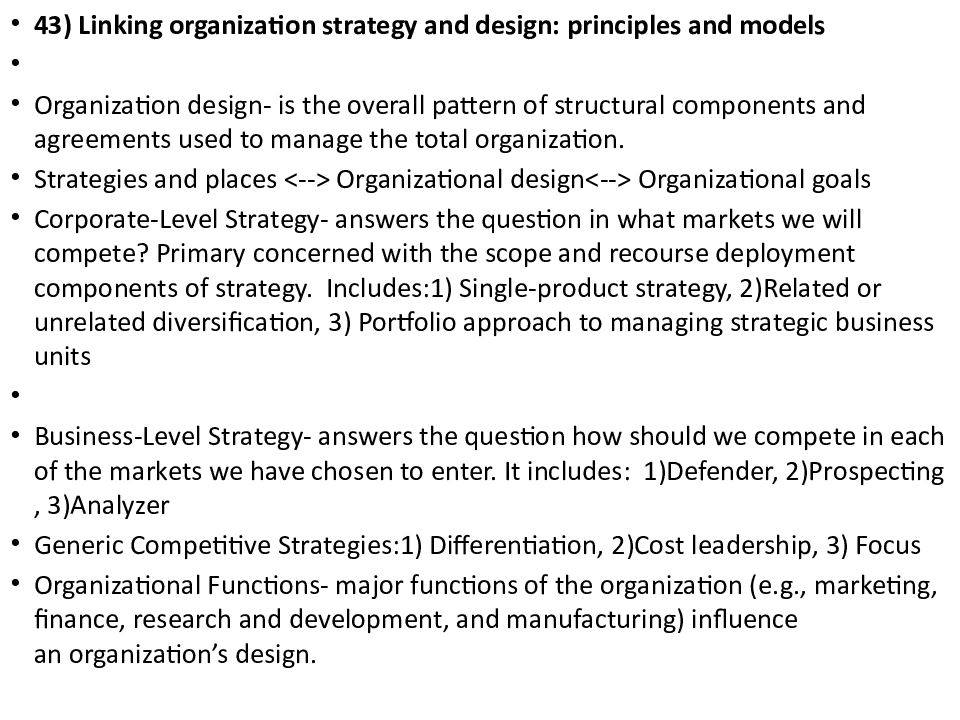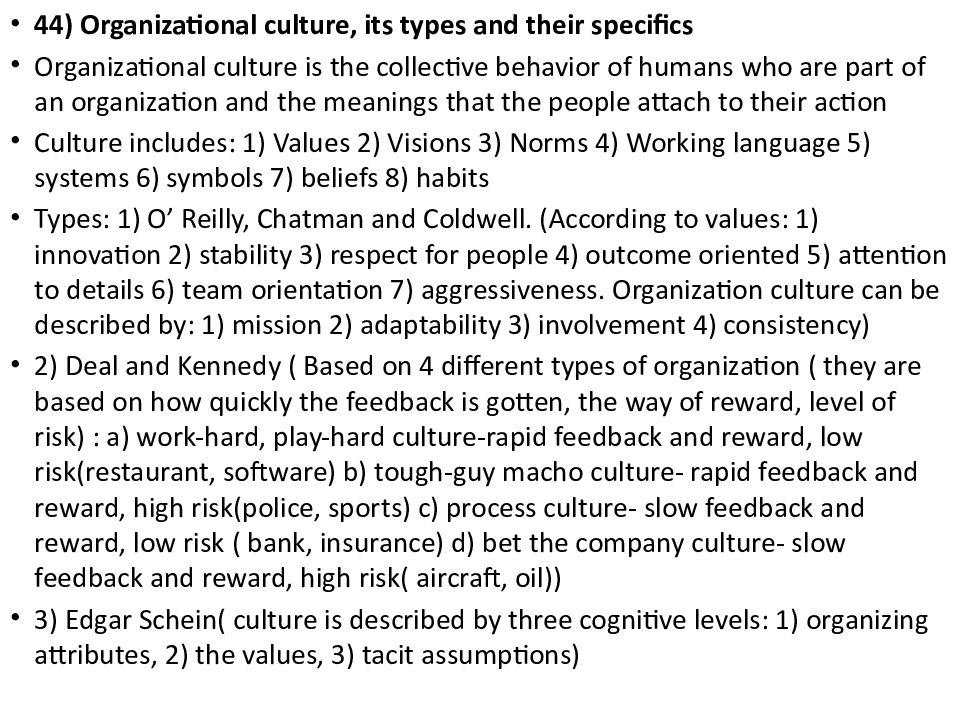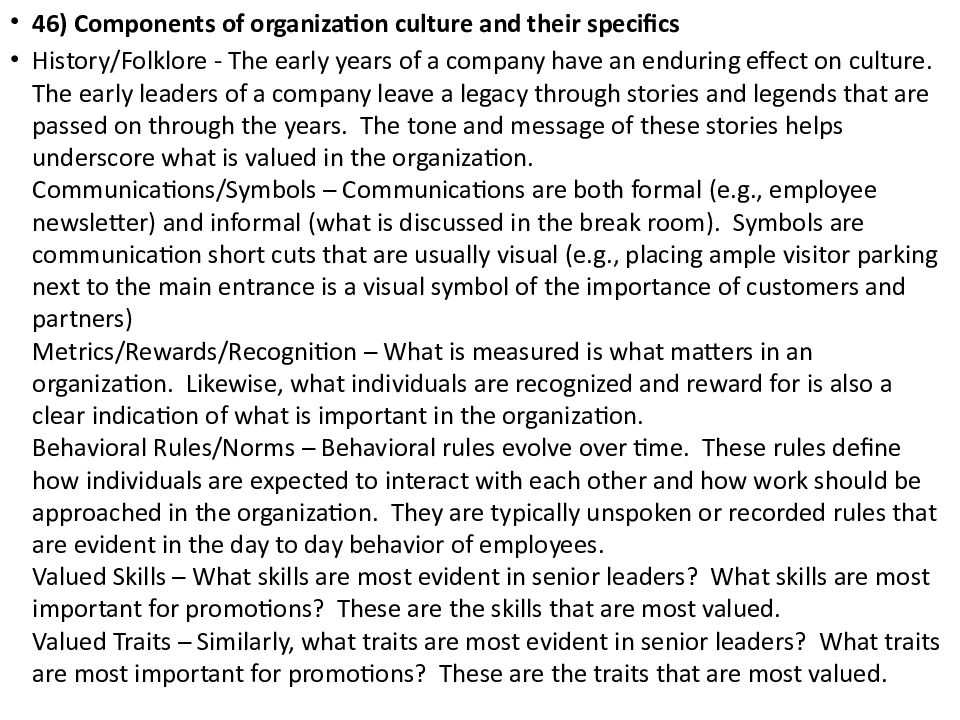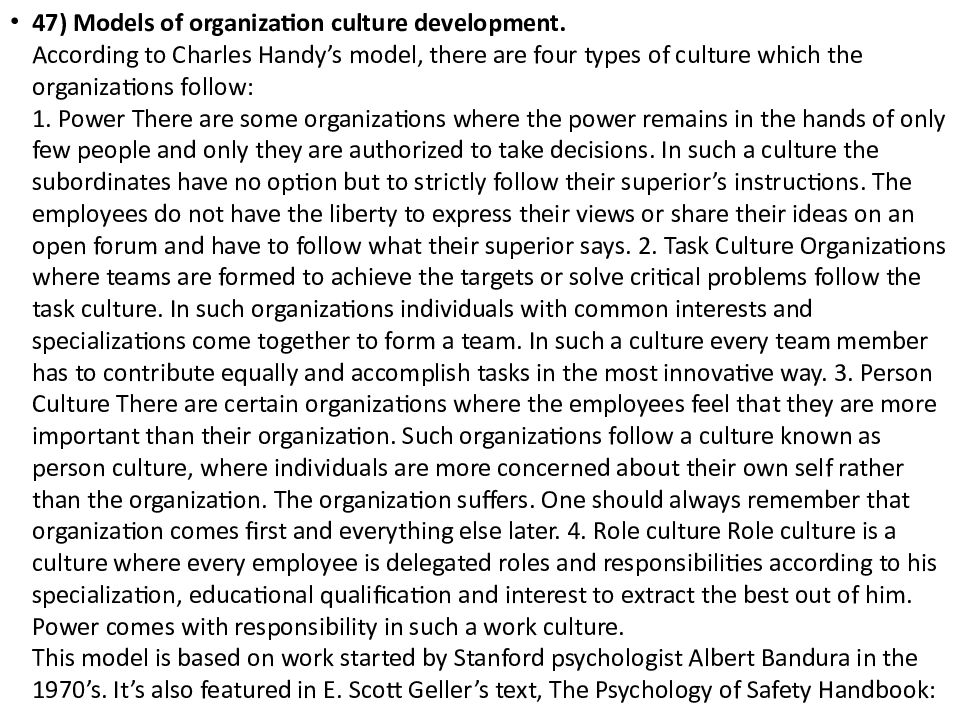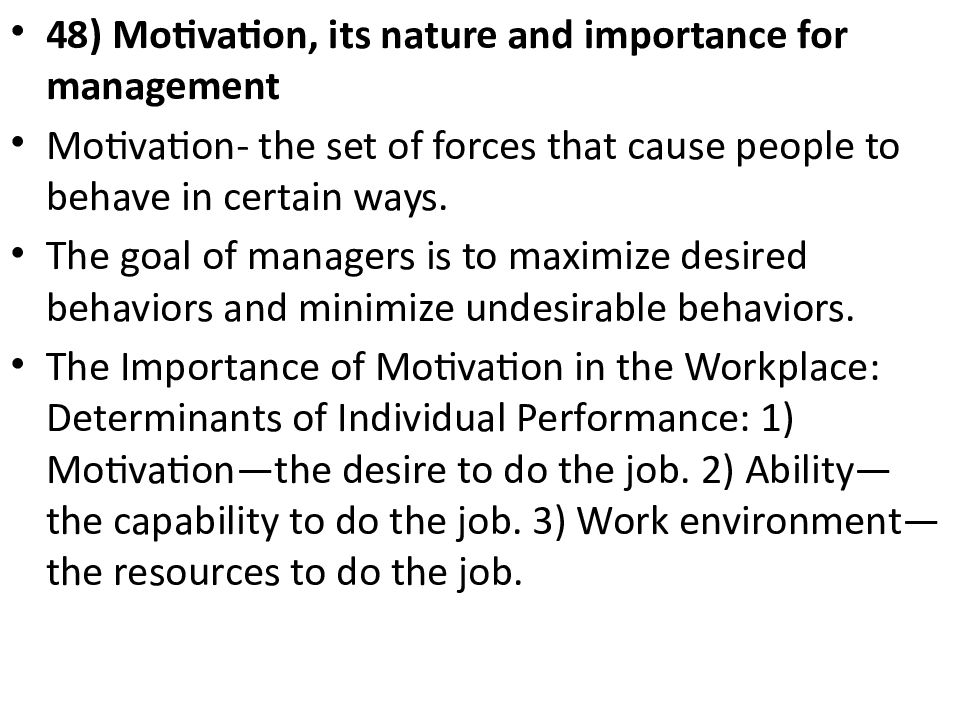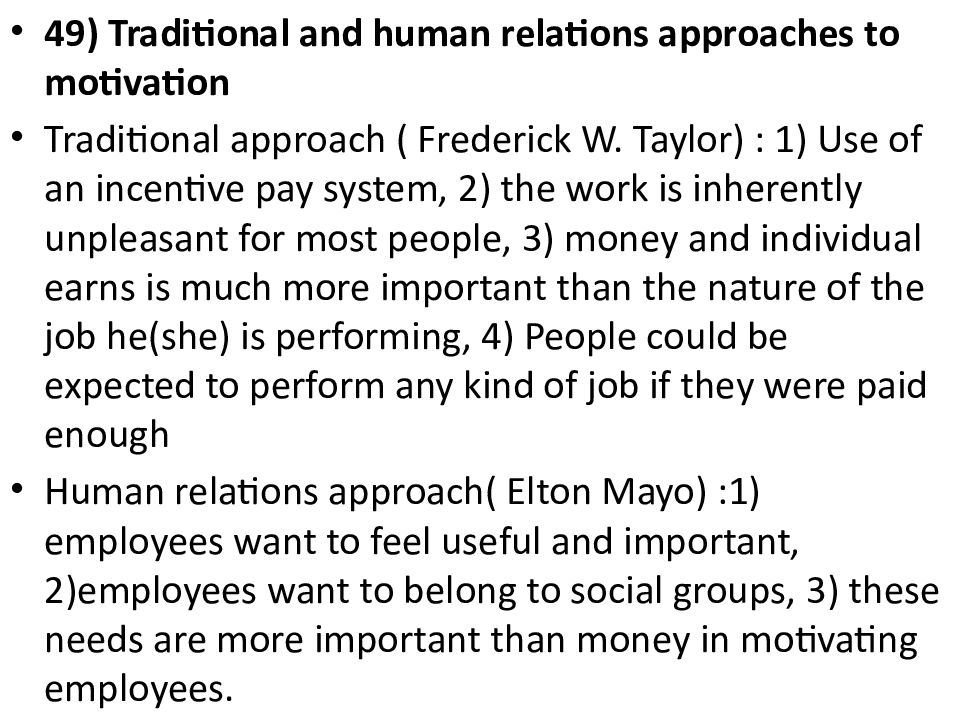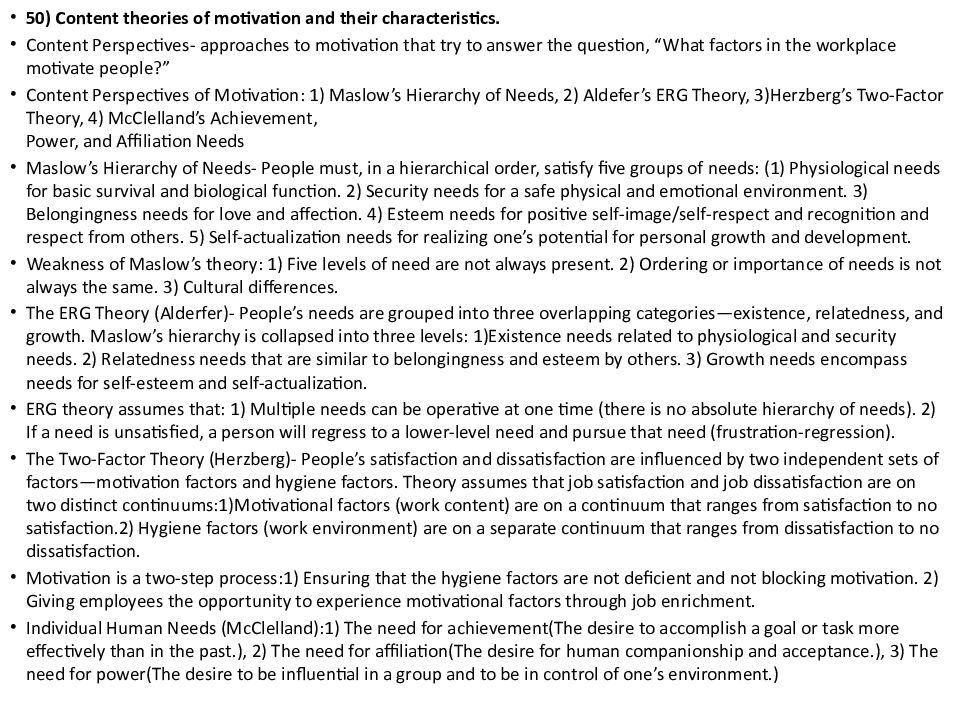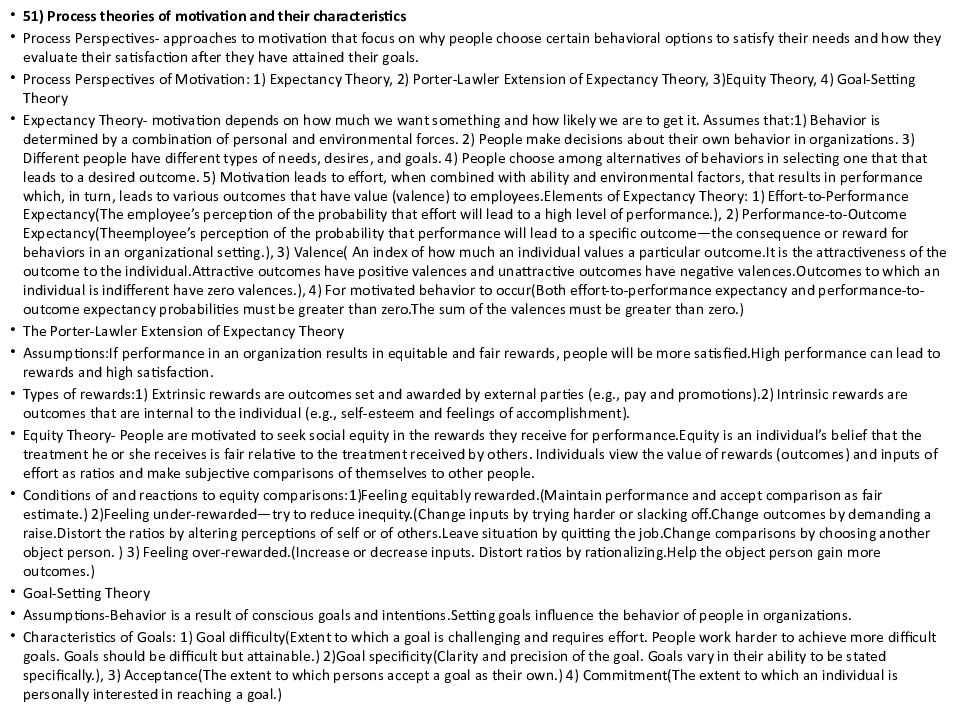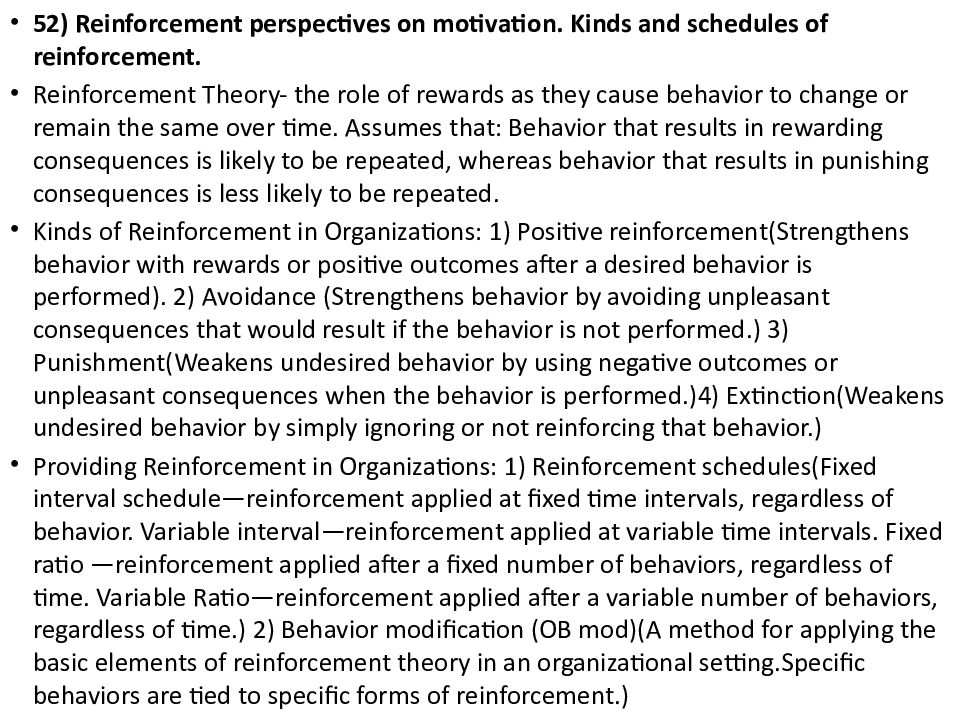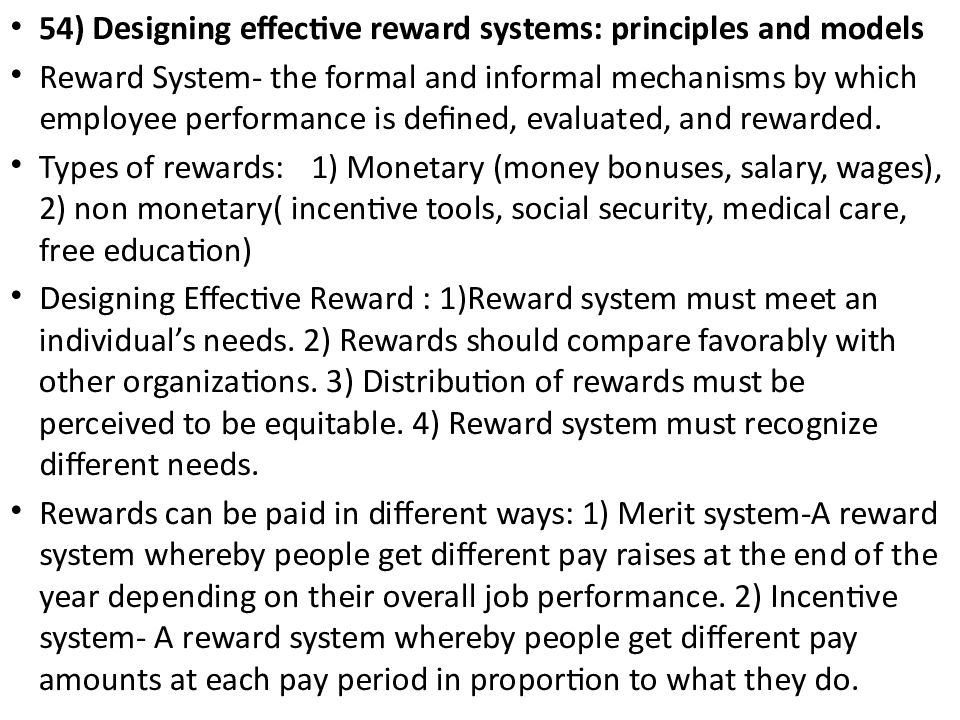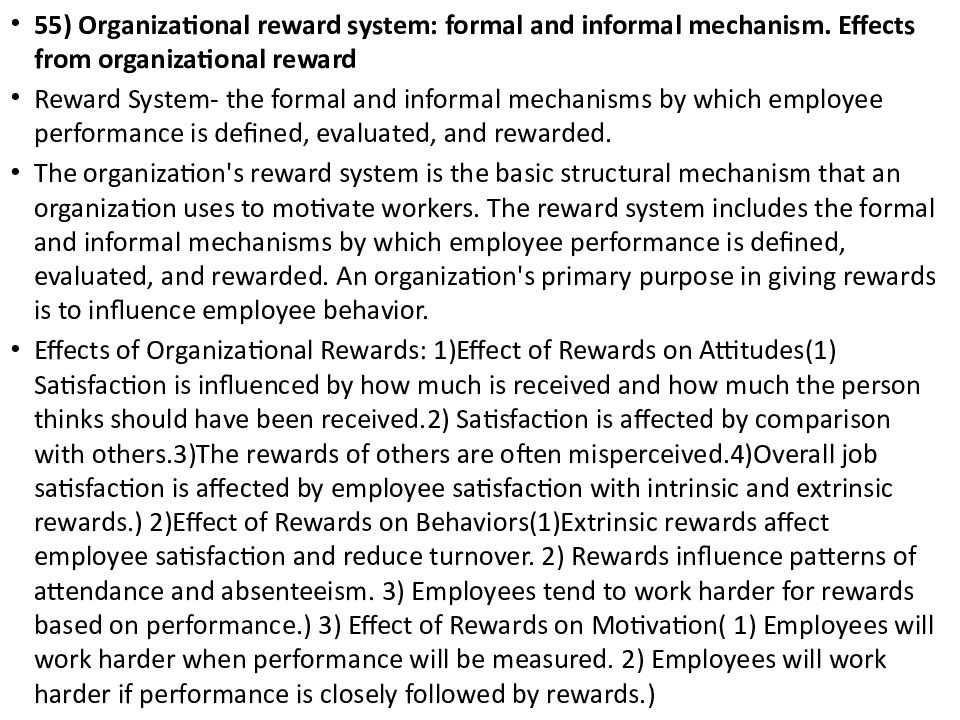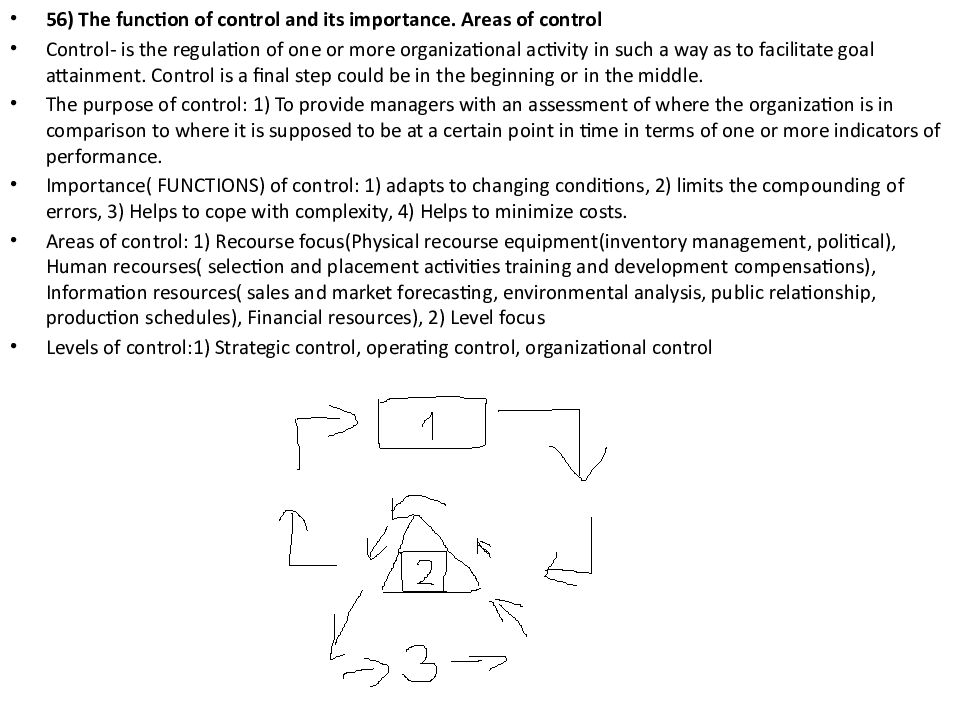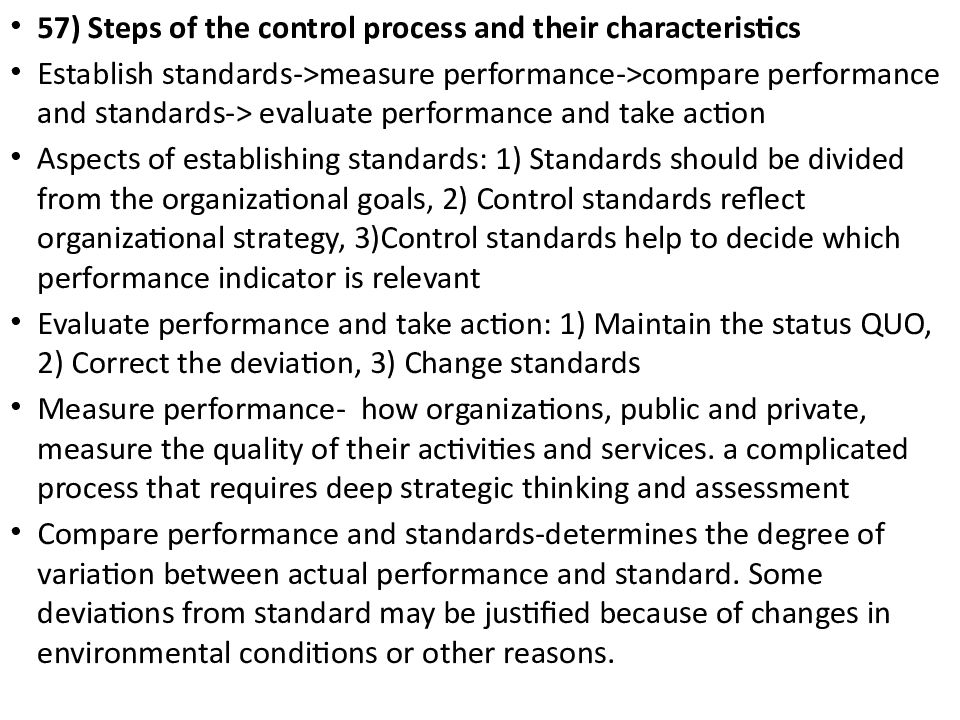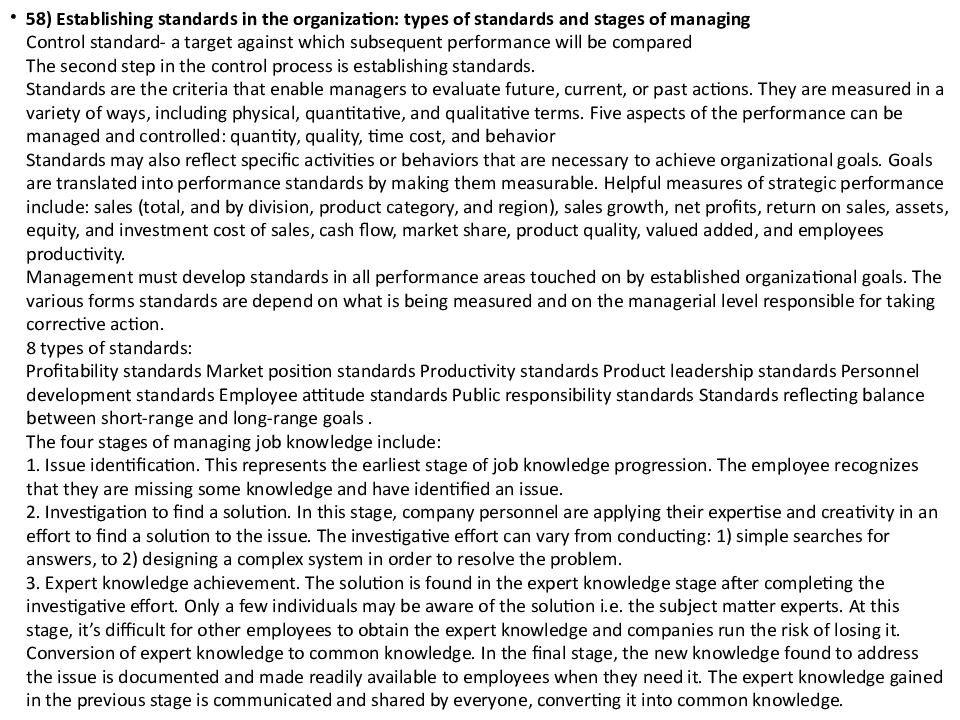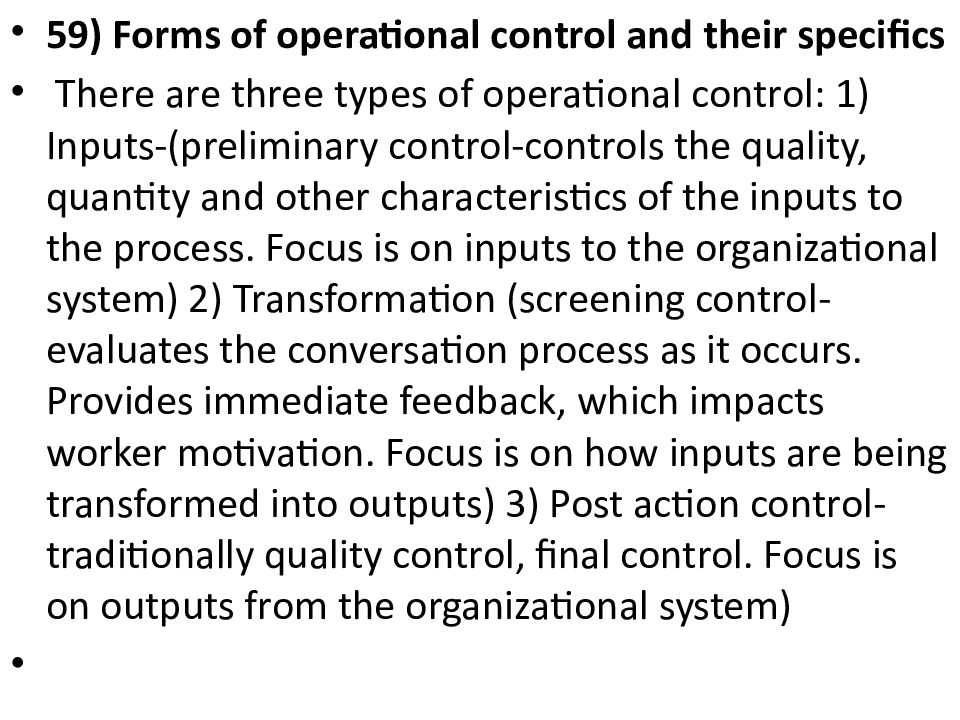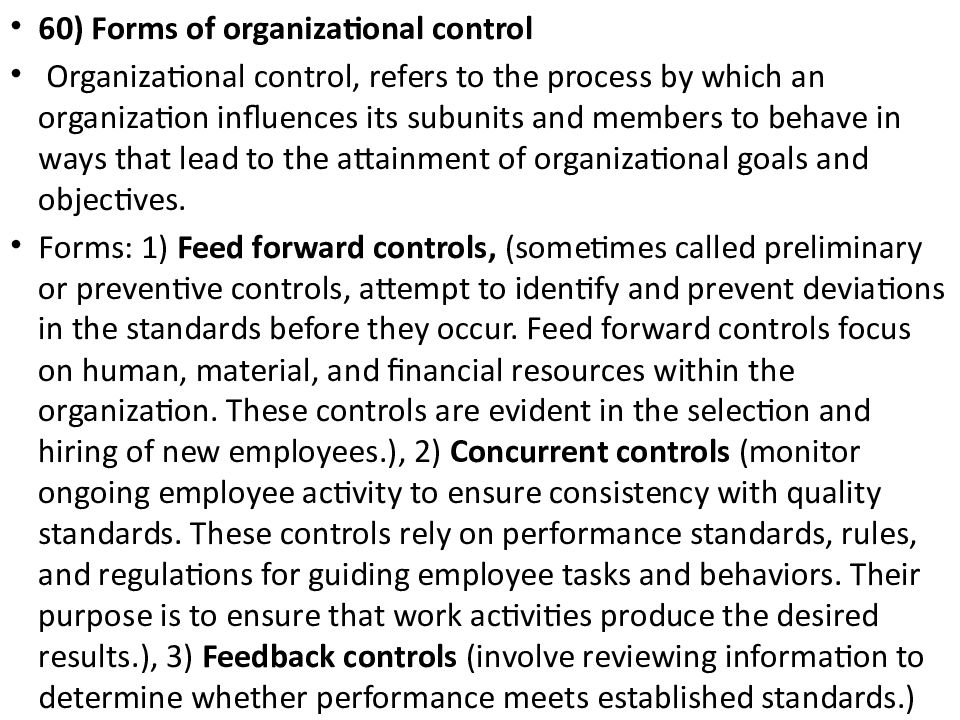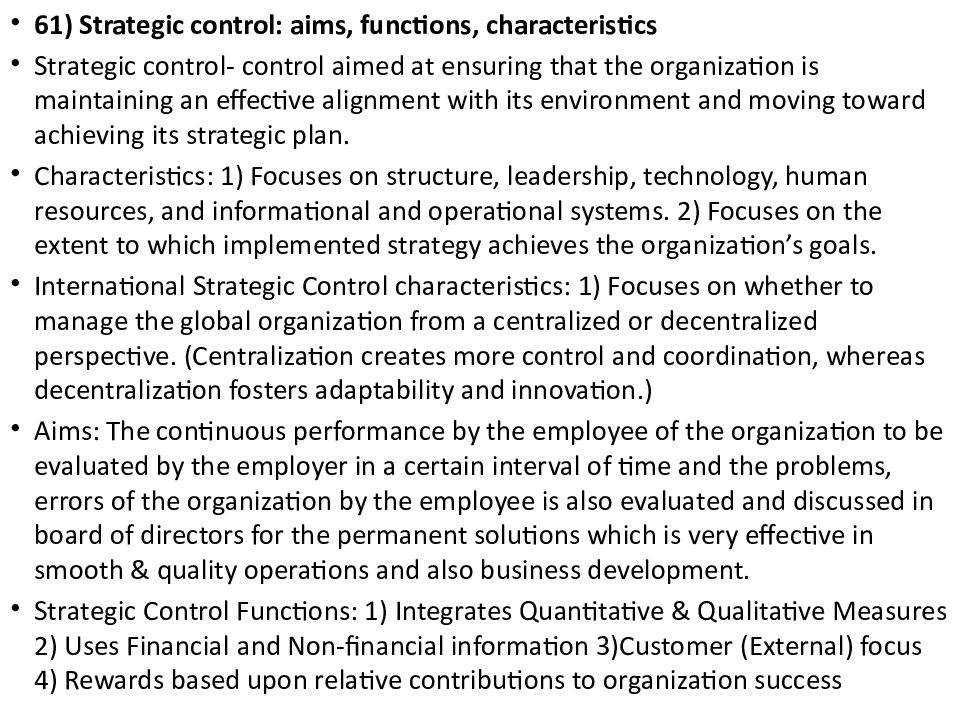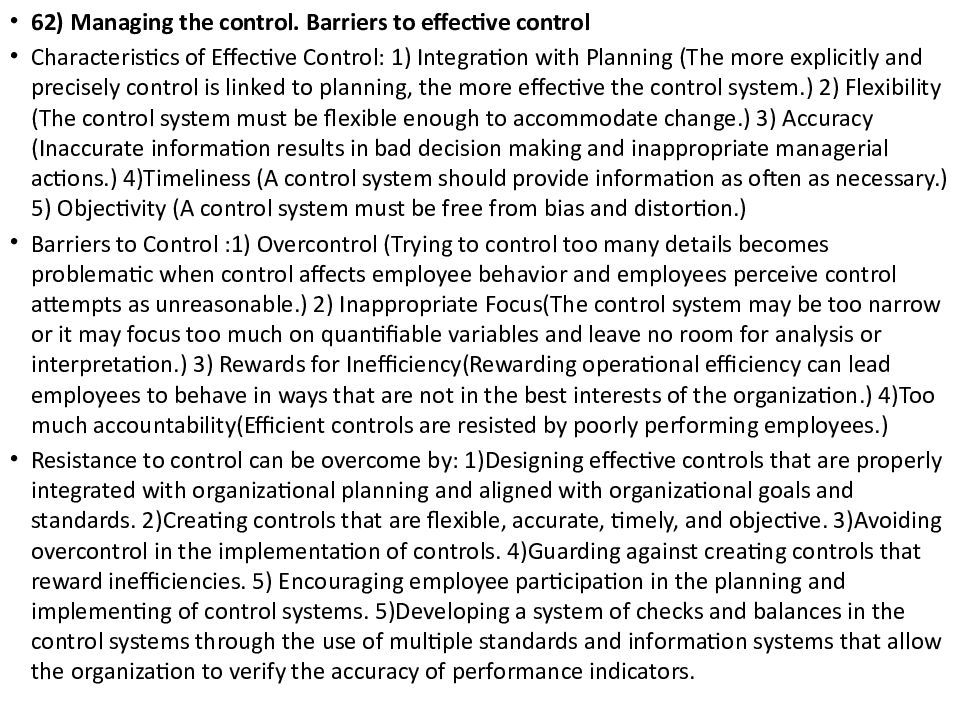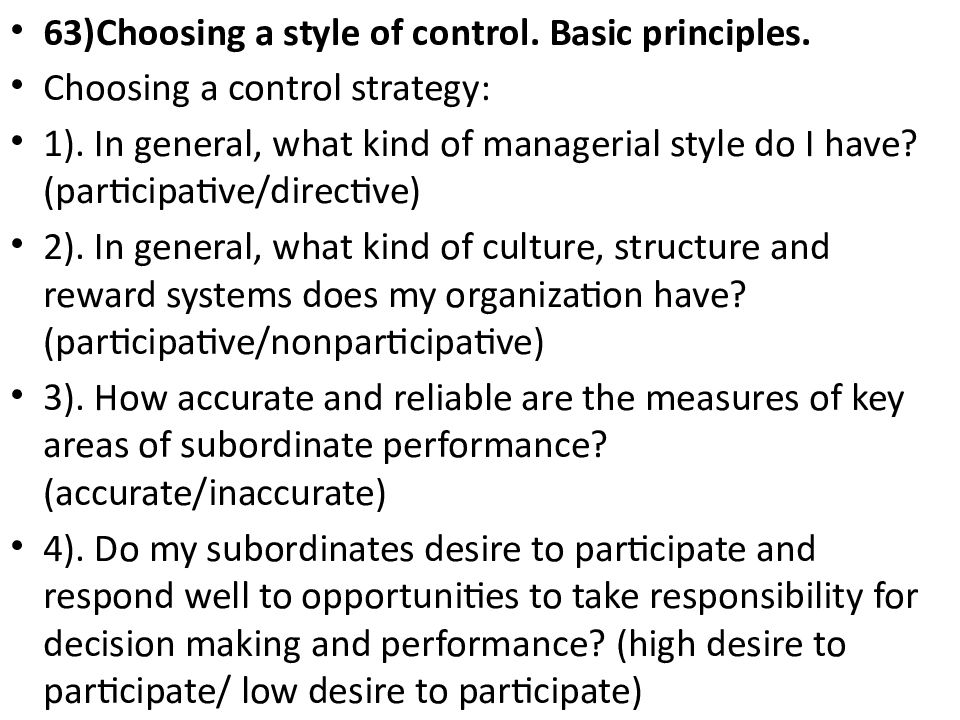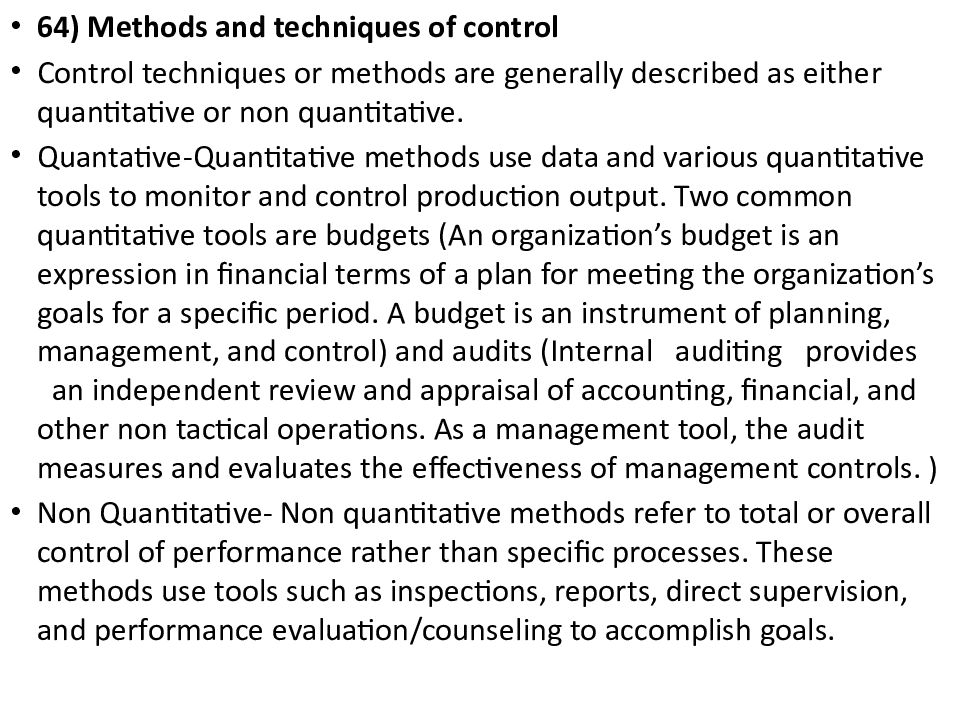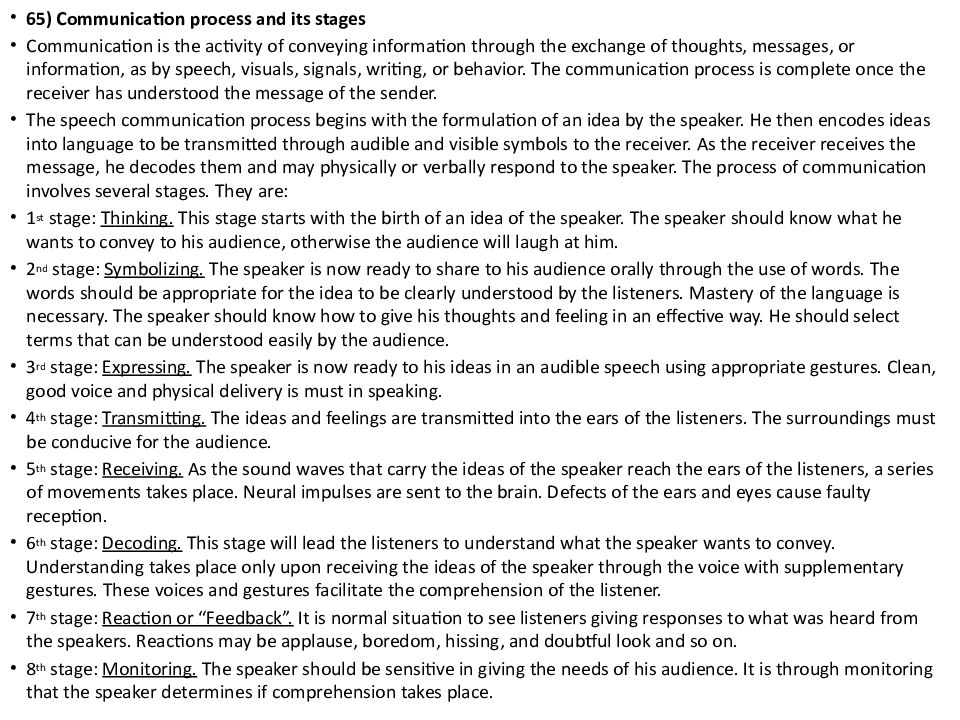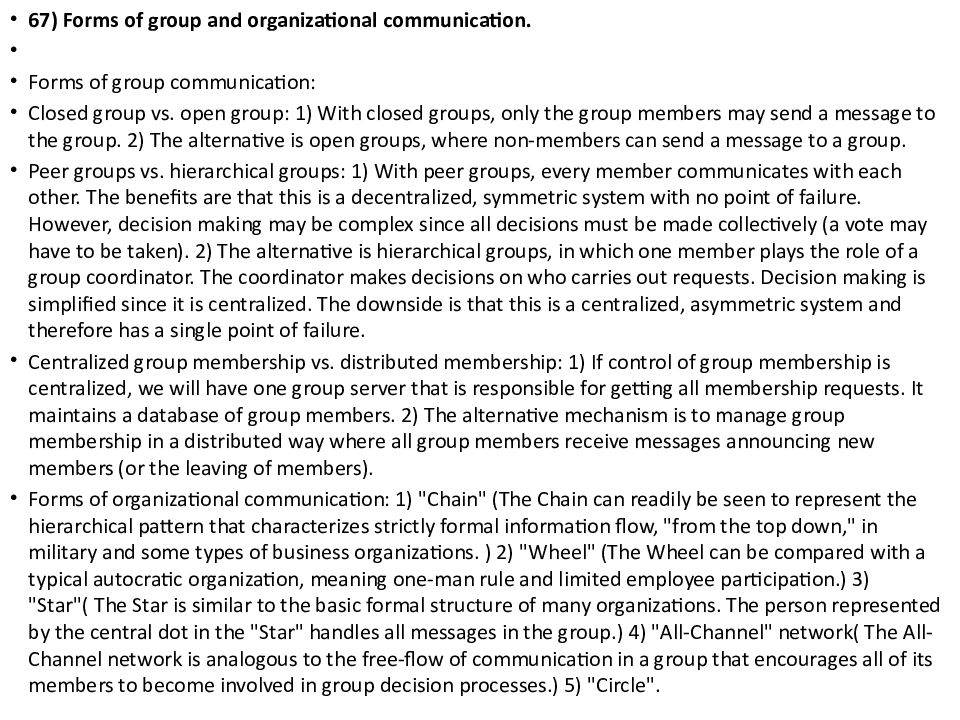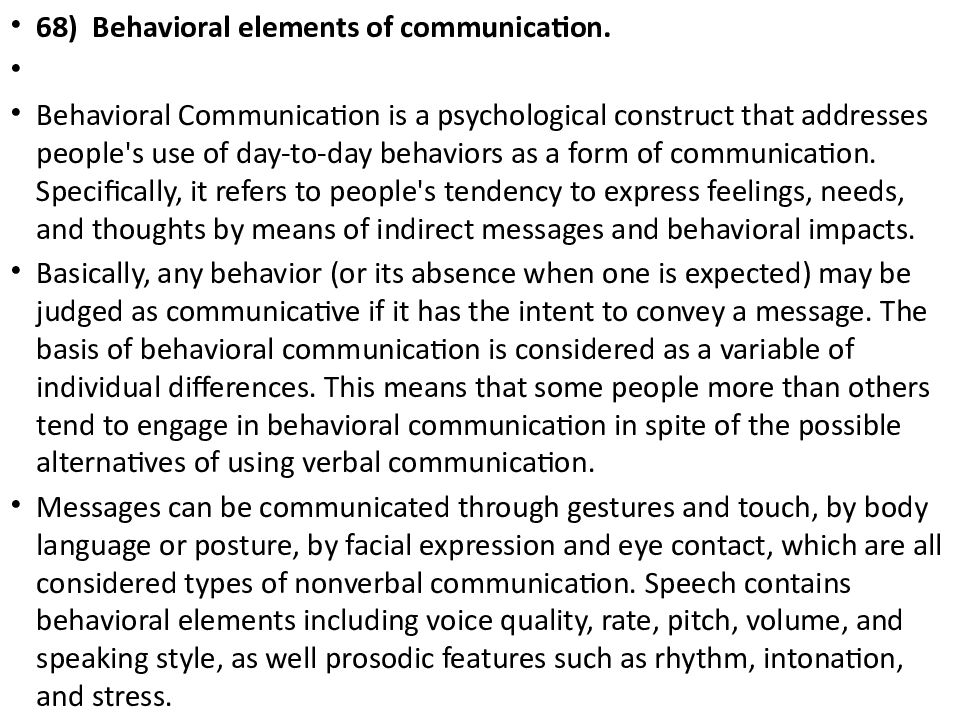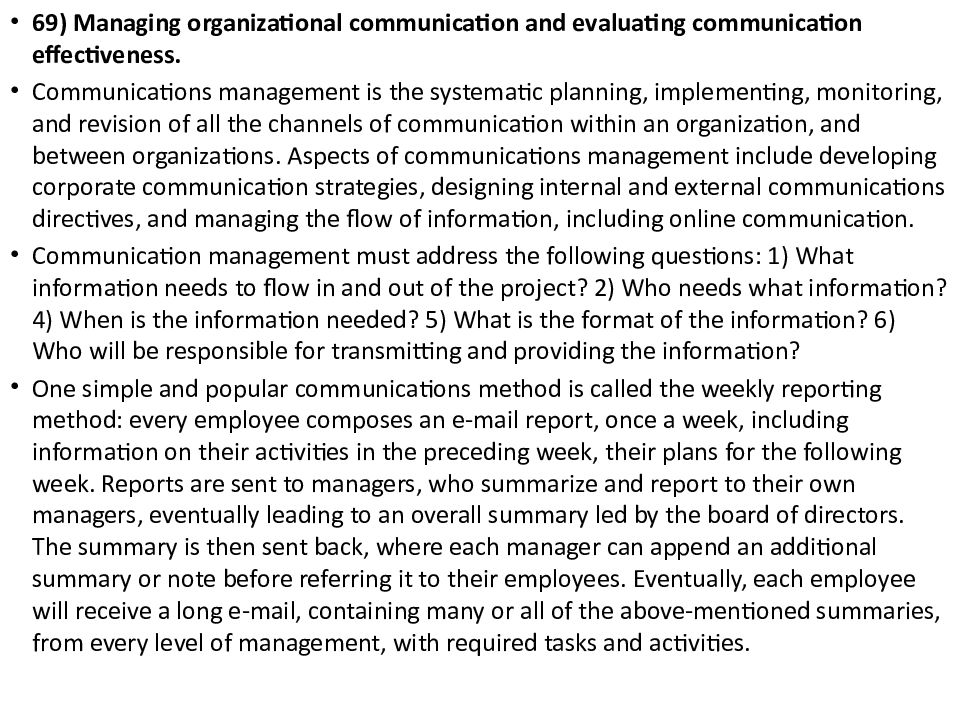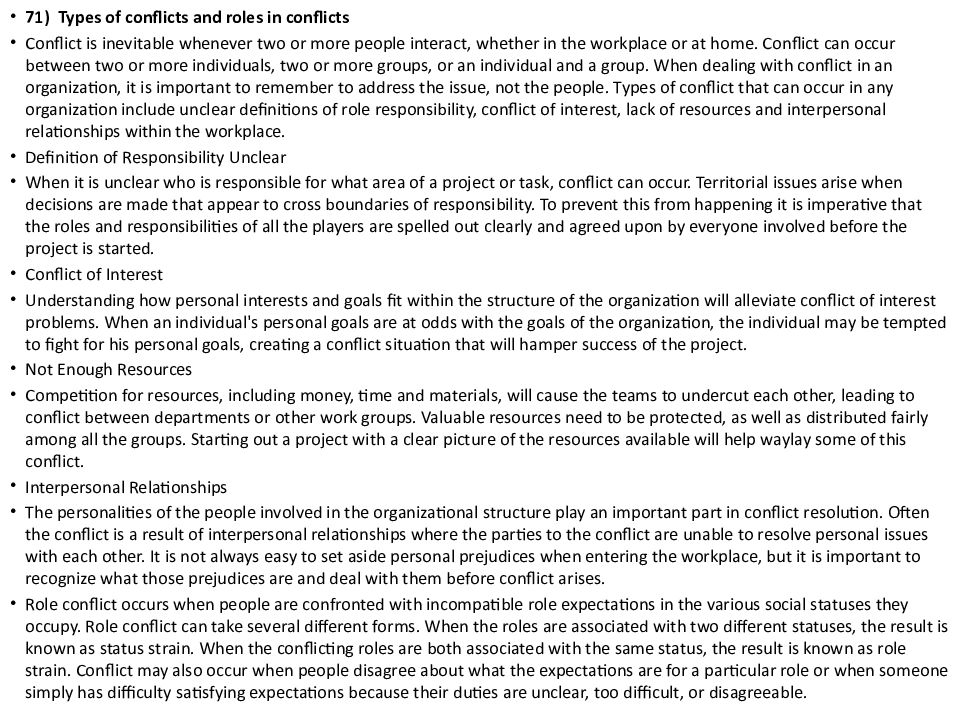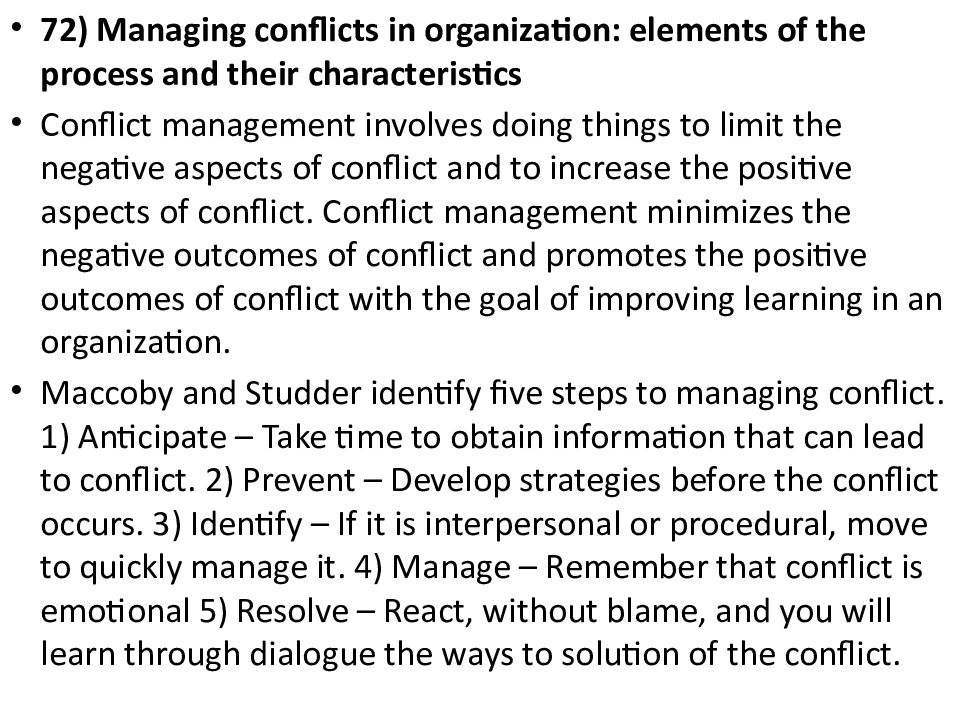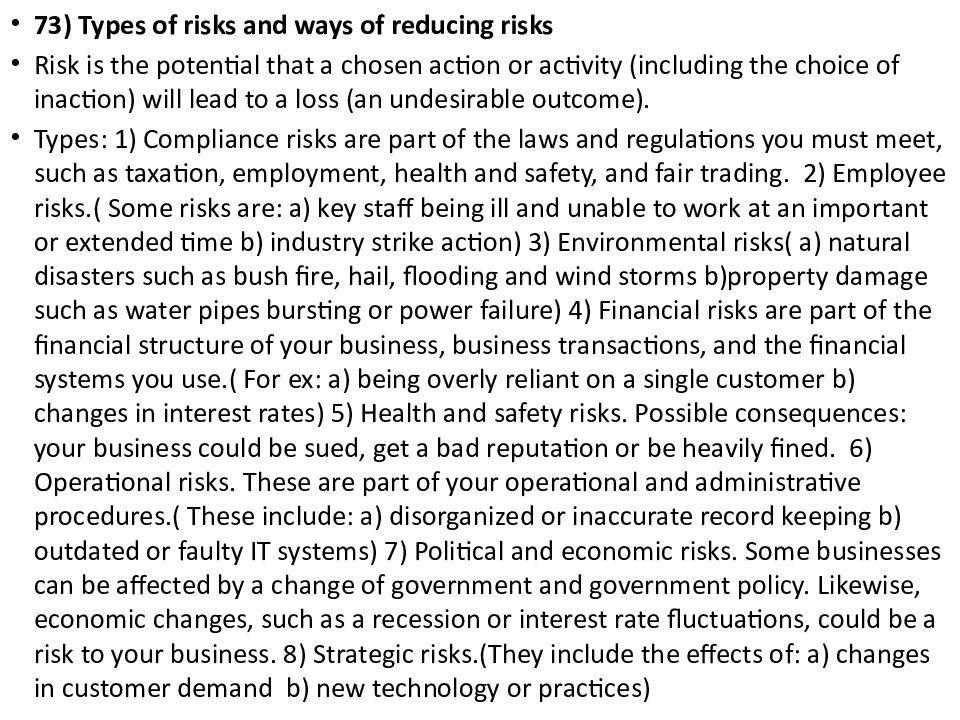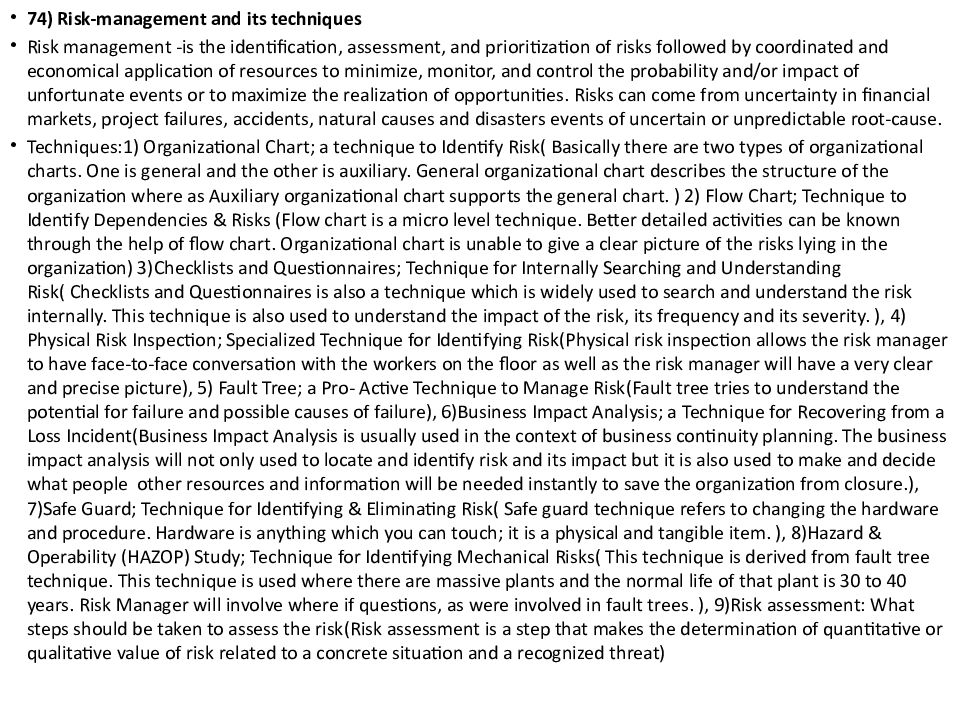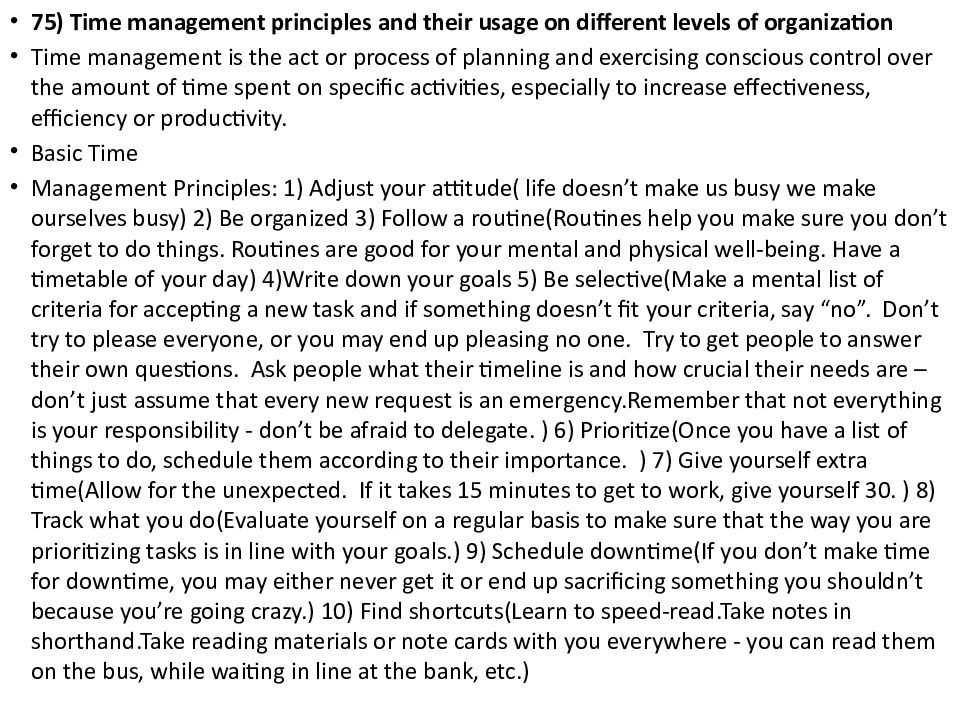Первый слайд презентации
1 ) Management process and its stages Management process- is the process of planning, organizing, directing, monitoring, controlling and decision making. Stages: analyzing the situation, setting the goal for employees, controlling the process, evaluating the performance, reward the performance
Слайд 2
2) Management: definition, levels, areas Management- organization and coordination of the activity of business in order to achieve defined objectives Levels: 1) Top management(delegation, leadership, change management) Top managers are group of executives, who control the organization. Their functions: 1) establish organization’s goals, overall strategy, operation policies. 2) Representing company to the external environment. 3) Making decisions about acquiring other companies, investing in research and development 2) Middle management( team building, problem solving, talent development) Middle managers- include plan managers operating managers, heads of divisions. Their functions: 1)implementing policies and plans developed by top, anagement. 2) Supervising and coordinating the activities of lower level managers 3) Low level(First line) managers(emotional intelligence, coaching for performance. First line managers supervise and coordinate the activities of operating employees. They are first positions held by employees who enter management from ranks of operating personnel. They are typically spend a large proportion of their time supervising the work of subordinates. Areas: Marketing, Finance, Operations, Personnel, Administration, human recourses, risk management, development
Слайд 3
3) Scientific management – main representatives and basic points. Its main objective is to improve economic efficiency, especially labour productivity.. It was one of the earliest attempts to apply science to the engineering of processes and to management. Main representatives: Frederick Winslow Taylor The peak of school in 1910-1920 Limitations- didn’t pay attention to the behavior of people Basic points: 1) apply science to the engineering of process to management 2) Division of labor 3) Worker’s should be scientifically selected and train for the work
Слайд 4
4) Classical organization theory – main representatives and basic scientific points. Organizational theory is "the study of organizations for the benefit of identifying common themes for the purpose of solving problems, maximizing efficiency and productivity, and meeting the needs of stakeholders." Organizational theory contains three subtopics: classical perspective, neoclassic perspective and environmental perspective.It complements the studies of organizational behavior and human resource studies. Max Weber (1947)- main representative Control of process- the core of management Classifications of organizations:1) Charismatic authority-type of organization, which has a charismatic leader 2) Traditional authority, type of organization based on traditions 3) Rational-legal authority= Bureaucracy of Max Weber, based on set rules Advantages: avoid corruption, unfairness Characteristics of bureaucracy: 1) Set of rules, 2)Specialization( division of labor), 3)Hierarchy, 4)Don’t pay attention on behavior of people, 5) Main directors are not selected but are chosen according to different tests, 6) Promotion, 7)Business is Business, 8) Strict control over employees Scientific points: 1) Structure 2) Specialization 3) Predictability and stability 4) Rationality 5) Democracy
Слайд 5
5) Contributions and limitations of Classical management perspective. Contributions:1) Basis of development of management theory, 2) Identified main process, functions and skills which are used today, 3)Management became to be identified as a science 4) Basically actualized equal division of labor between jobs and responsibilities of the managements and the workers. 5) All work processes should be systematically analyzed and broke down into specialized discrete tasks. 6) Payment depended on piecework basis which taken as an incentive to maximize productivity and produce high wages for the workers Limitations: 1) More suitable for simple-structure organizations, 2)Use universal ideas, 3)Views employees as tools 4) Reliance on experience, 5) Failure of consider the informal organization, 6) Unintended consequences, 7) Human machinery,8) Static conditions
Слайд 6
6) Contributions and limitations of Behavioral management perspective. Contributions: 1) Pay attention to motivation and team working and other interpersonal relations, 2) Employees are not tools, they are scarce resources, 3) Employees make their leaders more efficient, 4) Conditions for workers are very important 5) Draws on the findings of a number of disciplines such as management, psychology, sociology, anthropology, and economics 6) Articulates practical applications of behavioral studies. Limitations: 1) Complexity of characteristics of individuals makes it difficult to forecast the behavior; 2) Many concepts are not used because managers are lazy to do them
Слайд 7
7) The Quantitative management perspective, its contributions and limitations. Appeared during second WW Mathematicians, physicians, other scientists organized it. Use mathematic, statistical methods in organizing people. Limitations:1) didn’t pay attention to behavior of people, 2) Models may require unrealistic assumptions, 3) Concentrating on mathematics we can lose other management skills Contributions 1)Useful in controlling, planning process, 2) Application of models increased our understanding of the complex organization structure, process, 3) linear programming 4) use quantative techniques to improve decision-making
Слайд 8
8) System approach in management and its elements. System theory is transdisciplinary study of abstract organization of phenomena, independent of their substance, type or special or temporal scale of existence. System approach consists from: 1) Elements, 2) Attributes- качество, свойство элементов, 3) Relations between elements, 4) Environment( внутренняя, внешняя ). Elements: goal orientation, subsystem, synergy, system boundary, flow, feedback, open or closed, inputs, outputs, environment
Слайд 9
9) Contingency approach to management. Contingency approach is an approach which states that there is no universally applicable rules, set of management principles to manage the company Management process depends on Structure, Structure depends on 1)Technology of the company, 2) Companies environment we have 1)Non routine technology, новая технология которую никто не знает, 2) Uncertain environment не знаем что ожидать от среды, we take information from internal environment. Under this structure we have decentralized authority. IF there are 1) Routine Technology, 2) Certain environment, we take information from external environment. Under this structure we have centralized authority. Authority relates to social power. The contingency approach seeks to apply to real life situations ideas drawn from various schools of management thought. They claim that no one approach is universally applicable and different problems and situations require different approaches. Managers must try to find the approach that is the best for them in a certain given situation, so they can achieve their goals.
Слайд 10
10) Contemporary management perspectives. Contemporary applied perspective: 1) “Theory Z”( William Ouchi ) “In search of expellants ”(Peter and Waterman), 2) Popular authors ( Senge, Covey, Porter, Kotter, Hamel) Contemporary management challenges(problems):1) Shortage of labor in high technological sector, 2) Management of diversity force labor, 3) Rapid and constant economic change, 4) Globalization, 5) Importance of ethics and social responsibility, 6) Quality as the basis of competition Modern management approaches respect the classical, human resource, and quantitative approaches to management. Modern management approaches recognize that people are complex and variable. Employee needs change over time; people possess a range of talents and capabilities that can be developed. Organizations and managers, therefore, should respond to individuals with a wide variety of managerial strategies and job opportunities. Key themes to be considered, as the twenty-first century progresses, include the following:1) The commitment to meet customer needs 100 percent of the time guides organizations toward quality management and continuous improvement of operations. 2) Today's global economy is a dramatic influence on organizations, and opportunities abound to learn new ways of managing from practices in other countries. 3) Organizations must reinvest in their most important asset, their people.
Слайд 11
11) Organizational external and internal environment and its characteristics. External environment-everything outside the organizations boundaries what can effect it Internal environment- conditions and forces within an organization EE consists of: 1) competitors, 2) market place influences, 3) government regulation, 4) other macroeconomic uncontrollable forces IE depends on: 1)type of product, 2) size of an organization IE consists of : 1) flat structure (20 or less people), 2) department focused structure, 3) product focused structure, 4) formal structure, 5) organizational culture, 6) Organizational culture, 7) Recourses(people, information, machinery, supplies, finance), 8) managerial philosophy, 9) Company’s policy, 10) Mission
Слайд 12
12) Elements of general environment and their specifics. General environment(macro-environment)-all forces affecting the organization indirectly Elements:1) Economic ( Impact of economic factors, interstate, inflation, changes in disposable income, stage of current business cycle), 2) Political(legal)(Government), 3)Socio-cultural( changes in managers policy according to changes in society), 4)Demographic( characteristics of population: gender, age, level of education, income, geographical location), 5) Technological(changes the way organization is working)
Слайд 13
13) Task environment. Its elements and their specifics. The task environment includes sectors with which the organization interacts directly and that have a direct impact on the organization's ability to achieve its goals. Because the impact of general environment is often vague, imprecise and long term, most organizations tend to focus their attention on their task environment. These environments include competitors, customers, suppliers, strategic partners and regulation. Although the task environment is also comlex, it provides useful information more readily than does the general environment because the manager can identify environment factors of specific interest to the organization, rather than having to deal with the more abstract dimensions of general environment.
Слайд 14
14)Organization-environment relations. Because organizations are open systems, they interact with various dimensions in different ways. This question describes the various dimensions of organizational environment. We shall discuss how environments affect organizations, then Note number of ways in which organizations adapt to their environments. * how environments affect organizations Three basic perspectives can be used to describe how environments affect organizations: 1)environmental change and complexity- James D. Thompson was one of the first people to recognize the importance of the organizational environment. He said that uncertainty is a driving force that influence many organizational decisions. 2)competitive forces -Factors that influence the competitive position of a company in an industry or market. Competitive forces include (1) bargaining power of the buyers and suppliers, (2) threat of new entrants, and (3) rivalry among existing companies. 3)environmental turbulence- Environmental turbulence refers to the amount of change and complexity in the environment of a company. The greater the amount of change in environmental factors, such as technology and governmental regulations, and/or the greater the number of environmental factors that must be considered, the higher the level of environmental turbulence *How organizations adopt to their environments. Each organization must assess its own unique situation and then adapt according to the wisdom of its senior management. There are 6 basic mechanisms through which organizations adapt to their environments
Слайд 15
14 продолжение Information Management- important when forming an initial understanding of the environments and when monitoring the environments for signs of change. One technique for managing information is relying on boundary spanners( an employee, such as a sales representative or purchasing agent, who spends much of his time in contract with others outside organization), such people are in good position to learn what other organizations are doing. All effective managers engage in environment scanning ( the process of actively monitoring the environments through activities such as observation and reading. Within the organization, many firms have also established computer-based information systems-to gather and organize relevant information for managers and to assist in summarizing that information in the form most pertinent to each manager’s needs. Enterprise resource planning techniques are also useful methods for improving Information management. Strategic Response- include maintaining the status quo, altering strategy a bit( adopting an entirely new strategy) Mergers, Acquisitions and Alliances-related strategic approach that some organizations use. Merger- occurs when 2 or more firms combine to form a new firm. Acquisitions- occurs when one firm buys another, sometimes against its will(usually called a “hostile takeover”). Alliance or partnership- the firm undertakes a new venture with another firm. Organization design and flexibility. 2 formers types of organizational design: Mechanistic organization design-characterized by formal and rigid rules and relationships., Organic design-more flexible and permits the organization to respond quickly environmental change. Direct influence- Firms can influence their suppliers signing long-term contracts with fixed prices as hedge against inflation. Or Social responsibility- The principle that companies should contribute to the welfare of society and not be solely devoted to maximizing profits.
Слайд 16
15)Organization effectiveness and its models Effectiveness of the organization is related ultimately to how well an organization understands, reacts, and influences its environment. There is no consensus how to measure effectiveness. Models: 1) Systems resource approach focuses on the extent to which the organization can acquire the resources it needs. 2) Internal process approach deals with the internal mechanisms of the organizations and focuses on minimizing strain, integrating individuals and the organization, and conducting smooth and efficient operations. 3) The goal approach focuses on the degree to which an organization reaches to its goals. 4) Strategic constituencies approach focuses on the groups that hae a stake in the organization These 4 models focus on different aspects: 1 model focuses on inputs, 2 model on transformation process, 3 model on outputs, 4 model on feedback.
Слайд 17
16)Managerial decision-making. Types of decisions Decision making- the process by which managers respond to opportunities and threats by analyzing options and making decisions about goals and courses of action. Decisions in response to opportunities- managers respond to ways to improve organizational performance. Decisions in response to threats-occurs when managers are impacted by adverse events to the organization. Decision Making-the act of choosing one alternative from among a set of alternatives. Types of Decisions: 1) Programmed decision-a decision that is fairly structured decision or recurs with some frequency or both. automatic process( managers have made decision many times before, there are guidelines to follow). 2) Non-programmed decision-a decision that is relatively unstructured and occurs much less often a programmed decision. unusual situations that have not been often addressed (no rules to follow since the decision is new, these decisions are based on information, manager’s intuition and judgment) Decision-making conditions: 1)Decision Making under Certainty- a condition in which the decision knows with reasonable certainty what the alternatives are and what conditions are associated with each alternative. 2)Decision-making under Risk-a condition in which the availability of each alternative and its potential payoffs and costs are all associated with risks. 3)Decision-making under Uncertainty- a condition in which the decision maker doesn’t know all the alternatives, the risks associated with each, or the consequences of each alternative
Слайд 18
17) Models of decision making process and their characteristics. Decision-making process- the process of recognizing and defining the nature of a decision situation, identifying alternatives, choosing the best alternative, and putting it into practice. Decision-making process- an effective decision is one that optimizes some set of factors such as profits, sales, employee welfare and market share. Decision-making process- managers make decisions about both problems and opportunities. Models:1) Classical- a perspective model that tells how the decision should be made. Assumes managers have access to all the information needed to reach a decision. Managers can make the optimum decision by easily ranking their own preferences among alternatives. Unfortunately managers often don’t have all required information. 2) Administrative model- challenges the classical assumptions that managers have and process all information. As a result, decision making as risky. Boundary rationality-there is a large number of alternative and information is vast so that managers can’t consider it all. Decisions are limited by people’s cognitive abilities. Incomplete information-most managers don’t see all alternatives and decide based on incomplete information. Information is incomplete because of : uncertainty and risk; ambiguous( двусмысленная ) information; time constrains and information costs
Слайд 19
18) Steps in rational decision-making 1) Recognizing and defining the decision situation- some stimulus indicates that a decision must be made. The stimulus may be positive or negative 2) Identifying alternatives- both obvious and creative alternative are desired. In general, the more important the decision, the more alternatives should be considered. 3) Evaluating alternatives- each alternative is evaluated to determine its feasibility, its satisfactoriness, and its consequences. 4) Selecting the best alternative- consider all situational factors, and choose the alternative that best fits the manager’s situation 5) Implementing the chosen alternative- the chosen alternative is implemented into the organizational system 6) Following up and evaluating the results – at some time in the future, the manager should ascertain the extent to which the alternative chosen in step 4 and implemented un step 5 has worked
Слайд 20
19) Behavioral nature of decision making Behavioral Aspects of Decision Making The Administrative Model of Decision Making Bounded Rationality-The concept that decision makers are limited by their values and unconscious reflexes, skills, and habits. Satisficing- The tendency to search for alternatives only until one is found that meets some minimum standard of sufficiency to resolve the problem. Coalition-A political force in decision making which consists of an informal alliance of individuals or groups formed to achieve a goal. Intuition- An innate belief about something without conscious consideration. Escalation of Commitment- A decision maker is staying with a decision even when it appears to be wrong. Risk Propensity-The extent to which a decision maker is willing to gamble when making a decision. Ethics and Decision Making-Individual ethics (personal beliefs about right and wrong behavior) combine with the organization’s ethics to create managerial ethics. Components of managerial ethics: 1) Relationships of the firm to employees 2) Employees to the firm 3)The firm to other economic agents
Слайд 21
20) Forms of group decision making, their advantages and disadvantages Group and Team Decision Making Organizations Forms of Group Decision Making :1) Interacting groups or teams (are the most common form of decision-making groups which consists of an existing group or newly formed team interacting and then making a decision.) 2) Delphi groups ( are sometimes used for developing a consensus of expert opinion from a panel of experts who individually contribute through a moderator.) 3) Nominal groups ( are a structured technique designed to generate creative and innovative ideas through the individual contributions of alternatives that are winnowed down through a series of rank-ordering of the alternatives to reach a decision.) Managers Can Promote the Effectiveness of Group and Team Decision Making:1) Being aware of the pros and cons of having a group or team make a decision. 2) Setting deadlines for when decisions must be made. 3) Avoid problems with dominance by managing group membership. 4) Have each group member individually critically evaluate all alternatives. 4) As a manager, do not make your position known too early. 5) Appoint a group member to be a “devil’s advocate.” 6) Hold a follow-up meeting to recheck the decision. Advantages Disadvantages 1. More information and knowledge are available. 2. More alternatives are likely to be generated. 3. More acceptance of the final decision is likely. 4. Enhanced communication of the decision may result. 5. Better decisions generally emerge. 1. The process takes longer than individual decision making, so it is costlier. 2. Compromise decisions resulting from indecisiveness may emerge. 3. One person may dominate the group. 4. Group think may occur.
Слайд 22
21) Quantitative tools of decision-making and their characteristics Decision Making with Quantitative Tools Quantitative techniques help a manager improve the overall quality of decision making. These techniques are most commonly used in the rational/logical decision model, but they can apply in any of the other models as well. Among the most common techniques are decision trees, payback analysis, and simulations. Decision trees( A decision tree shows a complete picture of a potential decision and allows a manager to graph alternative decision paths. Decision trees are a useful way to analyze hiring, marketing, investments, equipment purchases, pricing, and similar decisions that involve a progression of smaller decisions. Generally, decision trees are used to evaluate decisions under conditions of risk. The term decision tree comes from the graphic appearance of the technique that starts with the initial decision shown as the base. The various alternatives, based upon possible future environmental conditions, and the payoffs associated with each of the decisions branch from the trunk. Decision trees force a manager to be explicit in analyzing conditions associated with future decisions and in determining the outcome of different alternatives. The decision tree is a flexible method. It can be used for many situations in which emphasis can be placed on sequential decisions, the probability of various conditions, or the highlighting of alternatives.) Payback analysis( Payback analysis comes in handy if a manager needs to decide whether to purchase a piece of equipment. Say, for example, that a manager is purchasing cars for a rental car company. Although a less-expensive car may take less time to pay off, some clients may want more luxurious models. To decide which cars to purchase, a manager should consider some factors, such as the expected useful life of the car, its warranty and repair record, its cost of insurance, and, of course, the rental demand for the car. Based on the information gathered, a manager can then rank alternatives based on the cost of each car. A higher-priced car may be more appropriate because of its longer life and customer rental demand. The strategy, of course, is for the manager to choose the alternative that has the quickest payback of the initial cost. Many individuals use payback analysis when they decide whether they should continue their education. They determine how much courses will cost, how much salary they will earn as a result of each course completed and perhaps, degree earned, and how long it will take to recoup the investment. If the benefits outweigh the costs, the payback is worthwhile.) Simulations( Simulation is a broad term indicating any type of activity that attempts to imitate an existing system or situation in a simplified manner. Simulation is basically model building, in which the simulator is trying to gain understanding by replicating something and then manipulating it by adjusting the variables used to build the model. Simulations have great potential in decision making. In the basic decision-making steps, Step 4 is the evaluation of alternatives. If a manager could simulate alternatives and predict their outcomes at this point in the decision process, he or she would eliminate much of the guesswork from decision making.)
Слайд 23
22) The planning process and its elements Planning (also called forethought) is the process of thinking about and organizing the activities required to achieve a desired goal. Main characteristics of planning in organizations are: 1) Planning increases the efficiency of an organization.2) It reduces the risks involved in modern business activities.3) It facilitates proper coordination within an organization.4) It aids in organizing all available resources.5) It gives right direction to the organization.6) It is important to maintain a good control.7) It helps to achieve objectives of the organization.8) It motivates the personnel of an organization.9) It encourages managers' creativity and innovation.10) It also helps in decision making. Major Barriers Inappropriate goals Improper reward system Dynamic and complex environment Reluctance to establish goals Resistance to change Constraints
Слайд 24
23) Organization mission and set of goals Purposes of Goals: 1) Provide guidance and a unified direction for people in the organization. 2) Have a strong affect on the quality of other aspects of planning. 3) Serve as a source of motivation for employees of the organization. 4) Provide an effective mechanism for evaluation and control of the organization. Kinds of Goals: a) By Level( 1) Mission statement is a statement of an organization’s fundamental purpose. 2) Strategic goals are goals set by and for top management of the organization that address broad, general issues. 3) Tactical goals are set by and for middle managers; their focus is on how to operationalize actions to strategic goals. 4) Operational goals are set by and for lower-level managers to address issues associated with tactical goals.) b) By Area: (1) Goals set for the different functional areas of the organization.) c) By Time Frame:( 1) Goals may be set for long-term, intermediate-term, or short-term time frames and for explicit time frames or open-ended.) A mission statement-is a statement of the purpose of a company, organization or person, its reason for existing.The mission statement should guide the actions of the organization, spell out its overall goal, provide a path, and guide decision-making. It provides "the framework or context within which the company's strategies are formulated."Effective mission statements start by cogently articulating the organization's purpose of existence. Mission statements often include the following information:1) Aim(s) of the organization 2)The organization's primary stakeholders: clients/customers, shareholders, congregation, etc. 3) How the organization provides value to these stakeholders, for example by offering specific types of products and/or services. 4) A declaration of an organization's sole core purpose. A mission statement answers the question, "Why do we exist?"
Слайд 25
24) Managing the goal setting proves. Barriers to effective goal setting process As part of managing the goal-setting and planning process, managers must understand the barriers that can disrupt them. Managers must also know how to overcome them. A formal goal-setting process such as management by objectives(MBO)is an effective technique for integrating goal setting and planning by giving subordinates a voice and clarifying what they are expected to accomplish. Overcoming the Barriers Understanding the purposes of goals and planning Communication and participation Consistency, revision, and updating Effective reward systems Major Barriers Inappropriate goals Improper reward system Dynamic and complex environment Reluctance to establish goals Resistance to change Constraints The Effectiveness of Formal Goal Setting: 1)Strengths (Success)( 1) Improved employee motivation 2) Enhances communication 3) Fosters more objective performance appraisals 4) Focuses attention on appropriate goals and plans 5) Helps identify managerial talent 6) Provides a systematic management philosophy 7) Facilitates control of the organization) 2) Weaknesses (Failure)( 1) Poor implementation of the goal setting process 2) Lack of top-management support for goal setting 3) Delegation of the goal-setting process to lower level 3) Overemphasis on quantitative goals 4) Too much paperwork and record keeping 5) Managerial resistance to goal setting
Слайд 26
25) Organization’s strategies and their types Strategy is an action that managers take to attain one or more of the organization’s goals. Strategy can also be defined as “A general direction set for the company and its various components to achieve a desired state in the future. Strategy results from the detailed strategic planning process”. Porter’s Generic Strategies Strategy Type Definition Examples Differentiation Distinguish products or services Rolex (watches) Mercedes-Benz (automobiles) Nikon (cameras) Cross (writing instruments) Hewlett-Packard (hand-held calculators) Overall cost leadership Reduce manufacturing and other costs Timex Hyundai Kodak Bic Texas Instruments Focus Concentrate on specific regional market, product market, or group of buyers Tag Heuer Fiat, Alfa Romeo Polaroid Waterman Pens Fisher Price
Слайд 27
25 продолжение The Miles and Snow Topology Strategy Type Definition Examples Prospector Is innovative and growth oriented, searches for new markets and new growth opportunities, encourages risk taking Amazon.com 3M Rubbermaid Defender Protects current markets, maintains stable growth, serves current customers Bic eBay.com Mrs. Fields Analyzer Maintains current markets and current customer satisfaction with moderate emphasis on innovation Dupont IBM Yahoo Reactor No clear strategy, reacts to changes in the environment, drifts with events International Harvester (in the 1960s and 1970s) Joseph Schlitz Brewing Co. W. T. Grant
Слайд 28
26) The function of planning. Types of plans and the planning process principles Time Frames for Planning: 1) The Time Dimension of Planning ( is based on the principle of commitment. Planning must provide sufficient time to fulfill the managerial commitments involved.) 2) Long-range Plans ( cover present and future strategic issues; normally extend beyond five years in the future.) 3) Intermediate Plans( usually cover from 1 to 5 years and parallel tactical plans. Are the principal focus of organizational planning efforts.) 4) Short-range Plans( have a time frame of one year or less. Include action plans and reaction (contingency) plans.) Responsibilities for Planning: 1) Planning Staff ( Planning staff personnel gather information, coordinate planning activities, and take a broader view than individual managers.) 2) Planning Task Force( Created when the organization wants a special circumstance addressed.) 3) Board of Directors( Establishes corporate mission and strategy. May engage in strategic planning) 4) Chief Executive Officer( Usually serves as president or chair of the board of directors. Has a major role in the planning process and implements the strategy) 5) Executive Committee ( a) Composed of top executives within the organization. Meet regularly for input to the CEO and review strategic plans. B) Line Management- Persons with formal authority and responsibility for management of the organization. Help to formulate strategy by providing information. Responsible for executing the plans developed by top management) Types: 1) Contingency 2) Tactical 3) Operational
Слайд 29
27) Components and levels of strategy and their characteristics Components: 1) Strategic Intent(An organization’s strategic intent is the purpose that it exists and why it will continue to exist, providing it maintains a competitive advantage. ) 2) Mission Statement( Mission statement is the statement of the role by which an organization intends to serve it’s stakeholders. It describes why an organization is operating and thus provides a framework within which strategies are formulated.) 3) Vision ( A vision statement identifies where the organization wants or intends to be in future or where it should be to best meet the needs of the stakeholders. It describes dreams and aspirations for future.) 4) Goals and objectives ( A goal is a desired future state or objective that an organization tries to achieve. Objectives are defined as goals that organization wants to achieve over a period of time. ) Levels of strategy: 1) Corporate Level Strategy(Corporate level strategy occupies the highest level of strategic decision-making and covers actions dealing with the objective of the firm, acquisition and allocation of resources and coordination of strategies of various SBUs for optimal performance. ) 2) Business-Level Strategy( Business-level strategy is – applicable in those organizations, which have different businesses-and each business is treated as strategic business unit (SBU).) 3) Functional-Level Strategy( Functional strategy, as is suggested by the title, relates to a single functional operation and the activities involved therein. )
Слайд 30
28) Operational planning. Single-use plans An operational planning is a subset of strategic work planning.It describes short-term ways of achieving milestones and explains how, or what portion of, a strategic plan will be put into operation during a given operational period, in the case of commercial application, a fiscal year or another given budgetary term. An operational plan is the basis for, and justification of an annual operating budget request. Therefore, a five-year strategic plan would need five operational plans funded by five operating budgets. Like a strategic plan, an operational plan addresses four questions:1) Where are we now? 2) Where do we want to be? 3) How do we get there? 4) How do we measure our progress? Operational plans should contain: 1) clear objectives 2) activities to be delivered 3) quality standards 4) desired outcomes 5) staffing and resource requirements 6) implementation timetables 7) a process for monitoring progress. Single-use plans are essentially one-time plans, plans which are used only for a certain purpose only once and it may run from a few days to several months or even years. Single-use plans may only affect a small group of people or a department but in some cases may also include an entire organization or department. Single-use plans typically include organizational programs, projects, budgets. 1)Programs – Programs deal with the guidelines that are set for accomplishing a special project within the organization. The project may not be in existence for the entire tenure of the organization, but if the project is accomplished, it might result in short-term success of the organization which might ultimately prove to be extremely helpful. 2)Budget – A Budget represents a specific period of time which indicates it as a single user financial plan. It is a complete set up indicating the process of procuring the funds and channelizing the funds. It shows in details how funds are to be utilized on labor, raw materials, capital goods, marketing and information systems. 3)Project – plan that organizes a set of limited-scope activities that do not need to be divided into several major parts in order to reach a significant nonrecurring goal.
Слайд 31
29) Contingency planning and its specifications A contingency plan is a plan devised for an outcome other than in the usual (expected) plan.It is often used for risk management when an exceptional risk that, though unlikely, would have catastrophic consequences. Contingency plans are often devised by governments or businesses. For example, suppose many employees of a company are traveling together on an aircraft which crashes, killing all aboard. The company could be severely strained or even ruined by such a loss. Accordingly, many companies have procedures to follow in the event of such a disaster. The plan may also include standing policies to mitigate a disaster's potential impact, such as requiring employees to travel separately or limiting the number of employees on any one aircraft. During times of crisis, contingency plans are often developed to explore and prepare for any eventuality. During the Cold War, many governments made contingency plans to protect themselves and their citizens from nuclear attack
Слайд 32
30) Managing the planning process and barriers to effective planning Barriers for effective planning: 1) Poor communication 2) Resistance (Contradiction of world understanding, when employees don’t understand the aim of their work and disagree with the view point of their boss) 3) Insufficient resources (When there is a lack of resources which are involved in the plan) 4) Unknowable future (We don’t know the future and during the planning process the future conditions can change what will lead to break up of the plan) 5) Lack of creative thinking (There is a lack of creative people) Interia Managing the planning process is the progress of organizing the planning step in the management of the company. Planning process consists of several steps: 1) Goal setting 2) Developing the planning premises 3) Reviewing Limitations 4) Deciding the planning period 5) Formulation of policies and strategies 6) Preparing operating plans 7) Integration of plans
Слайд 33
31) Using MBO to implement plans Management by Objectives (MBO) is a process in which a manager and an employee agree upon a set of specific performance goals, or objectives, and jointly develop a plan for reaching them. The objectives must be clear and achievable, and the plan must include a time frame and evaluation criteria.
Слайд 34
32) Building blocks of the organization and their characteristics Six building blocks: 1) Organization Design: The process of developing an organization structure is organizational design.( a) Job Design: Specification of task activities associated with a particular job. Example: The job I am doing, what is my job description? Should I type, report, or email? B) Job Specialization: Degree to which overall task of organization is broken down into smaller components. Example: In one organization there are 2 departments: Marketing (Customer relation and developing marketing strategy).Accounting (Finance, audit and insurance)) 2) Departmentalization( t he process of grouping jobs according to some logical arrangement. Example: In one organization there are 3 departments with different jobs. There are four patterns of departments:1) Functional Departmentalization: Put positions into units based on expertise, skill, and similarity of work e.g. marketing, accounting, Production and operation.2) Product Departmentalization: Grouping of jobs according to the products offered by the organization. 3) Geographical Departmentalization: Grouping of jobs by defined locations. 4) Customer Departmentalization: Grouping of jobs that meet the unique needs of customers.) 3) Establishing Reporting Relationships( Who reports to whom?Example : Owner manager of small firm hire two new employees, one to handle marketing and one to handle production will marketing manager report to production and production to marketing or will each directly report to the owner manager? 1) Chain of command( The continuous line of authority that extends from upper organizational levels to the lowest levels and clarifies who reports to whom.) 2) Unity of Command ( The management principle that no person should report to more than one boss.)3 ) Span of control ( 1) The number of subordinates reporting directly to a manager.2) Refers to the number of workers a manager manages. 3) Wide spans: larger number of direct reports. 4) Narrow spans: fewer numbers of direct reports.) 4) Span of Control (Management) ( The number of employees reporting to a manager.1) Traditional view, seven subordinates or so per manager. 2) Many organizations today, 30 or more per manager. 3) Generally if supervisors must be closely involved with employees, span should be small.) 4. Different between Line & Staff Position (1) A line position has authority and responsibility for achieving organizations major goal. Example: In grocery store line departments might be store operation, pharmacy, and food (directly related to major goal).2) Staff position include all those who provide specialized skills in support of line departments. Example: Staff position might be human resources and consumer affairs (Indirectly related to major goal).3) Flat vs. Tall (Structure) ( 1) Tall structure has an overall narrow span of management and more levels in the hierarchy 2) Flat structure has a wide span, is horizontally dispersed, and has fewer hierarchical levels) 4) Informal Organization ( 1) Formal authority is the power to take action, make decisions, and direct others. 2) Informal authority is the power a leader has over others by charisma or whatever.) 5) Distributing Authority (Manager can distribute his authority through:1)Delegating) 6) Coordinating Activities( The process of linking the activities of various departments of organization. Example: Customer Complaints will be fulfill through coordinating activities: 1) Better Coordination, Lesser Complain 2) Higher Coordination, Higher Level of Performance 3) Higher Coordination, Higher Productivity
Слайд 35
33) Job specialization: benefits and limitations of specialization. Alternatives to specialization Job Design: Specification of task activities associated with a particular job. Example: The job I am doing, what is my job description? Should I type, report, or email? Job Specialization: Degree to which overall task of organization is broken down into smaller components. Example: In one organization there are 2 departments: Marketing (Customer relation and developing marketing strategy). Accounting (Finance, audit and insurance) Advantages: Job Specialization : 1) Workers can become proficient at work 2) Transfer time between task decrease 3) Specialized equipment can be developed 4) Training cost reduction Disadvantages: Job specialization: 1) Costs spent on many employees 2) No motivation to do the same boring work Approaches to Job Design There are Four job design approaches: 1) Job Simplification: one who has specialized and generalized knowledge about his or her field. Example: a person alone could make 20 pens a day, while 10 who are specialized could make 48 a day. 2) Job Rotation: Movement of workers from one specialized job to another. It has two benefits: 1) The work can learn something more work 2)People will be motivated( a) It can be internal and external b) Forced and managed) 3)Job Enlargement: Increase the number of tasks performed by a worker 4) Job Enrichment: means giving a person more job and at the same more control over the work(is very similar to promotion). Specialization factor: Ksp =100/(∑[ SGn (2n-1)]) SG- specific gravity of a n-kind of work ingeneral work amount N – serial number of separate kinds of works on their specific gravity in ranged number Ksp < 0,2 – weak specialization; 0,2-0,4 – average; 0,4-0,6 –high; > 0,6 – profound
Слайд 36
34) Principles of departmentalization, their advantages and disadvantages Departmentalization- the process of grouping jobs according to some logical arrangement. Rationale for Departmentalization- Organizational growth exceeds the owner-manager’s capacity to personally supervise all of the organization. Additional managers are employed and assigned specific employees to supervise Functional Departmentalization-is the grouping of jobs involving the same or similar activities. Advantages: 1) Each department can be staffed by functional-area experts. 2) Supervision is facilitated in that managers only need be familiar with a narrow set of skills. 3) Coordination inside each department is easier. Disadvantages: 1) Decision making becomes slow and bureaucratic. 2) Employees narrow their focus to the department and lose sight of organizational goals/ issues. 3) Accountability and performance are difficult to monitor. Product Departmentalization- the grouping of activities around products or product groups. Advantages: 1) All activities associated with one product can be integrated and coordinated. 2) Speed and effectiveness of decision making are enhanced. 3)Performance of individual products or product groups can be assessed. Disadvantages: 1) Managers may focus on their product to the exclusion of the rest of the organization. 2)Administrative costs may increase due to each department having its own functional-area experts. Customer Departmentalization- grouping activities to respond to and interact with specific customers and customer groups. Advantage: 1) Skilled specialists can deal with unique customers or customer groups. Disadvantage: 1)A large administrative staff is needed to integrate activities of various departments. Location Departmentalization- the grouping of jobs on the basis of defined geographic sites or areas. Advantage: 1) Enables the organization to respond easily to unique customer and environmental characteristics. Disadvantage: 1) Large administrative staff may be needed to keep track of units in scattered locations. Other Forms of Departmentalization: 1) Grouping activities by time: 1) Dividing daily activities into specific units of time (e.g., day, evening, and night shifts). 2) Grouping activities by sequence. 3) Assigning responsibilities by a characteristic of the customer, product, or service (e.g., telemarketing calls from business listings). Other Considerations: 1) Departments are often called by other names (e.g., divisions, units, sections, and bureaus). 2)Organizations are likely to employ multiple bases of departmentalization, depending on level.
Слайд 37
35) The process of establishing reporting relations and its elements Chain of Command- a clear and distinct line of authority among the positions in an organization: 1)Unity of Command- each person within an organization must have a clear reporting relationship to one and only one boss. 2)Scalar Principle- A clear and unbroken line of authority must extend from the bottom to the top of the organization. Narrow Versus Wide Spans Span of Management: 1) The number of people who report to a particular manager. 2) Sometimes called the span of control. A. V. Graicunas :1) Subordinate interactions: 1)Direct—the manager’s relationship with each subordinate. 2) Cross—among the subordinates themselves. 3)Group—between groups of subordinates. 4)Formula for the number of interactions of all types:I = N(2N/2 + N - 1), where I is the total number of interactions and N is number of subordinates. Ralph Davis:1) Operative span for lower-level managers up to 30 workers. 2)Executive span for middle and top managers at 3 to 9. Establishing Reporting Relationships: Tall versus Flat Organizations Tall Organizations: 1) Are more expensive because of the number of managers involved. 2) Foster more communication problems because of the number of people through whom information must pass. Flat Organizations:1) Lead to higher levels of employee morale and productivity. 2) Create more administrative responsibility for the relatively few managers. 3) Create more supervisory responsibility for managers due to wider spans of control. Determining the Appropriate Span:Factors Influencing the Span of Management Competence of supervisor and subordinates (the greater the competence, the wider the potential span). 2. Physical dispersion of subordinates (the greater the dispersion, the narrower the potential span). 3. Extent of nonsupervisory work in a manager’s job (the more nonsupervisory work, the narrower the potential span). 4. Degree of required interaction (the less required interaction, the wider the potential span). 5. Extent of standardized procedures (the more procedures, the wider the potential span). 6. Similarity of tasks being supervised (the more similar the tasks, the wider the potential span). 7. Frequency of new problems (the higher the frequency, the narrower the potential span). 8. Preferences of supervisors and subordinates.
Слайд 38
36) Leadership: types, principles, basic models Leadership- is an act to motivate a group of people or an organization toward achieving a common goal. Types: 1) Autocratic( very strict) 2) Bureaucratic (work by the book) 3) Charismatic (charismatic leader) 4) Democratic (decision-making team), 5) Laissez-faire (let them do) 6) People oriented (main goal is people) 7) Task-oriented( main goal is task) Principles: 1) be positive 2) think of the best 3) seek for feedback 4) seek out new challenges 5) set the bar higher for yourself and others 6) Take intelligent actions on the basis of plans 7) Surround yourself with trusted advisors 8) Always respect others 9) deal with others on the basis of facts, not conjecture 10) have a sense of humor 11) ask questions, know everything around 12) In crisis stay calm Basic models: 1) The Competitive Desire Model( Some leaders strongly shape their model by working in every aspect of the business and also from learning the business from the ground up.) 2) The Strategic Shift Model ( is about managing a strategic shift from being a traditional box-moving wholesaler with limited growth prospects to a logistics powerhouse that provides significant value in the supply chain.)
Слайд 39
37) Delegation process, its parts and models. Problems in delegation. Delegation process- the process of giving part of your responsibilities, functions to other people. Three different classifications of stages of delegation process Stages of delegation: 1) Demonstrate 2) Work together 3) Switch roles 4) letting go Stages of delegation: 1) Clarity of results ( to understand the results) 2) Select right person 3) Clarify Expectations ( explain what you want : 1) time 2) method 3) result 4) teach a person ) 4) Check progress 5) Inspect and be accountable Five stages of delegation: 1) I do- realization, 2) I do you watch- observation, 3) We do – collaboration, 4) You do I watch- evaluation, 5) you do - deligation Problems of delegation: 1) Poor communication 2) Disability of a person to do the job 3)No wish to do the job 4) No person to rely on
Слайд 40
38) Bureaucratic model of organization design and its characteristics. Bureaucratic Model (Max Weber)- a logical, rational, and efficient organization design based on a legitimate and formal system of authority. Characteristics :1) Adopt a division of labor with each position filled by an expert. 2) Create a consistent set of rules to ensure uniformity in task performance. 3) Establish a hierarchy of positions, which creates a chain of command. 4) Engage in impersonal management; with appropriate social distance between superiors and subordinates. 5) Employment and advancement to be based on technical expertise, and employees protected from arbitrary dismissal. Advantages: 1) Efficiency in function due to well-defined practices and procedures. 2) Organizational rules prevent favoritism. 3) Recognition of and requirement for expertise stresses the value of an organization’s employees. Disadvantages: 1) Organizational inflexibility and rigidity due to rules and procedures. 2) Neglects the social and human processes within the organization. 3) Belief in “one best way” to design an organization does not apply to all organizations and their environments.
Слайд 41
39) Behavioral model of organization design and its characteristics Universal approach that recognized the weakness and limitations of the rational and mechanistic characteristics of bureaucratic model. Types of Behavioral Model: 1) Socio- Technical Model Systems Theory (Given by Eric Trist and K.W. Bamforth. Based on the need to balance an organization’s human side with technical and mechanical side. Within the organization there are two systems-1.A social system that provides the framework for all human interactions that sustain both formal and informal organizations. It is concerned with ideas, interests, creativity, motivation of individuals and groups.2. A technical system that provides the framework for the tasks that produce the organization’s goods and services. e.g. the production of paper include the equipments and operations such as washing, bleaching and cooking the wood.); 2) Likert’s System 4 Organization( Rensis Likert discovered critical relationships between organizationdesign and effectiveness. His research dealt with eight characteristics of organizations-The leadership process, the motivation process, the communication process, the interaction process, the decision process, the goal setting process, the control process, performance goals. Likert concluded that the managers should adopt what he called assystem 4 approach to the organization design. System 4 was a behavioral approach that emphasized on supporting relationships, practiced group decision making, and established high performance goals.Strength - Emphasis on behavioral process of organization. Weakness-This approach was founded on the premise that there is only “one best way” to design organizations, while it seems to be abundantly clear thatthere is no best way.)
Слайд 42
40) The organizing function and its elements. Barriers to effective organizing. Organizing- is deciding how is better to group organizational activities and resources. Organizational Structure is a set of six basic building blocks (elements) that managers may use to configure (construct) an organization. Six Basic Building Blocks for Organization Structure:1) Designing jobs 2) Grouping Jobs 3) Establishing reporting relationships between jobs 4) Distributing authority among jobs 5) Coordinating activities among jobs 6) Differentiating among positions Barriers to effective organizing:1) Lack of planning 2) Unclarified assumption 3) Poor Expression 4) Poor Retention 5) poor Listening 6) Distrust 7) Information overload 8) Selective Perception 9) Semantic Distortion 10) Unclarified Roles of the staff members 11) Unsound Objectives 12) Absence of Feedback 13) Inappropriate Medium
Слайд 43
41) Situational influences on organization design Organizational life cycle, Organizational size, Core technology, Environment influences organizational design. 1)Core Technology Technology is the conversion processes used to transform inputs into outputs. A core technology is an organization’s most important technology. Joan Woodward initially sought a correlation between organization size and design; instead, she found a potential relationship between technology and design.As the complexity of technology increases, so do the number of levels of management. Woodward’s Basic Forms of Technology: 1) Unit or Small-Batch Technology (Produce custom-made products to customer specifications, or else produce in small quantities, similar to Likert’s System 4 organization). 2) Large Batch/Mass Production (Uses assembly-line production methods to manufacture large quantities of products; resembles Likert’s System 1.). 3) Continuous Process (Use continuous-flow processes to convert raw materials by process or machine into finished products; resembles Likert’s System 4). 2) Environment Burns and Stalker Forms of the organizational environment: 1) Stable environments that remain constant over time. 2) Unstable environments subject to uncertainty and rapid change. Organization Designs: 1) Mechanistic organizations that are similar to bureaucratic or System 1 models; found most frequently in stable environments. 2) Organic organizations that are flexible and informal models; usually found in unstable and unpredictable environments. 3) Organizational size Lawrence and Lorsch Differentiation- the extent to which the organization is broken down into subunits. Integration- the degree to which the various subunits must work together in a coordinated fashion. 4) Organizational life cycle Organizational Size- defined as the total number of full-time or full-time equivalent employees. Research findings: 1) Small firms tend to focus on their core technology. 2)Large firms have more job specialization, standard operating procedures, more rules and regulations, and are more decentralized. Organizational Life Cycle- a progression through which organizations evolve as they grow and mature—birth, youth, midlife, and maturity.
Слайд 44
42) Common forms of organization design and their characteristics 1)Functional or U-form (Unitary) Design: 1)Organizational members and units are grouped into functional departments such as marketing and production. 2) Coordination is required across all departments. 3) Design approach resembles functional departmentalization in its advantages and disadvantages. 2)Conglomerate or H-form (Holding) Design: 1) Organization consists of a set of unrelated businesses with a general manager for each business. 2) Holding-company design is similar to product departmentalization. 3) Coordination is based on the allocation of resources across companies in the portfolio. 4) Design has produced only average to weak financial performance; has been abandoned for other approaches. 3)Divisional or M-form (Multidivisional) Design: 1) An organizational arrangement based on multiple businesses in related areas operating within a larger organizational framework. 2) The design results from a strategy of related diversification. 3)Some activities are extremely decentralized down to the divisional level; others are centralized at the corporate level. 4) The largest advantages of the M-form design are the opportunities for coordination and sharing of resources. 4)Successful M-form organizations can out perform U-form and H-form organizations. 4)Matrix Design: 1)An organizational arrangement based on two overlapping bases of departmentalization (e.g., functional departments and product categories). 2) A set of product groups or temporary departments are superimposed across the functional departments. 3) Employees in the resulting matrix are members of both their departments and a project team under a project manager. 4) The matrix creates a multiple command structure in which an employee reports to both departmental and project managers. 5)A matrix design is useful when: 1)There is strong environmental pressure. 2) There are large amounts of information to be processed. 3)There is pressure for shared resources. Matrix Design Advantages: 1) Enhances organizational flexibility. 2) Involvement creates high motivation and increased organizational commitment. 3) Team members have the opportunity to learn new skills. 4) Provides an efficient way for the organization to use its human resources. 5) Team members serve as bridges to their departments for the team. 6) Useful as a vehicle for decentralization. Matrix Design Disadvantages: 1) Employees are uncertain about reporting relationships. 2) Managers may view design as an anarchy in which they have unlimited freedom. 3) The dynamics of group behavior may lead to slower decision making, one-person domination, compromise decisions, or a loss of focus. 4) More time may be required for coordinating task-related activities. 5)Hybrid Designs: 1) An organizational arrangement based on two or more common forms of organization design. 2) An organization may have a mixture of related divisions and a single unrelated division. 3) Most organizations use a modified form of organization design that permits it to have sufficient flexibility to make adjustments for strategic purposes
Слайд 45
43) Linking organization strategy and design: principles and models Organization design- is the overall pattern of structural components and agreements used to manage the total organization. Strategies and places <--> Organizational design<--> Organizational goals Corporate-Level Strategy- answers the question in what markets we will compete? Primary concerned with the scope and recourse deployment components of strategy. Includes:1) Single-product strategy, 2)Related or unrelated diversification, 3) Portfolio approach to managing strategic business units Business-Level Strategy- answers the question how should we compete in each of the markets we have chosen to enter. It includes: 1)Defender, 2)Prospecting, 3)Analyzer Generic Competitive Strategies:1) Differentiation, 2)Cost leadership, 3) Focus Organizational Functions- major functions of the organization (e.g., marketing, finance, research and development, and manufacturing) influence an organization’s design.
Слайд 46
44) Organizational culture, its types and their specifics Organizational culture is the collective behavior of humans who are part of an organization and the meanings that the people attach to their action Culture includes: 1) Values 2) Visions 3) Norms 4) Working language 5) systems 6) symbols 7) beliefs 8) habits Types: 1) O’ Reilly, Chatman and Coldwell. (According to values: 1) innovation 2) stability 3) respect for people 4) outcome oriented 5) attention to details 6) team orientation 7) aggressiveness. Organization culture can be described by: 1) mission 2) adaptability 3) involvement 4) consistency) 2) Deal and Kennedy ( Based on 4 different types of organization ( they are based on how quickly the feedback is gotten, the way of reward, level of risk) : a) work-hard, play-hard culture-rapid feedback and reward, low risk(restaurant, software) b) tough-guy macho culture- rapid feedback and reward, high risk(police, sports) c) process culture- slow feedback and reward, low risk ( bank, insurance) d) bet the company culture- slow feedback and reward, high risk( aircraft, oil)) 3) Edgar Schein( culture is described by three cognitive levels: 1) organizing attributes, 2) the values, 3) tacit assumptions )
Слайд 47
45. Managing organizational culture and barriers to effective management. Organization culture can facilitate or inhibit change in an organization. A firm attempts to change organizational culture because the current culture hinders the attainment of corporate goals. Environmental and internal forces can stimulate the need for organization change. Skills for managing organizational culture and change: 1)Cultural diagnostic skills 2) Cultural strategic skills 3) Managing culture skills 4) Change management skills Barriers to effective management: Barrier 1: Putting It At The Bottom of The List So often I come across managers who, despite being clear that a key part of their role is managing, fill 100% of their schedule doing things. Inevitably managing which is near the bottom never gets a look in because people are too busy doing. Only you can make it priority. Barrier 2: Refusing To Learn How To Manage No matter what it is, you have to be willing to set time aside to learn how to manage. Yet some people feel that it is something you can just pick up. The reality is that there a huge cost to organisations financially and otherwise as a result of having managers who cannot manage. Barrier 3: Not Delegating You probably got promoted because you were good at doing. As a result you might try to keep doing everything by yourself. The trouble is that if you ever want to deliver great results you have start delegating. Barrier 4: Failing To Motivate People don't just get motivated because your job title has "manager" in it. You need to actively take steps to find out what it is that motivates people and then actively seek to provide opportunities that allows them the chance to do what makes them tick most of the time. Barrier 5: Ignoring Performance Problems Sooner or later some sort of performance problem will arise. It might be tempting to try and ignore these in the hope that they will go away. What I have found is that when you do this small issues end up being blown out of proportion. If you want to stand out as a manager, develop a habit of acting on performance problems. Barrier 6: Procrastinating People might not like every decision you take but in reality they would rather you take decisions rather than procrastinate. If you find yourself procrastinating, stand back and ask yourself, "What's the worst that could happen if I decided and acted?" The truth is, probably nothing major
Слайд 48
46) Components of organization culture and their specifics History/Folklore - The early years of a company have an enduring effect on culture. The early leaders of a company leave a legacy through stories and legends that are passed on through the years. The tone and message of these stories helps underscore what is valued in the organization. Communications/Symbols – Communications are both formal (e.g., employee newsletter) and informal (what is discussed in the break room). Symbols are communication short cuts that are usually visual (e.g., placing ample visitor parking next to the main entrance is a visual symbol of the importance of customers and partners) Metrics/Rewards/Recognition – What is measured is what matters in an organization. Likewise, what individuals are recognized and reward for is also a clear indication of what is important in the organization. Behavioral Rules/Norms – Behavioral rules evolve over time. These rules define how individuals are expected to interact with each other and how work should be approached in the organization. They are typically unspoken or recorded rules that are evident in the day to day behavior of employees. Valued Skills – What skills are most evident in senior leaders? What skills are most important for promotions? These are the skills that are most valued. Valued Traits – Similarly, what traits are most evident in senior leaders? What traits are most important for promotions? These are the traits that are most valued.
Слайд 49
47) Models of organization culture development. According to Charles Handy’s model, there are four types of culture which the organizations follow: 1. Power There are some organizations where the power remains in the hands of only few people and only they are authorized to take decisions. In such a culture the subordinates have no option but to strictly follow their superior’s instructions. The employees do not have the liberty to express their views or share their ideas on an open forum and have to follow what their superior says. 2. Task Culture Organizations where teams are formed to achieve the targets or solve critical problems follow the task culture. In such organizations individuals with common interests and specializations come together to form a team. In such a culture every team member has to contribute equally and accomplish tasks in the most innovative way. 3. Person Culture There are certain organizations where the employees feel that they are more important than their organization. Such organizations follow a culture known as person culture, where individuals are more concerned about their own self rather than the organization. The organization suffers. One should always remember that organization comes first and everything else later. 4. Role culture Role culture is a culture where every employee is delegated roles and responsibilities according to his specialization, educational qualification and interest to extract the best out of him. Power comes with responsibility in such a work culture. This model is based on work started by Stanford psychologist Albert Bandura in the 1970’s. It’s also featured in E. Scott Geller’s text, The Psychology of Safety Handbook:
Слайд 50
48) Motivation, its nature and importance for management Motivation- the set of forces that cause people to behave in certain ways. The goal of managers is to maximize desired behaviors and minimize undesirable behaviors. The Importance of Motivation in the Workplace: Determinants of Individual Performance: 1) Motivation—the desire to do the job. 2) Ability—the capability to do the job. 3) Work environment—the resources to do the job.
Слайд 51
49) Traditional and human relations approaches to motivation Traditional approach ( Frederick W. Taylor) : 1) Use of an incentive pay system, 2) the work is inherently unpleasant for most people, 3) money and individual earns is much more important than the nature of the job he(she) is performing, 4) People could be expected to perform any kind of job if they were paid enough Human relations approach( Elton Mayo) :1) employees want to feel useful and important, 2)employees want to belong to social groups, 3) these needs are more important than money in motivating employees.
Слайд 52
50) Content theories of motivation and their characteristics. Content Perspectives- approaches to motivation that try to answer the question, “What factors in the workplace motivate people?” Content Perspectives of Motivation: 1) Maslow’s Hierarchy of Needs, 2) Aldefer’s ERG Theory, 3)Herzberg’s Two-Factor Theory, 4) McClelland’s Achievement, Power, and Affiliation Needs Maslow’s Hierarchy of Needs- People must, in a hierarchical order, satisfy five groups of needs: (1) Physiological needs for basic survival and biological function. 2) Security needs for a safe physical and emotional environment. 3) Belongingness needs for love and affection. 4) Esteem needs for positive self-image/self-respect and recognition and respect from others. 5) Self-actualization needs for realizing one’s potential for personal growth and development. Weakness of Maslow’s theory: 1) Five levels of need are not always present. 2) Ordering or importance of needs is not always the same. 3) Cultural differences. The ERG Theory ( Alderfer )- People’s needs are grouped into three overlapping categories—existence, relatedness, and growth. Maslow’s hierarchy is collapsed into three levels: 1)Existence needs related to physiological and security needs. 2) Relatedness needs that are similar to belongingness and esteem by others. 3) Growth needs encompass needs for self-esteem and self-actualization. ERG theory assumes that: 1) Multiple needs can be operative at one time (there is no absolute hierarchy of needs). 2) If a need is unsatisfied, a person will regress to a lower-level need and pursue that need (frustration-regression). The Two-Factor Theory (Herzberg)- People’s satisfaction and dissatisfaction are influenced by two independent sets of factors—motivation factors and hygiene factors. Theory assumes that job satisfaction and job dissatisfaction are on two distinct continuums:1)Motivational factors (work content) are on a continuum that ranges from satisfaction to no satisfaction.2) Hygiene factors (work environment) are on a separate continuum that ranges from dissatisfaction to no dissatisfaction. Motivation is a two-step process:1) Ensuring that the hygiene factors are not deficient and not blocking motivation. 2) Giving employees the opportunity to experience motivational factors through job enrichment. Individual Human Needs (McClelland):1) The need for achievement(The desire to accomplish a goal or task more effectively than in the past.), 2) The need for affiliation(The desire for human companionship and acceptance.), 3) The need for power(The desire to be influential in a group and to be in control of one’s environment.)
Слайд 53
51) Process theories of motivation and their characteristics Process Perspectives- approaches to motivation that focus on why people choose certain behavioral options to satisfy their needs and how they evaluate their satisfaction after they have attained their goals. Process Perspectives of Motivation: 1) Expectancy Theory, 2) Porter-Lawler Extension of Expectancy Theory, 3)Equity Theory, 4) Goal-Setting Theory Expectancy Theory- motivation depends on how much we want something and how likely we are to get it. Assumes that:1) Behavior is determined by a combination of personal and environmental forces. 2) People make decisions about their own behavior in organizations. 3) Different people have different types of needs, desires, and goals. 4) People choose among alternatives of behaviors in selecting one that that leads to a desired outcome. 5) Motivation leads to effort, when combined with ability and environmental factors, that results in performance which, in turn, leads to various outcomes that have value (valence) to employees.Elements of Expectancy Theory: 1) Effort-to-Performance Expectancy(The employee’s perception of the probability that effort will lead to a high level of performance.), 2) Performance-to-Outcome Expectancy( Theemployee’s perception of the probability that performance will lead to a specific outcome—the consequence or reward for behaviors in an organizational setting.), 3) Valence( An index of how much an individual values a particular outcome.It is the attractiveness of the outcome to the individual.Attractive outcomes have positive valences and unattractive outcomes have negative valences.Outcomes to which an individual is indifferent have zero valences.), 4) For motivated behavior to occur(Both effort-to-performance expectancy and performance-to-outcome expectancy probabilities must be greater than zero.The sum of the valences must be greater than zero.) The Porter-Lawler Extension of Expectancy Theory Assumptions:If performance in an organization results in equitable and fair rewards, people will be more satisfied.High performance can lead to rewards and high satisfaction. Types of rewards:1) Extrinsic rewards are outcomes set and awarded by external parties (e.g., pay and promotions).2) Intrinsic rewards are outcomes that are internal to the individual (e.g., self-esteem and feelings of accomplishment). Equity Theory- People are motivated to seek social equity in the rewards they receive for performance.Equity is an individual’s belief that the treatment he or she receives is fair relative to the treatment received by others. Individuals view the value of rewards (outcomes) and inputs of effort as ratios and make subjective comparisons of themselves to other people. Conditions of and reactions to equity comparisons:1)Feeling equitably rewarded.(Maintain performance and accept comparison as fair estimate.) 2)Feeling under-rewarded—try to reduce inequity.(Change inputs by trying harder or slacking off.Change outcomes by demanding a raise.Distort the ratios by altering perceptions of self or of others.Leave situation by quitting the job.Change comparisons by choosing another object person. ) 3) Feeling over-rewarded.(Increase or decrease inputs. Distort ratios by rationalizing.Help the object person gain more outcomes.) Goal-Setting Theory Assumptions-Behavior is a result of conscious goals and intentions.Setting goals influence the behavior of people in organizations. Characteristics of Goals: 1) Goal difficulty(Extent to which a goal is challenging and requires effort. People work harder to achieve more difficult goals. Goals should be difficult but attainable.) 2)Goal specificity(Clarity and precision of the goal. Goals vary in their ability to be stated specifically.), 3) Acceptance(The extent to which persons accept a goal as their own.) 4) Commitment(The extent to which an individual is personally interested in reaching a goal.)
Слайд 54
52) Reinforcement perspectives on motivation. Kinds and schedules of reinforcement. Reinforcement Theory- the role of rewards as they cause behavior to change or remain the same over time. Assumes that: Behavior that results in rewarding consequences is likely to be repeated, whereas behavior that results in punishing consequences is less likely to be repeated. Kinds of Reinforcement in Organizations: 1) Positive reinforcement(Strengthens behavior with rewards or positive outcomes after a desired behavior is performed). 2) Avoidance (Strengthens behavior by avoiding unpleasant consequences that would result if the behavior is not performed.) 3) Punishment(Weakens undesired behavior by using negative outcomes or unpleasant consequences when the behavior is performed.)4) Extinction(Weakens undesired behavior by simply ignoring or not reinforcing that behavior.) Providing Reinforcement in Organizations: 1) Reinforcement schedules(Fixed interval schedule—reinforcement applied at fixed time intervals, regardless of behavior. Variable interval—reinforcement applied at variable time intervals. Fixed ratio —reinforcement applied after a fixed number of behaviors, regardless of time. Variable Ratio—reinforcement applied after a variable number of behaviors, regardless of time.) 2) Behavior modification (OB mod)(A method for applying the basic elements of reinforcement theory in an organizational setting.Specific behaviors are tied to specific forms of reinforcement.)
Слайд 55
53) Motivational programs. Behavior modification programs. Empowerment and Participation: 1)Empowerment(The process of enabling workers to set their own work goals, make decisions, and solve problems within their sphere of influence. ) 2) Participation.(The process of giving employees a voice in making decisions about their work.) 3) Areas of Participation for Employees(1) Making decisions about their jobs. 2) Decisions about administrative matters (e.g., work schedules).3) Participating in decision making about broader issues of product quality.) Techniques and Issues in Empowerment: 1) Using work teams(Collections of employees empowered to plan, organize, direct, and control their work.) 2) Changing the overall method of organizing the firm by becoming more decentralized. 3) Conditions necessary for empowerment:( 1)Organization must be sincere about spreading power to lower levels.2) Organization must be committed to empowering workers.3) Organization must be systematic and patient in its efforts to empower workers. 4) Organization must be prepared to increase its commitment to training. New Forms of Working Arrangements: 1)Variable Work Schedules(1_Compressed work schedule—Working a full forty-hour week in less than five days. 2)Flexible work schedules (flextime)—Allowing employees to select, within broad parameters, the hours they will work. 3)Job sharing—When two part-time employees share one full-time job. 4)Telecommuting—Allowing employees to spend part of their time working off-site, usuallyat home, by using e-mail, the Internet, and other forms of information technology.) Behavior modification programs are designed to simplify the process of learning new behaviors by addressing the steps necessary to create new habits.Behavior modification methods are based on the use of positive and negative reinforcement as a means to develop new behaviors or habits. Programs: 1) Shaping Behaviors(Shaping a behavior involves making small, incremental changes, with a reward given for each change made along the way. ), 2) Behavior Change Process (behavior change as a five-stage process that focuses on how ready a person is to change. Pre-contemplation, contemplation, preparation, action and maintenance are the five stages in this model.) 3) Relapse Prevention Method (Anticipating weak spots or conditions where a person is most likely to relapse into old behaviors, helps to maintain what progress has been made toward change.), 4)Behavioral Control(focuses on what a person's intention is for making a desired change. Self expectations and the expectations of others work to shape what a person's intention may be.
Слайд 56
54) Designing effective reward systems: principles and models Reward System- the formal and informal mechanisms by which employee performance is defined, evaluated, and rewarded. Types of rewards: 1) Monetary (money bonuses, salary, wages), 2) non monetary( incentive tools, social security, medical care, free education) Designing Effective Reward : 1)Reward system must meet an individual’s needs. 2) Rewards should compare favorably with other organizations. 3) Distribution of rewards must be perceived to be equitable. 4) Reward system must recognize different needs. Rewards can be paid in different ways: 1) Merit system-A reward system whereby people get different pay raises at the end of the year depending on their overall job performance. 2) Incentive system- A reward system whereby people get different pay amounts at each pay period in proportion to what they do.
Слайд 57
55) Organizational reward system: formal and informal mechanism. Effects from organizational reward Reward System- the formal and informal mechanisms by which employee performance is defined, evaluated, and rewarded. The organization's reward system is the basic structural mechanism that an organization uses to motivate workers. The reward system includes the formal and informal mechanisms by which employee performance is defined, evaluated, and rewarded. An organization's primary purpose in giving rewards is to influence employee behavior. Effects of Organizational Rewards: 1)Effect of Rewards on Attitudes(1) Satisfaction is influenced by how much is received and how much the person thinks should have been received.2) Satisfaction is affected by comparison with others.3)The rewards of others are often misperceived.4)Overall job satisfaction is affected by employee satisfaction with intrinsic and extrinsic rewards.) 2)Effect of Rewards on Behaviors(1)Extrinsic rewards affect employee satisfaction and reduce turnover. 2) Rewards influence patterns of attendance and absenteeism. 3) Employees tend to work harder for rewards based on performance.) 3) Effect of Rewards on Motivation( 1) Employees will work harder when performance will be measured. 2) Employees will work harder if performance is closely followed by rewards.)
Слайд 58
56) The function of control and its importance. Areas of control Control- is the regulation of one or more organizational activity in such a way as to facilitate goal attainment. Control is a final step could be in the beginning or in the middle. The purpose of control: 1) To provide managers with an assessment of where the organization is in comparison to where it is supposed to be at a certain point in time in terms of one or more indicators of performance. Importance( FUNCTIONS) of control: 1) adapts to changing conditions, 2) limits the compounding of errors, 3) Helps to cope with complexity, 4) Helps to minimize costs. Areas of control: 1) Recourse focus(Physical recourse equipment(inventory management, political), Human recourses( selection and placement activities training and development compensations), Information resources( sales and market forecasting, environmental analysis, public relationship, production schedules), Financial resources), 2) Level focus Levels of control:1) Strategic control, operating control, organizational control
Слайд 59
57) Steps of the control process and their characteristics Establish standards->measure performance->compare performance and standards-> evaluate performance and take action Aspects of establishing standards: 1) Standards should be divided from the organizational goals, 2) Control standards reflect organizational strategy, 3)Control standards help to decide which performance indicator is relevant Evaluate performance and take action: 1) Maintain the status QUO, 2) Correct the deviation, 3) Change standards Measure performance- how organizations, public and private, measure the quality of their activities and services. a complicated process that requires deep strategic thinking and assessment Compare performance and standards-determines the degree of variation between actual performance and standard. Some deviations from standard may be justified because of changes in environmental conditions or other reasons.
Слайд 60
58) Establishing standards in the organization: types of standards and stages of managing Control standard- a target against which subsequent performance will be compared The second step in the control process is establishing standards. Standards are the criteria that enable managers to evaluate future, current, or past actions. They are measured in a variety of ways, including physical, quantitative, and qualitative terms. Five aspects of the performance can be managed and controlled: quantity, quality, time cost, and behavior Standards may also reflect specific activities or behaviors that are necessary to achieve organizational goals. Goals are translated into performance standards by making them measurable. Helpful measures of strategic performance include: sales (total, and by division, product category, and region), sales growth, net profits, return on sales, assets, equity, and investment cost of sales, cash flow, market share, product quality, valued added, and employees productivity. Management must develop standards in all performance areas touched on by established organizational goals. The various forms standards are depend on what is being measured and on the managerial level responsible for taking corrective action. 8 types of standards: Profitability standards Market position standards Productivity standards Product leadership standards Personnel development standards Employee attitude standards Public responsibility standards Standards reflecting balance between short-range and long-range goals. The four stages of managing job knowledge include: 1. Issue identification. This represents the earliest stage of job knowledge progression. The employee recognizes that they are missing some knowledge and have identified an issue. 2. Investigation to find a solution. In this stage, company personnel are applying their expertise and creativity in an effort to find a solution to the issue. The investigative effort can vary from conducting: 1) simple searches for answers, to 2) designing a complex system in order to resolve the problem. 3. Expert knowledge achievement. The solution is found in the expert knowledge stage after completing the investigative effort. Only a few individuals may be aware of the solution i.e. the subject matter experts. At this stage, it’s difficult for other employees to obtain the expert knowledge and companies run the risk of losing it. Conversion of expert knowledge to common knowledge. In the final stage, the new knowledge found to address the issue is documented and made readily available to employees when they need it. The expert knowledge gained in the previous stage is communicated and shared by everyone, converting it into common knowledge.
Слайд 61
59) Forms of operational control and their specifics There are three types of operational control: 1) Inputs-(preliminary control-controls the quality, quantity and other characteristics of the inputs to the process. Focus is on inputs to the organizational system) 2) Transformation (screening control-evaluates the conversation process as it occurs. Provides immediate feedback, which impacts worker motivation. Focus is on how inputs are being transformed into outputs) 3) Post action control- traditionally quality control, final control. Focus is on outputs from the organizational system)
Слайд 62
60) Forms of organizational control Organizational control, refers to the process by which an organization influences its subunits and members to behave in ways that lead to the attainment of organizational goals and objectives. Forms: 1) Feed forward controls, (sometimes called preliminary or preventive controls, attempt to identify and prevent deviations in the standards before they occur. Feed forward controls focus on human, material, and financial resources within the organization. These controls are evident in the selection and hiring of new employees.), 2) Concurrent controls (monitor ongoing employee activity to ensure consistency with quality standards. These controls rely on performance standards, rules, and regulations for guiding employee tasks and behaviors. Their purpose is to ensure that work activities produce the desired results.), 3) Feedback controls (involve reviewing information to determine whether performance meets established standards.)
Слайд 63
61) Strategic control: aims, functions, characteristics Strategic control- control aimed at ensuring that the organization is maintaining an effective alignment with its environment and moving toward achieving its strategic plan. Characteristics: 1) Focuses on structure, leadership, technology, human resources, and informational and operational systems. 2) Focuses on the extent to which implemented strategy achieves the organization’s goals. International Strategic Control characteristics: 1) Focuses on whether to manage the global organization from a centralized or decentralized perspective. (Centralization creates more control and coordination, whereas decentralization fosters adaptability and innovation.) Aims: The continuous performance by the employee of the organization to be evaluated by the employer in a certain interval of time and the problems, errors of the organization by the employee is also evaluated and discussed in board of directors for the permanent solutions which is very effective in smooth & quality operations and also business development. Strategic Control Functions: 1) Integrates Quantitative & Qualitative Measures 2) Uses Financial and Non-financial information 3)Customer (External) focus 4) Rewards based upon relative contributions to organization success
Слайд 64
62) Managing the control. Barriers to effective control Characteristics of Effective Control: 1) Integration with Planning (The more explicitly and precisely control is linked to planning, the more effective the control system.) 2) Flexibility (The control system must be flexible enough to accommodate change.) 3) Accuracy (Inaccurate information results in bad decision making and inappropriate managerial actions.) 4)Timeliness (A control system should provide information as often as necessary.) 5) Objectivity (A control system must be free from bias and distortion.) Barriers to Control :1) Overcontrol (Trying to control too many details becomes problematic when control affects employee behavior and employees perceive control attempts as unreasonable.) 2) Inappropriate Focus(The control system may be too narrow or it may focus too much on quantifiable variables and leave no room for analysis or interpretation.) 3) Rewards for Inefficiency(Rewarding operational efficiency can lead employees to behave in ways that are not in the best interests of the organization.) 4)Too much accountability(Efficient controls are resisted by poorly performing employees.) Resistance to control can be overcome by: 1)Designing effective controls that are properly integrated with organizational planning and aligned with organizational goals and standards. 2)Creating controls that are flexible, accurate, timely, and objective. 3)Avoiding overcontrol in the implementation of controls. 4)Guarding against creating controls that reward inefficiencies. 5) Encouraging employee participation in the planning and implementing of control systems. 5)Developing a system of checks and balances in the control systems through the use of multiple standards and information systems that allow the organization to verify the accuracy of performance indicators.
Слайд 65
63)Choosing a style of control. Basic principles. Choosing a control strategy: 1). In general, what kind of managerial style do I have? (participative/directive) 2). In general, what kind of culture, structure and reward systems does my organization have? (participative/ nonparticipative ) 3). How accurate and reliable are the measures of key areas of subordinate performance? (accurate/inaccurate) 4). Do my subordinates desire to participate and respond well to opportunities to take responsibility for decision making and performance? (high desire to participate/ low desire to participate)
Слайд 66
64) Methods and techniques of control Control techniques or methods are generally described as either quantitative or non quantitative. Quantative -Quantitative methods use data and various quantitative tools to monitor and control production output. Two common quantitative tools are budgets (An organization’s budget is an expression in financial terms of a plan for meeting the organization’s goals for a specific period. A budget is an instrument of planning, management, and control) and audits (Internal auditing provides an independent review and appraisal of accounting, financial, and other non tactical operations. As a management tool, the audit measures and evaluates the effectiveness of management controls. ) Non Quantitative- Non quantitative methods refer to total or overall control of performance rather than specific processes. These methods use tools such as inspections, reports, direct supervision, and performance evaluation/counseling to accomplish goals.
Слайд 67
65) Communication process and its stages Communication is the activity of conveying information through the exchange of thoughts, messages, or information, as by speech, visuals, signals, writing, or behavior. The communication process is complete once the receiver has understood the message of the sender. The speech communication process begins with the formulation of an idea by the speaker. He then encodes ideas into language to be transmitted through audible and visible symbols to the receiver. As the receiver receives the message, he decodes them and may physically or verbally respond to the speaker. The process of communication involves several stages. They are: 1 st stage: Thinking. This stage starts with the birth of an idea of the speaker. The speaker should know what he wants to convey to his audience, otherwise the audience will laugh at him. 2 nd stage: Symbolizing. The speaker is now ready to share to his audience orally through the use of words. The words should be appropriate for the idea to be clearly understood by the listeners. Mastery of the language is necessary. The speaker should know how to give his thoughts and feeling in an effective way. He should select terms that can be understood easily by the audience. 3 rd stage: Expressing. The speaker is now ready to his ideas in an audible speech using appropriate gestures. Clean, good voice and physical delivery is must in speaking. 4 th stage: Transmitting. The ideas and feelings are transmitted into the ears of the listeners. The surroundings must be conducive for the audience. 5 th stage: Receiving. As the sound waves that carry the ideas of the speaker reach the ears of the listeners, a series of movements takes place. Neural impulses are sent to the brain. Defects of the ears and eyes cause faulty reception. 6 th stage: Decoding. This stage will lead the listeners to understand what the speaker wants to convey. Understanding takes place only upon receiving the ideas of the speaker through the voice with supplementary gestures. These voices and gestures facilitate the comprehension of the listener. 7 th stage: Reaction or “Feedback”. It is normal situation to see listeners giving responses to what was heard from the speakers. Reactions may be applause, boredom, hissing, and doubtful look and so on. 8 th stage: Monitoring. The speaker should be sensitive in giving the needs of his audience. It is through monitoring that the speaker determines if comprehension takes place.
Слайд 68
66) Forms of interpersonal communication and their characteristics Interpersonal communication provides three main functions: 1) information and communicative function, that is exchange of information between people. This function of communication in this or that form and degree is connected with all kinds of activity of people. Even thought processes at the individual proceed more productively at continuous information communication (the solution of tasks, a recall of verses, etc.); 2) regulatory and communicative function. In communication rules of behavior, the purpose, means, motives of behavior are developed, its norms are acquired, acts are estimated, there is a hierarchy of values, a scale of socialization of the person. In communication of people learns and endures the importance, through communication regulation of behavior of the person among other people is carried out; 3) affective and communicative function. Communication regulates level of emotional intensity, creates a psychological discharge. Communication forms Communication between people happens in various forms which depend on level of communication, its character, the purpose. The most typical forms of interpersonal communication — anonymous, functional and role and informal, or intimate and family. Certainly, this classification of norms of communication is conditional. It does not settle all possible forms of communication in which the person can participate. Besides, all forms of communication intertwine, mutually supplement and concretize each other. 1. Anonymous communication — interaction between unfamiliar or, not connected personal relations people. As it understand any temporary communications between people in whom they act as citizens, residents or the settlement, passengers of the train, the plane or city transport, the audience of movie theater or a sports match, visitors of a museum or an exhibition, etc. People meet, enter relationship with each other and disperse. They are anonymous, безымянны on the relation to each other. 2. Formal and role (functional and role) communication — the various duration of communication between people in whom certain roles are inherent. Participants of such communication carry out certain functions on the relation to each other: the buyer — the seller, the passenger — the conductor, the doctor — the patient, etc. The office relations also have functional and role character, and for them considerable duration in time is characteristic. In norm these relations have bigger value in life of people. Participants of formal and role communication know each other to a greater or lesser extent — at least as workers, members of one collective. 3. Informal communication — various personal contacts of people outside the official relations as colleagues, members of any organizations. Certainly, informal communication is possible and with fellow workers, but only in case it is beyond the office relations. Not office contacts between colleagues during sports activities, carrying out leisure, etc. can be examples. Special area of informal communication — communication between close people or family members.
Слайд 69
67) Forms of group and organizational communication. Forms of group communication: Closed group vs. open group: 1) With closed groups, only the group members may send a message to the group. 2) The alternative is open groups, where non-members can send a message to a group. Peer groups vs. hierarchical groups: 1) With peer groups, every member communicates with each other. The benefits are that this is a decentralized, symmetric system with no point of failure. However, decision making may be complex since all decisions must be made collectively (a vote may have to be taken). 2) The alternative is hierarchical groups, in which one member plays the role of a group coordinator. The coordinator makes decisions on who carries out requests. Decision making is simplified since it is centralized. The downside is that this is a centralized, asymmetric system and therefore has a single point of failure. Centralized group membership vs. distributed membership: 1) If control of group membership is centralized, we will have one group server that is responsible for getting all membership requests. It maintains a database of group members. 2) The alternative mechanism is to manage group membership in a distributed way where all group members receive messages announcing new members (or the leaving of members). Forms of organizational communication: 1) "Chain" (The Chain can readily be seen to represent the hierarchical pattern that characterizes strictly formal information flow, "from the top down," in military and some types of business organizations. ) 2) "Wheel" (The Wheel can be compared with a typical autocratic organization, meaning one-man rule and limited employee participation.) 3) "Star"( The Star is similar to the basic formal structure of many organizations. The person represented by the central dot in the "Star" handles all messages in the group.) 4) "All-Channel" network( The All-Channel network is analogous to the free-flow of communication in a group that encourages all of its members to become involved in group decision processes.) 5) "Circle".
Слайд 70
68) Behavioral elements of communication. Behavioral Communication is a psychological construct that addresses people's use of day-to-day behaviors as a form of communication. Specifically, it refers to people's tendency to express feelings, needs, and thoughts by means of indirect messages and behavioral impacts. Basically, any behavior (or its absence when one is expected) may be judged as communicative if it has the intent to convey a message. The basis of behavioral communication is considered as a variable of individual differences. This means that some people more than others tend to engage in behavioral communication in spite of the possible alternatives of using verbal communication. Messages can be communicated through gestures and touch, by body language or posture, by facial expression and eye contact, which are all considered types of nonverbal communication. Speech contains behavioral elements including voice quality, rate, pitch, volume, and speaking style, as well prosodic features such as rhythm, intonation, and stress.
Слайд 71
69) Managing organizational communication and evaluating communication effectiveness. Communications management is the systematic planning, implementing, monitoring, and revision of all the channels of communication within an organization, and between organizations. Aspects of communications management include developing corporate communication strategies, designing internal and external communications directives, and managing the flow of information, including online communication. Communication management must address the following questions: 1) What information needs to flow in and out of the project? 2) Who needs what information? 4) When is the information needed? 5) What is the format of the information? 6) Who will be responsible for transmitting and providing the information? One simple and popular communications method is called the weekly reporting method: every employee composes an e-mail report, once a week, including information on their activities in the preceding week, their plans for the following week. Reports are sent to managers, who summarize and report to their own managers, eventually leading to an overall summary led by the board of directors. The summary is then sent back, where each manager can append an additional summary or note before referring it to their employees. Eventually, each employee will receive a long e-mail, containing many or all of the above-mentioned summaries, from every level of management, with required tasks and activities.
Слайд 72
70) Conflicts in organization. Causes of conflicts, consequences of conflicts Conflict is inevitable whenever two or more people interact, whether in the workplace or at home. Conflict can occur between two or more individuals, two or more groups, or an individual and a group. When dealing with conflict in an organization, it is important to remember to address the issue, not the people. The eight causes are: 1) Conflicting resources.( We all need access to certain resources – whether these are office supplies, help from colleagues, or even a meeting room – to do our jobs well. When more than one person or group needs access to a particular resource, conflict can occur.) 2) Conflicting styles.( Everyone works differently, according to his or her individual needs and personality. )3) Conflicting perceptions. (All of us see the world through our own lens, and differences in perceptions of events can cause conflict, particularly where one person knows something that the other person doesn't know, but doesn't realize this.) 4) Conflicting goals.(different managers can say different goal to be the most important) 5) Conflicting pressures( Conflicting pressures are similar to conflicting goals; the only difference is that conflicting pressures usually involve urgent tasks, while conflicting goals typically involve projects with longer timelines.) 6) Conflicting roles.( Conflicting roles are similar to conflicting perceptions. After all, one team member may view a task as his or her responsibility or territory. But when someone else comes in to take over that task, conflict occurs.) 7) Different personal values.( When our work conflicts with our personal values like this, conflict can quickly arise) 8) Unpredictable policies. (When rules and policies change at work and you don't communicate that change clearly to your team, confusion and conflict can occur). Consequences of Conflict 1) Negative Consequences: 1) Increased costs (time, money) devoted to dealing with the conflict 2) Wasted resources and energy spent dealing with the conflict 3) Decreased productivity 4) Lowered motivation 5) Decreased morale 6) Poor decision-making 7) Withdrawal and miscommunication or non-communication 8) Complaints and blaming 9) Backstabbing and gossip 10) Attitudes of distrust and hostility (that may influence all future interactions 11) (Permanent) erosion to personal, work, and community relationships 12) Harm to others not directly involved in the conflict 13) Damaged emotional and psychological well-being of those involved in the conflict 14) Dissatisfaction and stress 2) Positive Consequences: 1)Diffuses more serious conflicts 2)Stimulates a search for new facts or resolutions 3) Increases group cohesion and performance 4)Demonstrates measure of power or ability
Слайд 73
71) Types of conflicts and roles in conflicts Conflict is inevitable whenever two or more people interact, whether in the workplace or at home. Conflict can occur between two or more individuals, two or more groups, or an individual and a group. When dealing with conflict in an organization, it is important to remember to address the issue, not the people. Types of conflict that can occur in any organization include unclear definitions of role responsibility, conflict of interest, lack of resources and interpersonal relationships within the workplace. Definition of Responsibility Unclear When it is unclear who is responsible for what area of a project or task, conflict can occur. Territorial issues arise when decisions are made that appear to cross boundaries of responsibility. To prevent this from happening it is imperative that the roles and responsibilities of all the players are spelled out clearly and agreed upon by everyone involved before the project is started. Conflict of Interest Understanding how personal interests and goals fit within the structure of the organization will alleviate conflict of interest problems. When an individual's personal goals are at odds with the goals of the organization, the individual may be tempted to fight for his personal goals, creating a conflict situation that will hamper success of the project. Not Enough Resources Competition for resources, including money, time and materials, will cause the teams to undercut each other, leading to conflict between departments or other work groups. Valuable resources need to be protected, as well as distributed fairly among all the groups. Starting out a project with a clear picture of the resources available will help waylay some of this conflict. Interpersonal Relationships The personalities of the people involved in the organizational structure play an important part in conflict resolution. Often the conflict is a result of interpersonal relationships where the parties to the conflict are unable to resolve personal issues with each other. It is not always easy to set aside personal prejudices when entering the workplace, but it is important to recognize what those prejudices are and deal with them before conflict arises. Role conflict occurs when people are confronted with incompatible role expectations in the various social statuses they occupy. Role conflict can take several different forms. When the roles are associated with two different statuses, the result is known as status strain. When the conflicting roles are both associated with the same status, the result is known as role strain. Conflict may also occur when people disagree about what the expectations are for a particular role or when someone simply has difficulty satisfying expectations because their duties are unclear, too difficult, or disagreeable.
Слайд 74
72) Managing conflicts in organization: elements of the process and their characteristics Conflict management involves doing things to limit the negative aspects of conflict and to increase the positive aspects of conflict. Conflict management minimizes the negative outcomes of conflict and promotes the positive outcomes of conflict with the goal of improving learning in an organization. Maccoby and Studder identify five steps to managing conflict. 1) Anticipate – Take time to obtain information that can lead to conflict. 2) Prevent – Develop strategies before the conflict occurs. 3) Identify – If it is interpersonal or procedural, move to quickly manage it. 4) Manage – Remember that conflict is emotional 5) Resolve – React, without blame, and you will learn through dialogue the ways to solution of the conflict.
Слайд 75
73) Types of risks and ways of reducing risks Risk is the potential that a chosen action or activity (including the choice of inaction) will lead to a loss (an undesirable outcome). Types: 1) Compliance risks are part of the laws and regulations you must meet, such as taxation, employment, health and safety, and fair trading. 2) Employee risks.( Some risks are: a) key staff being ill and unable to work at an important or extended time b) industry strike action) 3) Environmental risks( a) natural disasters such as bush fire, hail, flooding and wind storms b)property damage such as water pipes bursting or power failure) 4) Financial risks are part of the financial structure of your business, business transactions, and the financial systems you use.( For ex: a) being overly reliant on a single customer b) changes in interest rates) 5) Health and safety risks. Possible consequences: your business could be sued, get a bad reputation or be heavily fined. 6) Operational risks. These are part of your operational and administrative procedures.( These include: a) disorganized or inaccurate record keeping b) outdated or faulty IT systems) 7) Political and economic risks. Some businesses can be affected by a change of government and government policy. Likewise, economic changes, such as a recession or interest rate fluctuations, could be a risk to your business. 8) Strategic risks.(They include the effects of: a) changes in customer demand b) new technology or practices)
Слайд 76
74) Risk-management and its techniques Risk management -is the identification, assessment, and prioritization of risks followed by coordinated and economical application of resources to minimize, monitor, and control the probability and/or impact of unfortunate events or to maximize the realization of opportunities. Risks can come from uncertainty in financial markets, project failures, accidents, natural causes and disasters events of uncertain or unpredictable root-cause. Techniques:1) Organizational Chart; a technique to Identify Risk( Basically there are two types of organizational charts. One is general and the other is auxiliary. General organizational chart describes the structure of the organization where as Auxiliary organizational chart supports the general chart. ) 2) Flow Chart; Technique to Identify Dependencies & Risks (Flow chart is a micro level technique. Better detailed activities can be known through the help of flow chart. Organizational chart is unable to give a clear picture of the risks lying in the organization) 3)Checklists and Questionnaires; Technique for Internally Searching and Understanding Risk( Checklists and Questionnaires is also a technique which is widely used to search and understand the risk internally. This technique is also used to understand the impact of the risk, its frequency and its severity. ), 4) Physical Risk Inspection; Specialized Technique for Identifying Risk(Physical risk inspection allows the risk manager to have face-to-face conversation with the workers on the floor as well as the risk manager will have a very clear and precise picture), 5) Fault Tree; a Pro- Active Technique to Manage Risk(Fault tree tries to understand the potential for failure and possible causes of failure), 6)Business Impact Analysis; a Technique for Recovering from a Loss Incident(Business Impact Analysis is usually used in the context of business continuity planning. The business impact analysis will not only used to locate and identify risk and its impact but it is also used to make and decide what people other resources and information will be needed instantly to save the organization from closure.), 7)Safe Guard; Technique for Identifying & Eliminating Risk( Safe guard technique refers to changing the hardware and procedure. Hardware is anything which you can touch; it is a physical and tangible item. ), 8)Hazard & Operability (HAZOP) Study; Technique for Identifying Mechanical Risks( This technique is derived from fault tree technique. This technique is used where there are massive plants and the normal life of that plant is 30 to 40 years. Risk Manager will involve where if questions, as were involved in fault trees. ), 9)Risk assessment: What steps should be taken to assess the risk(Risk assessment is a step that makes the determination of quantitative or qualitative value of risk related to a concrete situation and a recognized threat)
Последний слайд презентации: 1 ) Management process and its stages Management process- is the process of
75) Time management principles and their usage on different levels of organization Time management is the act or process of planning and exercising conscious control over the amount of time spent on specific activities, especially to increase effectiveness, efficiency or productivity. Basic Time Management Principles: 1) Adjust your attitude( life doesn’t make us busy we make ourselves busy) 2) Be organized 3) Follow a routine(Routines help you make sure you don’t forget to do things. Routines are good for your mental and physical well-being. Have a timetable of your day) 4)Write down your goals 5) Be selective(Make a mental list of criteria for accepting a new task and if something doesn’t fit your criteria, say “no”. Don’t try to please everyone, or you may end up pleasing no one. Try to get people to answer their own questions. Ask people what their timeline is and how crucial their needs are – don’t just assume that every new request is an emergency.Remember that not everything is your responsibility - don’t be afraid to delegate. ) 6) Prioritize(Once you have a list of things to do, schedule them according to their importance. ) 7) Give yourself extra time(Allow for the unexpected. If it takes 15 minutes to get to work, give yourself 30. ) 8) Track what you do(Evaluate yourself on a regular basis to make sure that the way you are prioritizing tasks is in line with your goals.) 9) Schedule downtime(If you don’t make time for downtime, you may either never get it or end up sacrificing something you shouldn’t because you’re going crazy.) 10) Find shortcuts(Learn to speed- read.Take notes in shorthand.Take reading materials or note cards with you everywhere - you can read them on the bus, while waiting in line at the bank, etc.)
